WELCOME TO JERRY’S COLLECTOR’S CORNER POSTWAR ARTICLES, A MONTHLY LOOK AT SOME OF THE HIGHLIGHTS OF THE LIONEL POSTWAR ERA
“Opinions expressed in the following articles are solely those of Jerry Rindone. Readers are encouraged to check the items on our main site for additional information. It is not the policy of Cornucopia of Toy Trains to comment on relative rarity of items.”
scroll down below the index area or click to find the articles
4/1/24
#2367 Wabash F3 Diesels
4/1/2022
11/1/2021
10/1/2021
7/1/2021
6/1/2021
January 2025
Welcome to Jerry’s Collectors Corner:
Today’s feature; #217 and #226 “Boston and Maine” Alco AB Diesel Locomotives
Both the “#217 Boston and Maine“ and the “#226 Boston and Maine” Alco AB Diesel Locomotives and tender sets are both desirable to collect and are very challenging to locate. I recommend acquiring these Alco diesel locomotives in good condition. Both of these Alco Diesel Locomotives were manufactured by Lionel for only for one year in 1959. As a result, the concept of the “supply and demand” principle significantly applies here because both of the alco AB diesel sets had limited production for just this one year. In addition, the “#226 Boston and Maine” Alco AB Diesel set was an uncatalogued set.
The “#217 Boston and Maine” Alco AB diesel locomotive and tender set had a black painted roof and nose on an unpainted blue plastic body shell. In addition, this Alco power unit and tender both had a white painted roofline stripe This painted white stripe was quite distinctive and serves to differentiate it from most of the other alco shells. One other important fact about the unpainted blue shell is that sometimes the unpainted blue plastic shell appears over a time period to fade and appears to reflect a “teal” color. Also, complicating this situation is that the teal colored shells seem to exist that do not appear to be time-faded shells, but were actually produced by Lionel in this original teal coloring shell.
The “#217 Boston and Maine” alco set had white heat-stamping lettering, an open pilot with a small ledge, two-axle MagneTration, and a three-position E-unit. What is particularly outstanding about the “B & M” heat-stamping logo is that the “M” was in black heat-stamping with an accent of a white heat-stamped outlining around the “M” letter. This “B & M” road logo was done on both the power and tender units in this set.
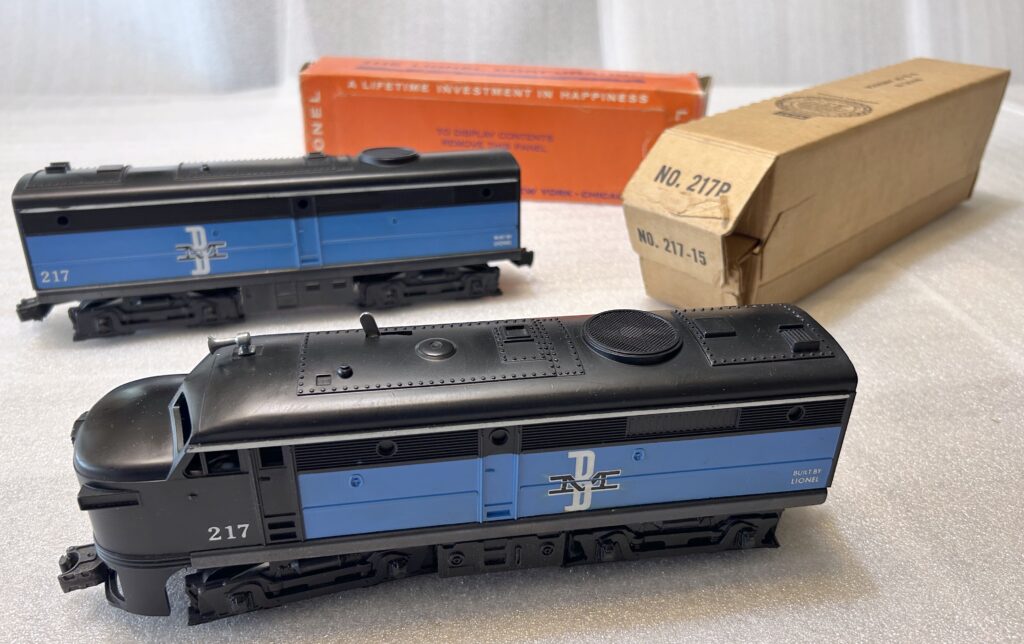
The #217 Boston and Maine Alco AB Diesel Locomotive set with an original #217 power unit cardboard box. Both units of this set have a matching unpainted blue plastic shell. Power unit in this set has the two-axle MagneTration.
Also produced during this one year manufacturing period was the “#226 Boston and Maine” Alco AB Diesel Locomotive and Tender set. Both the power unit and the tender had unpainted blue plastic bodies with their roofs and nose painted black. The power unit had an open pilot with a narrow reinforcing ledge. This alco diesel unit came with an operating horn, operating headlight, non-operating front and rear couplers, a three-position E-unit and the two-axle MagneTration.
The “B & M” heat-stamped logo on both the power unit and tender was of the same design as the logo heat-stamped on the #217 “Boston and Maine” Alco AB Diesel Locomotive set. What is truly fantastic is what is referred to as the “Type III” “#226 Boston and Maine” Alco Diesel set. This variation had an “A Unit” body molded in gray plastic and both the black and blue were painted on the shell! This is an extremely RARE variation and is highly sought after by both collectors and operators. Take a good look at the picture of the molds, A unit in gray and the B unit in Blue below.
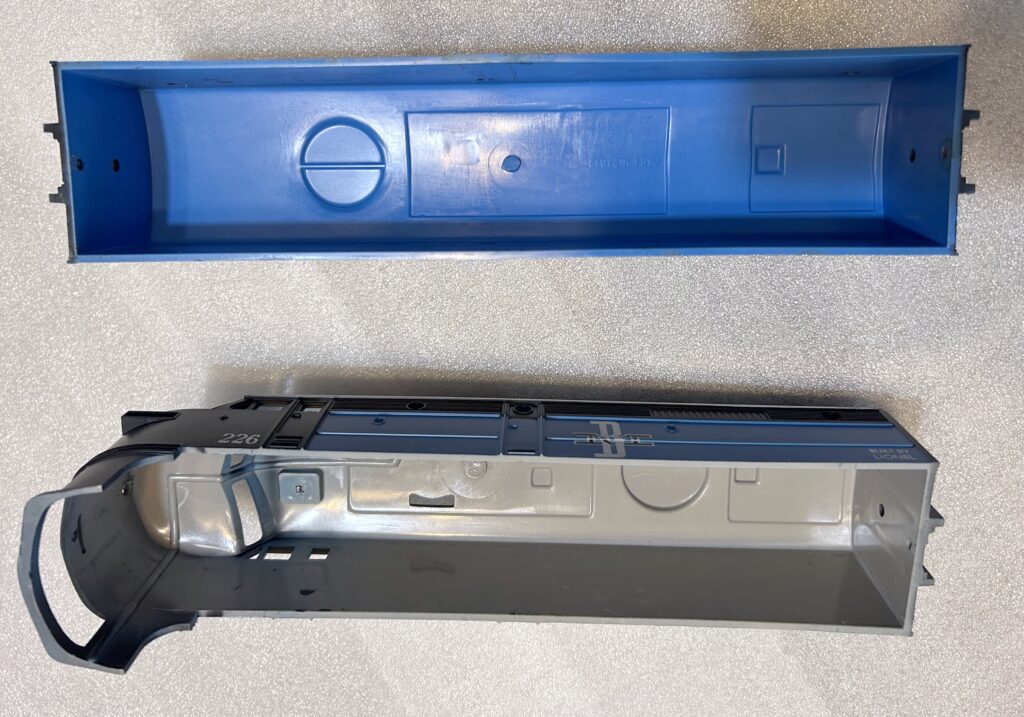
The #226 Boston and Maine Alco “A” unit molded in gray (left shell) and the #226 Boston and Maine Alco “B” unit molded in blue plastic (right shell). Unlike all of the other units, this “A” unit is the ONLY unit having both the blue and black painted on the plastic shell. This is known as the “Type III” #226 Boston and Maine Alco A Diesel unit.)
The final picture is the “#226 Boston and Maine” Alco AB Diesel Locomotive and Tender set is conventionally displayed. In addition, the cardboard #226 power unit original box (and original power unit Lionel sleeve) and the “#226 Boston and Maine” Alco “B” unit diesel tender original box are pictured for your review. Watch at train meets to locate this “#226 Boston and Maine” Alco AB Diesel Locomotive and Tender set, it will become an outstanding addition to your train collection.
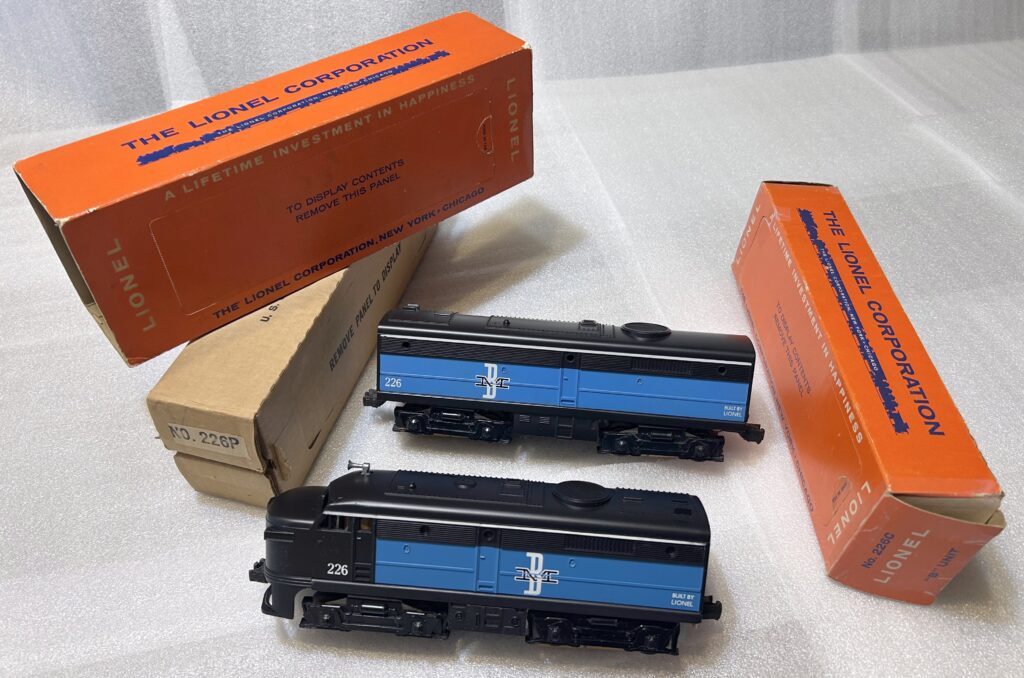
The “#226 Boston and Maine” Alco AB Diesel Locomotive and Tender set displayed with their original Lionel boxes.
December 2024
Welcome to Jerry’s Collectors Corner:
Today’s feature: #6119-125 Rescue Caboose & #6824 U.S.M.C. First Aid Medical Caboose
These two cabooses are truly unique, both are highly desirable to collect and they were uncatalogued by Lionel. There was never an original box made for the #6119-125 Rescue caboose and the original box usually found with the #6824 U.S.M.C. caboose was always an over-stamped “Flat Car With Trailer Van” box.
In 1964, the #6119-125 Rescue Caboose was produced only during this one year. It had a limited run and was sold only thru a set sold exclusively by J.C. Penney. This explains why this rescue caboose is so sought after because it was never offered by any of the traditional train stores offering Lionel trains for sale. This rescue caboose did not have any number stamped on the plastic tool compartment molding or on the plastic cab or on the black metal frame. Both the plastic cab and plastic tool compartment had an unpainted olive drab color and both components had white heat-stamped “+” (crosses) stamped on them. The chemically blackened frame came only with a rubber-stamped white serif “Lionel” lettering and no number on the frame.
Interesting enough, this rescue caboose did NOT have a tool compartment insert, or a white plastic air tanks component nor the traditional two white plastic stretchers with the red cross markings. This rescue caboose came with a short plastic smokejack mounted on the roof. It was equipped with AAR trucks and had only one operating coupler on the front.
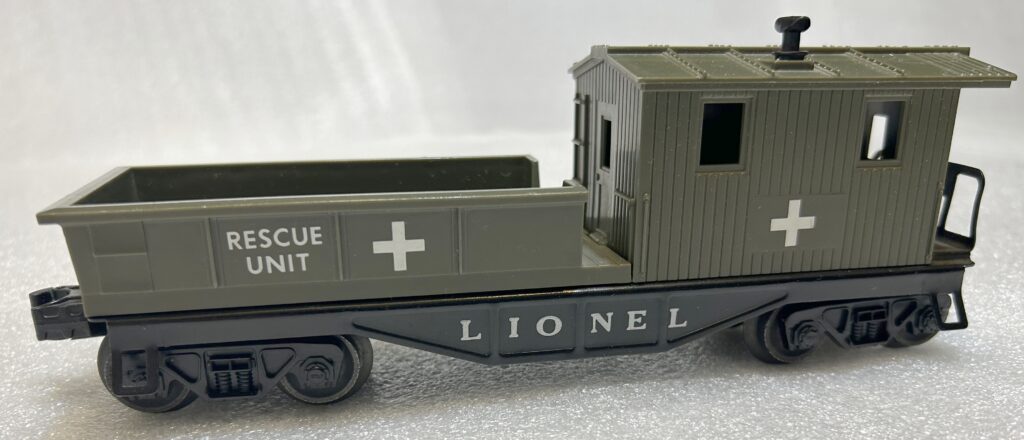
The #6119-125 Rescue Caboose with an unpainted olive drab plastic cab and tool compartment molding both with a heat-stamped “+” on their sides. No number was stamped anywhere on the caboose.
The extremely attractive #6824 U.S.M.C. First Aid Medical Caboose with its heat-stamped cab and tool compartment has a tool compartment insert containing two white stretchers with a heat-stamped red cross on each stretcher, a double white plastic air tank and a blue rubber figure with painted hands and face sitting on the olive drab plastic tool compartment insert. This scarcely found and seldom seen caboose is rare and was produced by Lionel for only one year in 1960. Particular attention should be given to obtaining this caboose that only contains both the unpainted olive drab tool compartment insert, the two heat-stamped original stretchers and the white plastic air tank receptacle.
This medical caboose does have the #6824 heat-stamped on the side of the olive drab plastic tool compartment. It also comes with a short black die-cast smokejack, AAR trucks and a single operating coupler on the front of the caboose.
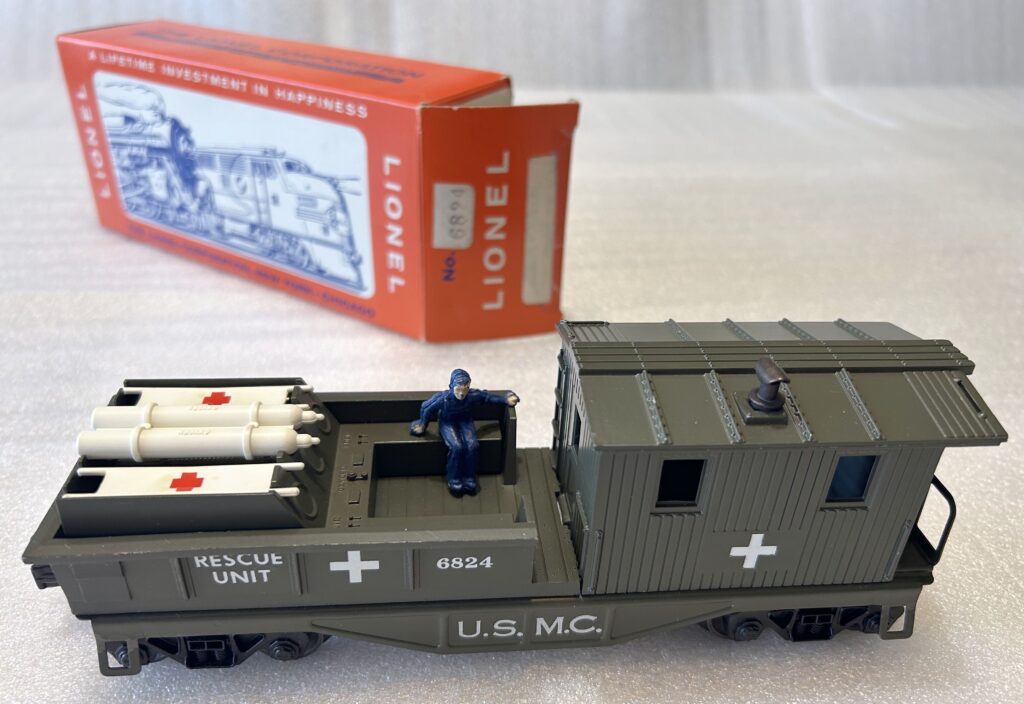
The #6824 U.S.M.C. First Aid Medical Caboose complete with the unpainted plastic olive drab tool compartment insert, with two white plastic stretchers that had a heat-stamped “+” on each stretcher, a double white plastic air tank container and a blue rubber man with painted hands and face sitting on the plastic olive drab tool compartment insert. The original box seen here is an over-stamped #6824 original Lionel box. This over-stamped box was originally a Lionel flat car with trailer vans box.
November 2024
Welcome to Jerry’s Collectors Corner:
Today’s feature: #6814 First Aid Medical Caboose & #6824-50 First Aid Medical Caboose
These first aid medical cabooses are desirable to acquire by both operators and collectors. While they are at first glance appear to be quite similar, they actually have a number of differences. The #6814 First Aid Medical Caboose was produced only for three years by Lionel from 1959 thru 1961. It is also referred to as the #6814 Rescue Unit and/or #6814 Work Caboose.
The sheet-metal frame was always painted a light gray with the “Lionel” name heat-stamped in black with serif lettering on the sides. All of the components on this medical caboose were painted white, which included the enclosed caboose compartment, a tool compartment insert (which is critical to have), two molded plastic stretchers, an original plastic oxygen tank and a blue rubber figure with his left hand extended and holding onto the railing of the white plastic rescue unit.
Especially for collectors, it is important to have as original all of the tool compartment insert, both molded plastic stretchers and the plastic oxygen tank. The two stretchers and the sides of the medical caboose and the side panels of the rescue unit all have red heat-stamping markings. Reproduction stretchers do not have the red heat-stamping markings and for the classification of “new” with this first aid medical caboose, it requires all components to be original and stretchers to have the red heat-stamping “red crosses” markings.
This first aid medical caboose only came with a short smokestack, AAR trucks and only one operating coupler on the front end of the caboose. While this first aid medical caboose is highly desirable to have in your train collection, let me emphasize that it is vital to have all components and all of these components should be original.
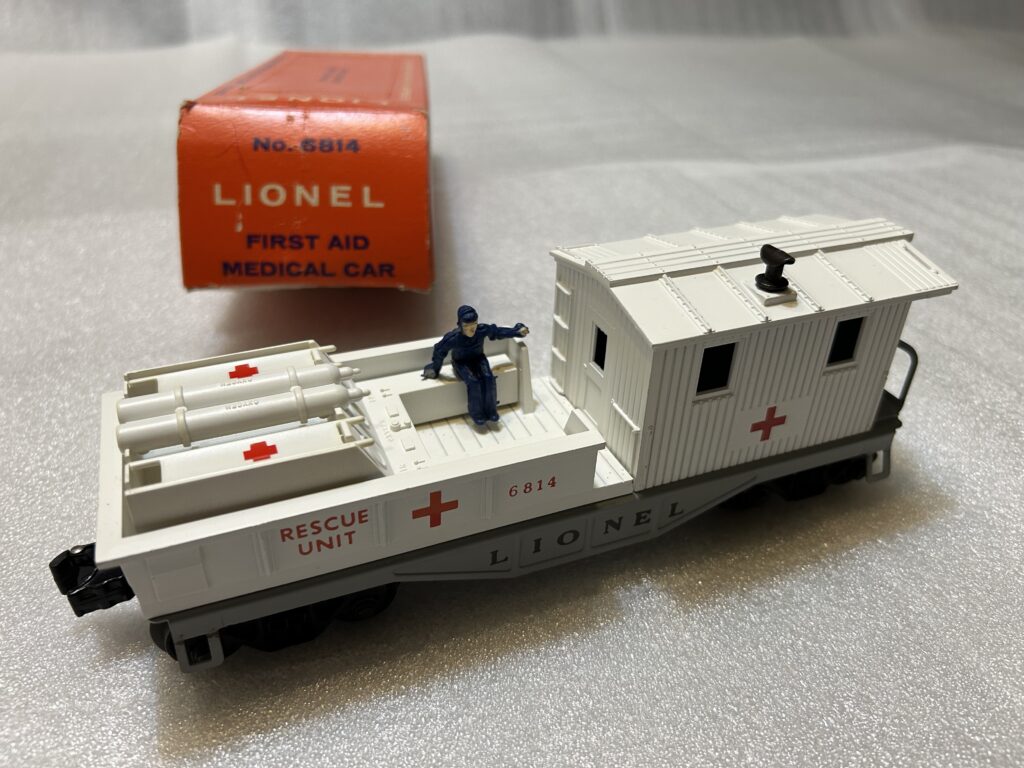
The #6814 First Aid Medical Caboose complete with all original components, tool compartment insert and red heat-stamping of “red crosses” on both original stretchers. Also pictured is the original No. 6814 First Aid Medical Car orange display box with “Push In Tab” attached.
The other sought after medical caboose is the #6824-50 First Aid Medical Caboose. It is extremely RARE and was produced only for one year (1964) and only came in a Sears uncatalogued #9820 train set.
The sheet-metal frame on this caboose was painted black and the “Lionel” name was heat-stamped in white with sans-serif lettering on the sides. This first aid medical caboose did NOT come with a tool compartment insert, no plastic stretchers, no plastic oxygen tank and No blue rubber figure. It has an austere appearance, but since this caboose was only produced one year in an uncatalogued set, it is extremely difficult to locate due to the high demand/limited production to add to your train collection.
This uncatalogued medical caboose also came with a short smokestack, AAR trucks and only one operating coupler on the front end of the caboose.
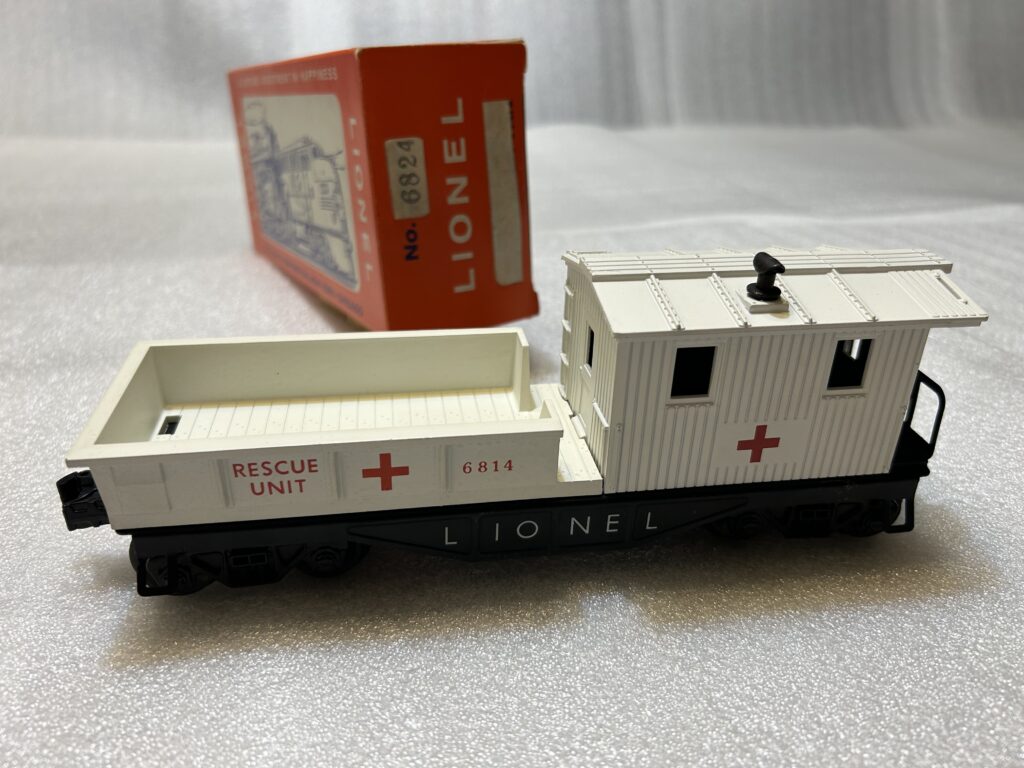
The #6824-50 First Aid Medical Caboose was actually numbered 6814 on the side, but as an uncatalogued medical caboose in the 1964 Sears set it is found with no Lionel box, but infrequently can be located with an original post-stamped Lionel No. 6824 orange box.”
October, 2024
Welcome to Jerry’s Collectors Corner:
Today’s feature: #6800 Flat Car with Airplane and #6800-60 Separate Sale Airplane
One of the delightful flat cars sought by both operators and collectors in the Lionel Postwar era is the #6800 flat car with airplane. The miniature Beechcraft Bonanza airplane came predominately two ways. It had two major variations with a Black top airplane and two major variations with a Yellow top airplane. The problem is that various pricing guides intertwine their description of these #6800 airplane flat cars and this presents confusion for collectors to obtain what I believe are the four major #6800 flat cars with airplane variations. On top of this confusion, these airplanes have been reproduced and even some parts of the same airplane have been found with both original and reproduction parts on the same airplane. I will clearly try to simplify the four major variations to assist both operators and collectors alike to acquire the full set of the 4 major variations of the #6800 Flat Car with airplane.
This miniature flat car with airplane was offered for only four years (1957-1960) during the Postwar era. All 4 of the major variations are available on an unpainted red plastic flatcar. The first of the four major variations, the #6800 Flat Car with Airplane, Type I, has a Beechcraft Bonanza airplane with a black top, yellow propeller and black wings facing outward. This variation has the number “6800” heat stamped in white to the right of the “Lionel” heat stamped lettering in the center of the car. This flat car is equipped with bar-end metal trucks and magnetic couplers. Also, note that the steel mounting plate underneath the plastic flat car is attached to the bottom of the flat car by screws.
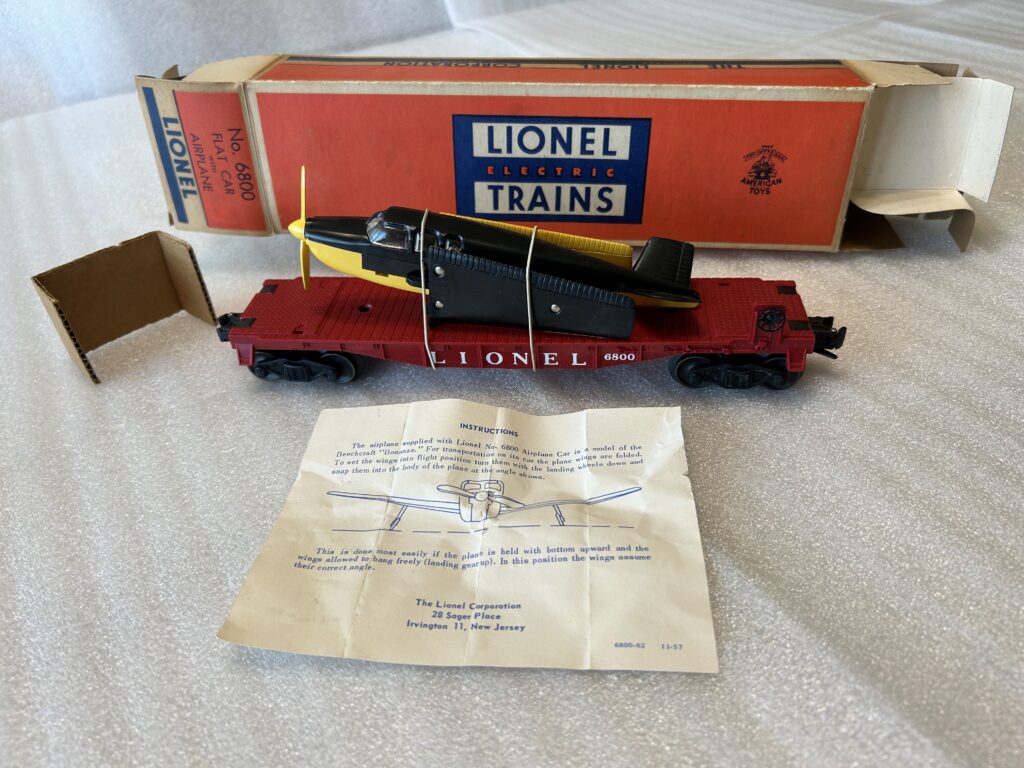
“The #6800 Flat Car with Black top Beechcraft Bonanza airplane, Type I has the number “6800” heat stamped in white to the right of the “Lionel” stamping on the side of the flat car. It come with both bar-end metal trucks and magnetic couplers. The airplane propeller is Yellow and airplane is secured to the red plastic flat car with two plastic elastic bands.”
The second major variation is the #6800 Flat Car with Airplane, Type II (1958). It is identical to the Type I variation except for three ways. First of all, it was assembled with AAR-Trucks, the number “6800” heat stamped in white is to the left of the “Lionel” heat stamped lettering in the center of the car and finally the AAR-Trucks are riveted directly to the 6424-11 frame.
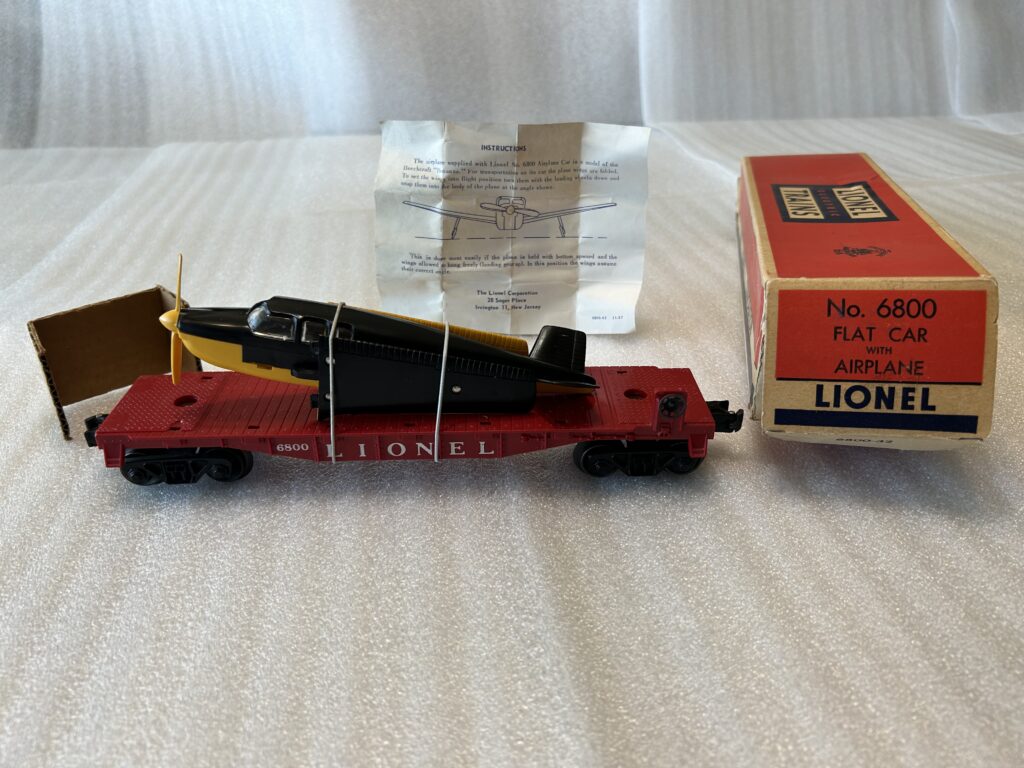
“The #6800 Flat Car with Black top Beechcraft Bonanza airplane, Type II has the number “6800” heat stamped in white to the left of the “Lionel” stamping on the side of the flat car. It was manufactured with AAR-Trucks which are riveted directly to the fame.”
The third and fourth major variations both have a Yellow Top Beechcraft Bonanza airplane on the unpainted red plastic flat car. The #6800 Flat Car with Airplane, Type III with the yellow top Beechcraft Bonanza airplane has a Black propeller, bar-end metal trucks and magnetic couplers. Like the Type I, the number “6800” is heat stamped in white to the right of the “Lionel” heat stamped lettering in the center of the car. Again, the steel mounting plate is attached by screws to the red plastic flat car.
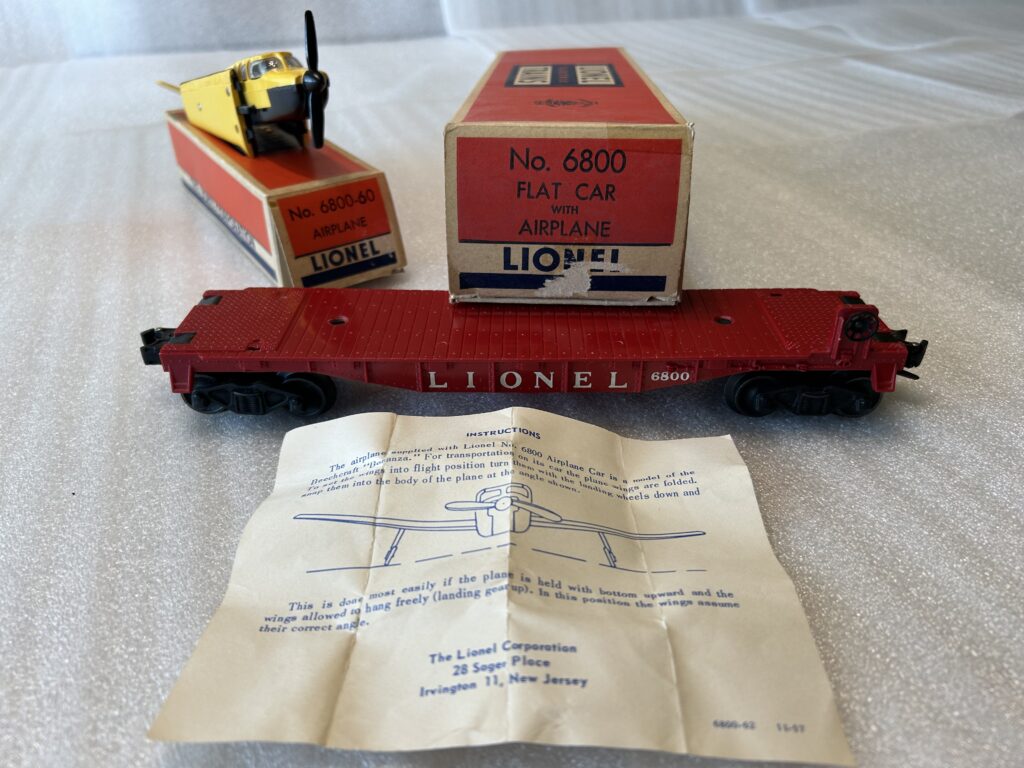
“The #6800 Flat Car with Yellow top Beechcraft Bonanza airplane, Type III has the number “6800” heat stamped in white to the right of the “Lionel” stamping on the side of the flat car. This variation has bar-end metal trucks and magnetic couplers which are attached by screws to the plastic flat car.
Finally, the last major variation is the #6800 Flat Car with Airplane, Type IV and it does come with a yellow top Beechcraft Bonanza airplane with a Black propeller. The number “6800” is heat stamped in white to the left of the “Lionel” heat stamping in the center of the car. This variation has AAR-Trucks which are riveted directly to the 6511-2 red plastic frame.
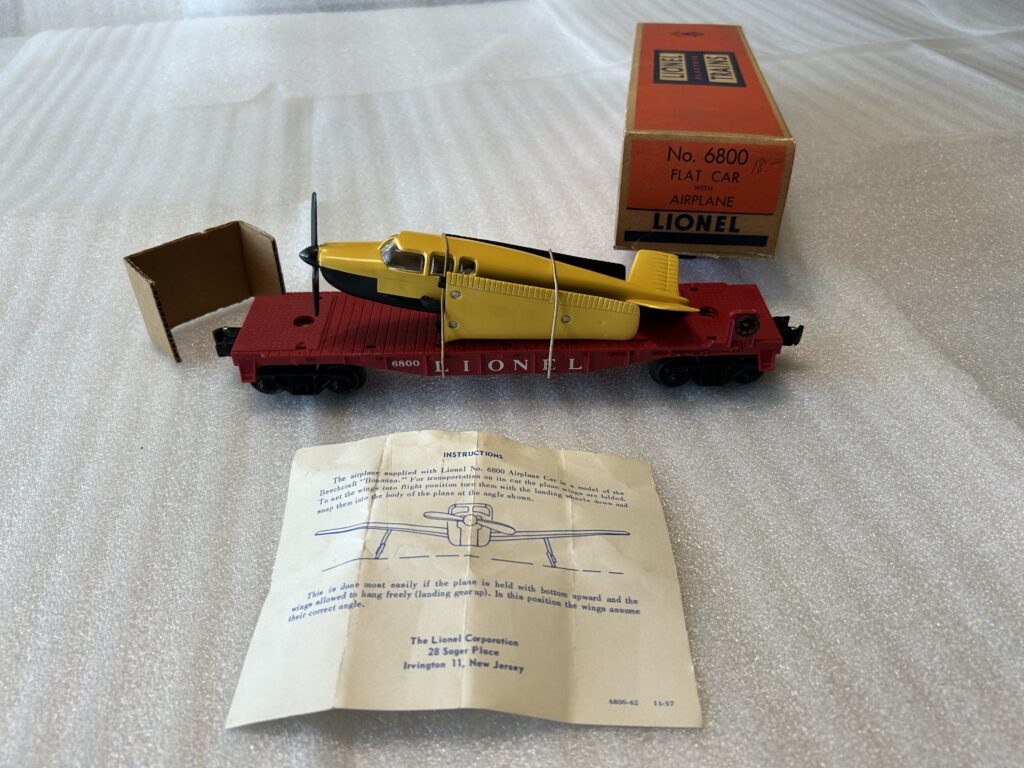
“The #6800 Flat Car with Yellow top Beechcraft Bonanza airplane, Type IV also has the number “6800” heat stamped in white to the left of the “Lionel” stamping on the side of the flat car. This variation has the AAR-Trucks riveted directly to the plastic frame.”
It is important to note that Lionel also produced both the Black top and Yellow top #6800 Beechcraft Bonanza airplane cars sold in separate sale original boxes numbered “6800-60 Airplane”. These separate sale original Lionel airplanes are not easy to come by, so if you find one, you should consider acquiring it and adding it to your collection.
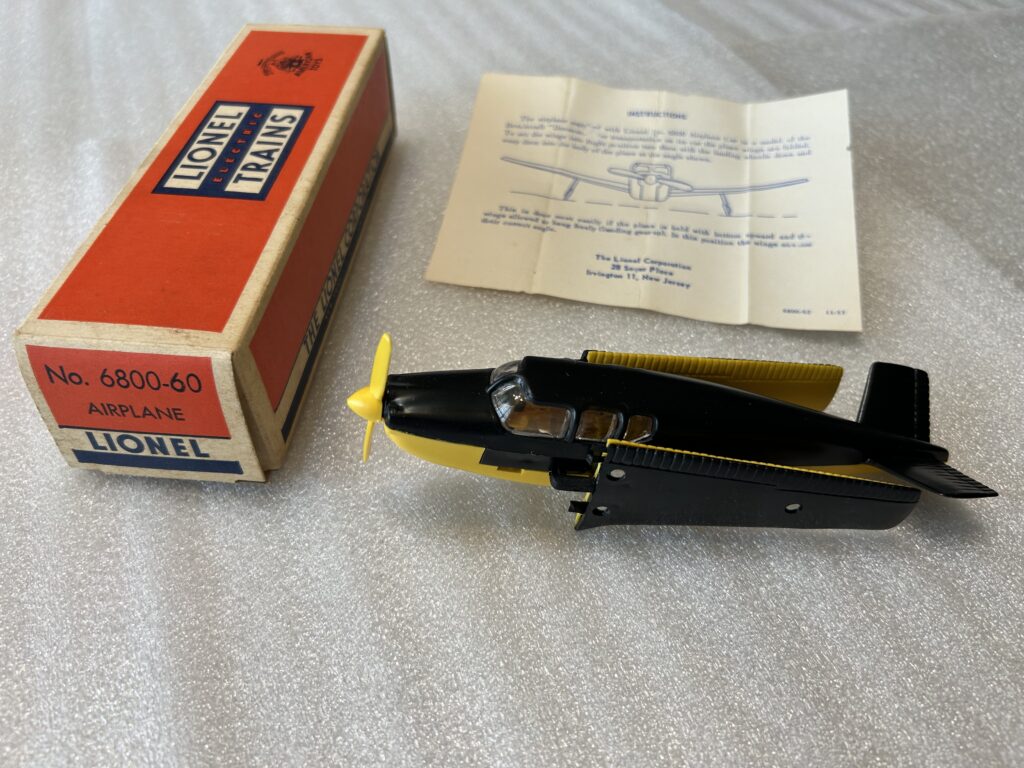
“6800-60 Beechcraft Bonanza airplane in a separate sale Lionel box with a Black top and yellow propeller. This separate sale airplane car is highly desirable to add to your train collection.”
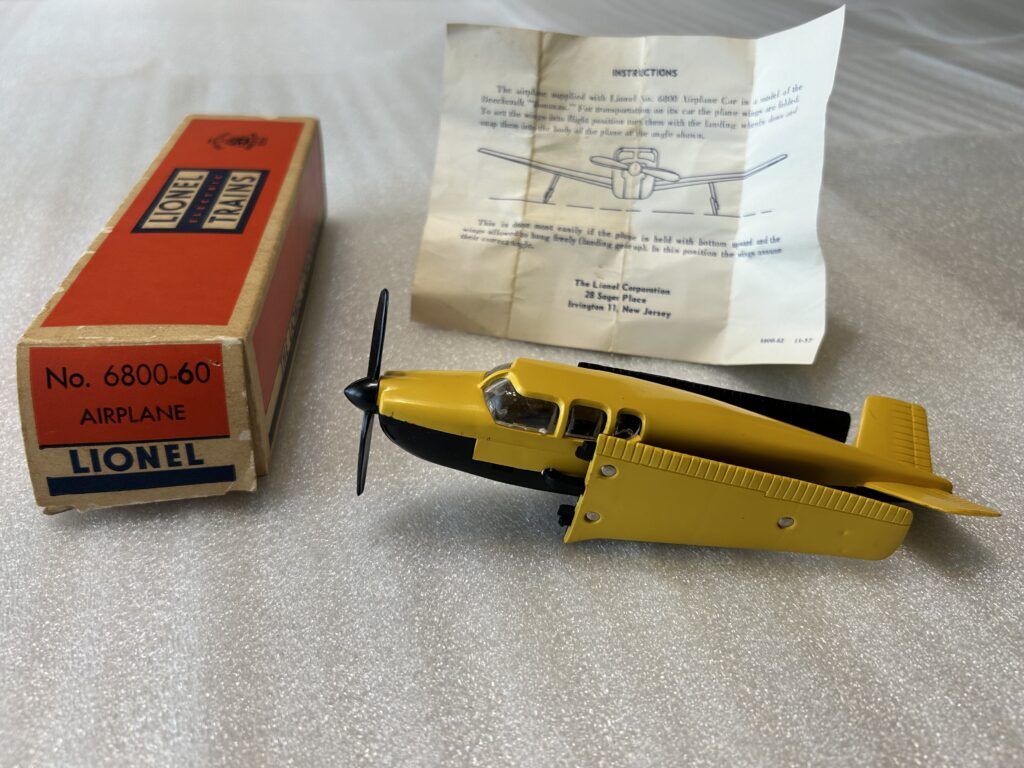
“6800-60 Beechcraft Bonanza airplane in a separate sale Lionel box with a Yellow top and black propeller. Please take note that this particular Yellow top airplane is quite unusual as it is a “Lighter Yellow” and is obviously quite desirable. So, keep an eye out for the RARE variation lighter yellow top airplane to add to your collection. Be patient, when looking for these less common variations, because they are out there!”
September, 2024
Welcome to Jerry’s Collectors Corner:
Today’s feature: #6424, #6424-60, #6424-85, and #6424-110 Automobile Flat Cars
The postwar automobile flat cars were only produced by Lionel for FOUR years (1956-1959), but they are truly a challenge to acquire these various flat cars, particularly with the different colors of these quality cars that were supplied by Lionel. This automobile flat car series only offered their better automobiles with chrome bumpers on the flat cars. These flat cars were sold using two major variations of OB’s to package the sale of these cars.
The first set of twin automobile flat cars are the #6424 and #6424-60 Automobile Flat Cars, Type 1. These automobile flat cars were produced with an unpainted black plastic flat mold #6424-11. Screws secured the black metal mounting plate to the flat car. These Type I automobile flat car always came with bar-end black metal trucks and magnetic couplers. The body had white heat-stamped lettering and the number “6424” was stamped to the right of the “Lionel” lettering. The two chrome bumper cars were a dull bluish green (turquoise color) or many times simply described as a light green auto with chrome bumpers and a yellow auto with chrome bumpers. The two chrome bumper auto cars came in a protective cardboard sleeve. What is different is that this Type I automobile car came in either a #6424 Automobile Flat Car original box or a #6424-60 Automobile Flat car original box.

“The #6424 Automobile Flat Car with two autos, a dull bluish green (turquoise color) auto and a yellow auto both with chrome bumpers and packaged with a protective cardboard sleeve. This Type I #6424 Automobile Flat Car came in either a “6424 Automobile Flat Car” original box or a “6424-60 Automobile Flat Car” original box.”
There is a very desirable second variation of the Automobile Flat Car that uses the same black plastic flat mold #6424-11. It is the #6424-85 Automobile Flat Car, Type l. It is identical to the previously discussed automobile flat car except with two major differences. This #6424-85 Automobile Flat Car came with two autos, a red and a white auto with chrome bumpers. Second difference is that it came in a #6424-85 original Lionel numbered box. It also came with a protective cardboard sleeve for these two autos.

“The #6424-85 Automobile Flat car with two autos, a red and a white auto both with chrome bumpers and packaged with a protective cardboard sleeve. The body had white heat-stamped lettering and the number “6424” was stamped to the right of the “Lionel” lettering. It was produced with an original #6424-85 Automobile Flat Car box.”
It is believed that in either late 1957 or early 1958 that a #6424 Automobile Flat Car, Type II was produced. The only difference between the Type I and Type II was that it came with AAR trucks instead of the original bar-end black metal trucks found with the Type I Automobile Flat Car. This variation is not pictured since that was the only difference between these two types.
The next set of postwar twin automobile flat cars are the #6424 and #6424-60 Automobile Flat Cars, Type III. These automobile flat cars were produced with an unpainted black plastic flat mold #6511-2. The mounting metal plate was riveted to the black plastic flat car. This variation only came with AAR trucks and magnetic couplers. The body had white heat-stamped lettering and the number “6424” was stamped to the left of the “Lionel” lettering. The two chrome bumper cars offered were a dull bluish green (turquoise color) and a yellow auto with chrome bumpers. Both came with a protective cardboard sleeve. This Type III automobile car came in either a #6424 Automobile Flat Car original box or a #6424-60 Automobile Flat car original box.

“The #6424 Automobile Flat Car with two autos, a dull bluish green (turquoise color) and a yellow auto both with chrome bumpers and packaged with a protective cardboard sleeve. The body had white heat-stamped lettering and the number “6424” was stamped to the left of the “Lionel” lettering. The mounting metal plate was riveted to the black plastic flat car. It had only AAR trucks. This Type lll #6424 Automobile Flat Car came in either a “6424 Automobile Flat Car” original box or a “6424-60 Automobile Flat Car” original box.”
There is another variation of the Automobile Flat Car that used the same black plastic flat mold #6511-2. This is the #6424-85 Automobile Flat Car, Type III. It is identical to the previously reviewed automobile flat car except with these two major differences. This #6424-85 Automobile Flat car came with two autos, a red and a white auto with chrome bumpers. The second difference is that it was sold in a #6424-85 original Lionel box. It also came with a protective cardboard sleeve.
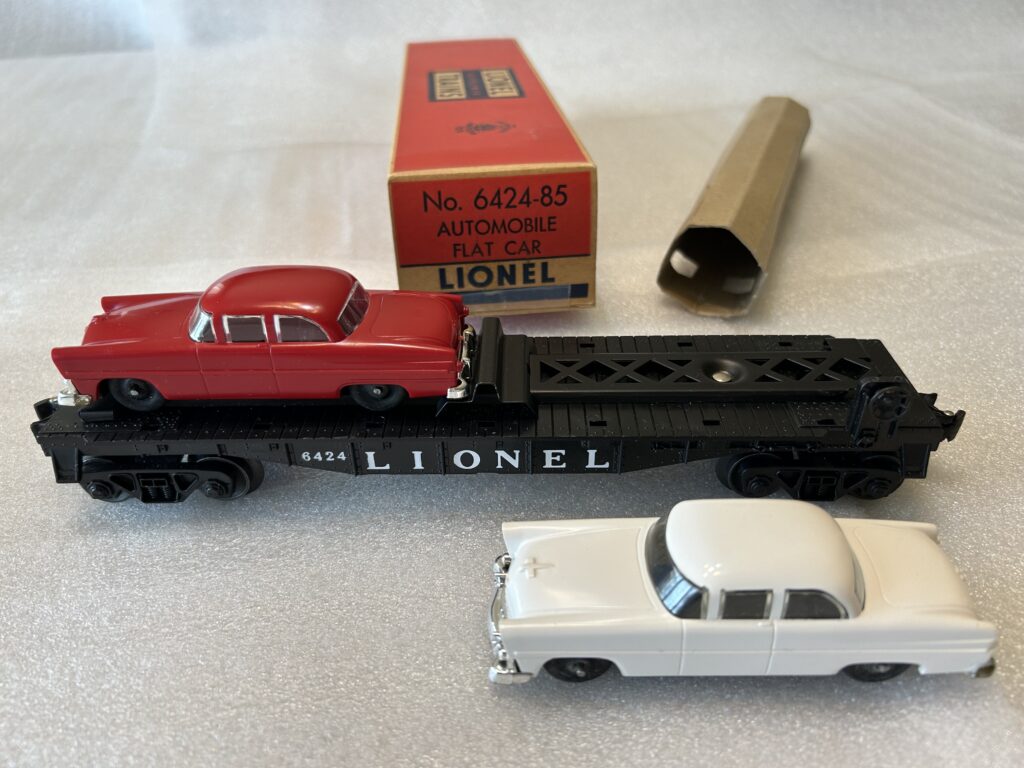
“The #6424-85 Automotive Flat Car with two autos, a red and a white auto with chrome bumpers and packaged with a protective cardboard sleeve. The body had white heat-stamped lettering and the number “6424” was stamped to the left of the “Lionel” lettering. The mounting metal plate was riveted to the black plastic flat car. It also only came with AAR trucks. It was distributed with an original #6424-85 Automotive Flat Car box.”
The last in this series of automobile flat cars is the most desirable and sought after automobile flat car of all. Some even refer to this automobile flat car as the “Holy Grail” of the series. It is the twin flat car #6424-110 Automobile Flat Car, Type lV. This flat car reverted back to using the black plastic mold #6424-11, but contains the unique “Rail Stops” on the top of the black plastic frame. The mounting metal plate was riveted to the black plastic flat car. It had two autos with chrome bumpers, one was a darker yellow color and the second auto was cream color with swirls. It had two operating couplers with AAR trucks. The body had white heat-stamped lettering and the number “6424” was stamped to the left of the “Lionel” lettering. This is an extremely difficult variation of the Automobile Flat cars series to acquire. Finally, this Automobile Flat Car only came in a “6424-110 Automobile Flat Car” Orange Picture Box. This #6424-110 Automobile Flat Car” and original Orange box has a Rarity Rating of an 8. When you find one, be sure to add it to your collection, you will be very happy you did!

“The #6424-110 Automotive Flat Car with two autos, a darker yellow color and a cream color with swirls both with chrome bumpers. Flat car has “Rail Stops” on the top of the black plastic frame and has AAR trucks. The number #6424” is heat-stamped to the left of the “Lionel” lettering. It was distributed only in an “Orange Picture Box” numbered “6424-110 Automobile Flat Car.”
August, 2024
Welcome to Jerry’s Collectors Corner:
Today’s feature: #3366 Operating Circus Car and Corral
One of the most enjoyable, fun and exciting operating cars to run on your layout is the #3366 Operating Circus Car and Corral. The challenge for both operators and collectors alike is to locate a complete operating circus car and corral. It is the single RAREST operating car for the entire postwar period (1946-1969). That is why it is so important to only purchase this operating car when you find it complete.
The first picture shows you the contents envelope and the 11 total items that need to be contained in the envelope. The corral platforms were shipped by Lionel to be set up for “Super-0” and “027” track only. That is why if you have “0” gauge track, then you will have to correct the height of the corral by removing the rubber feet at the four corners of the corral base and replace them upside down. Next in order to use “0” gauge track, you will have to raise the control rails of the OTC contactor by inserting the wire adapters into the OTC contactor. The #36 operating control blade will also have to be placed on one of the two straight track sections of “0” gauge track aligning the front of the circus car corral location on your layout. This will not be difficult to complete this set up since it is easily explained in the instruction sheet that is included in the contents envelope or you can check for a copy of the instruction sheet which is also available in any Lionel operations manual or repair book.

“The “CONTENTS” envelope for the “#3366 Operating Circus Car and Corral” which includes 1 OTC track contactor, 2 adjusting Clips for “0” track, 1 control blade for “Super-0” track, 1 control blade screw, 4 24” connecting wires, 1 #364C controller and 1 instruction sheet.”
The #3366 Operating Circus Car and Corral was offered for sale for only three years (1959-1961). Both the circus car and corral came with an unpainted white plastic body and corral fencing. The circus car had a painted red roofwalk and a matching red heat-stamped lettering on the sides on the circus car. It is critical to search for a circus car that has a pure white appearance as the molded Lionel circus cars (like the motorized #59 Air Force switchers) tended to yellow. The whiter the circus car and corral plastic is found, the more desirable they are to both collectors and operators to own. Pure white circus cars and corrals will bring a premium in their price. Be patient, add this circus car and corral when you locate a pure white plastic one which comes complete for set up on your layout.
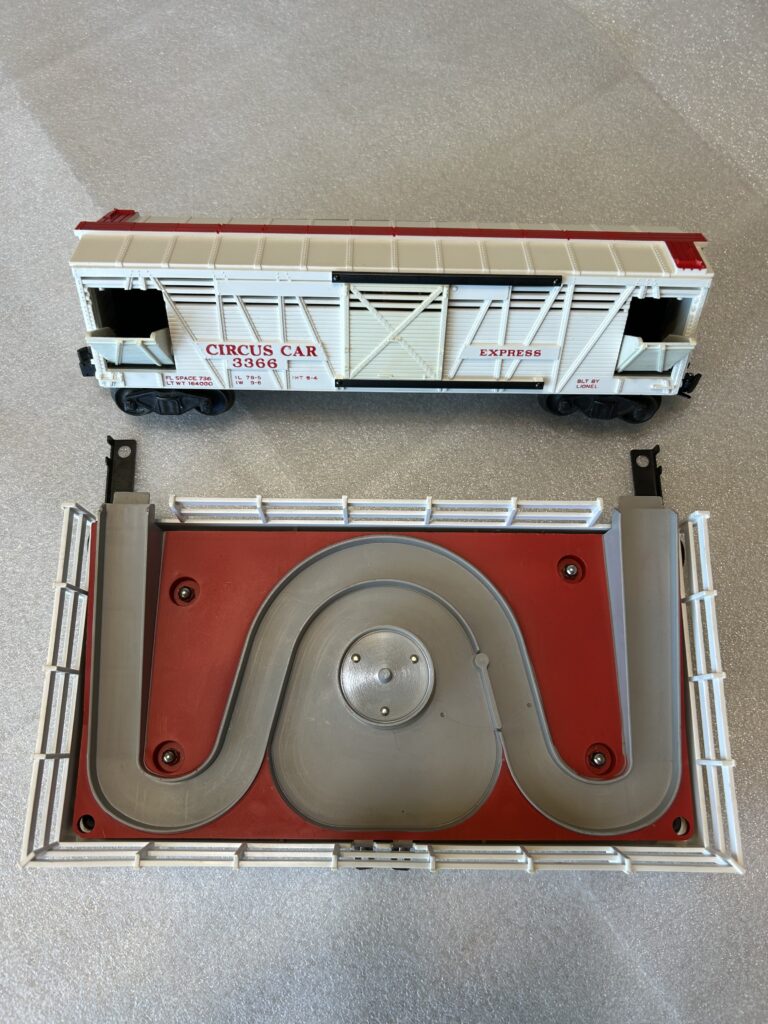
“Pure white plastic #3366 operating circus car and corral always command a premium price.”
Finally, it is critical to also locate the circus car and corral with an original Lionel box No. 3366-100 FIGURES FOR THE No. 3366 CIRCUS CAR. This OB set comes with NINE white rubber horses. It is worth it to have a complete original circus car and corral set because when the are operating on your layout, it brings a lot of attention and many “smiles” by everyone watching its operation.
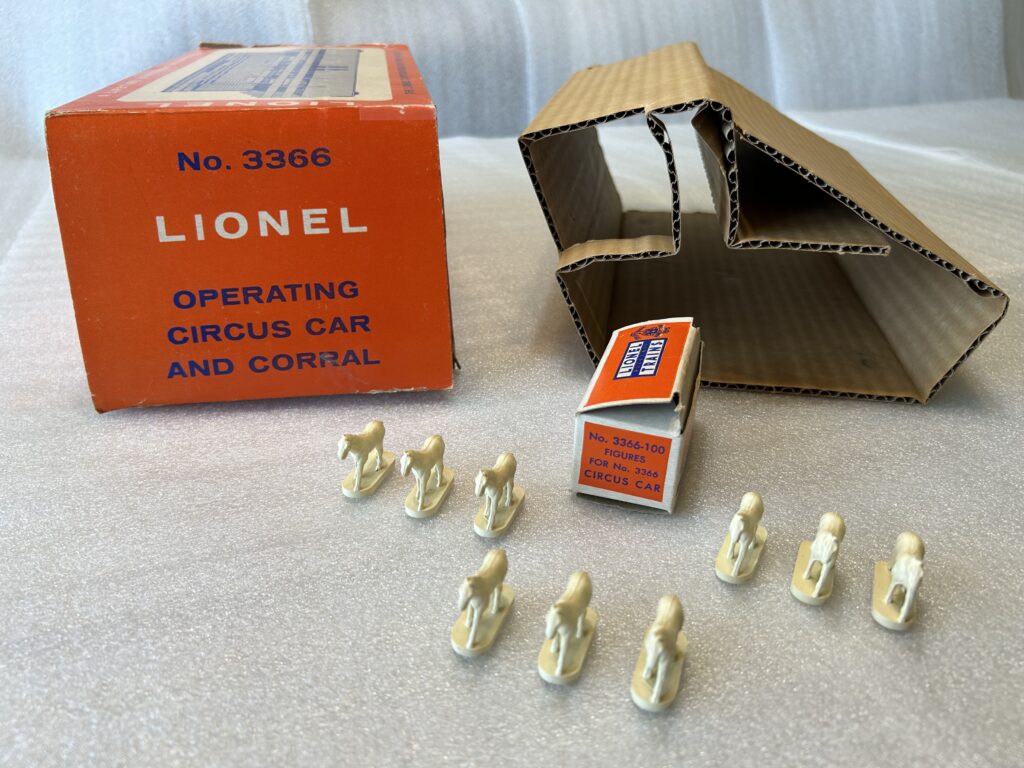
“An original Lionel #3366 Operating Circus car and corral box, cardboard liner and #3366-100 original Lionel box with 9 rubber horses for the #3366 Circus Car.’
July, 2024
Welcome to Jerry’s Collectors Corner:
Today’s Feature: #685 Steam Locomotive, 4-6-4
A very desirable 4-6-4 Hudson locomotive to acquire is the #685 Steam Locomotive which was produced for ONLY one year in 1953. It is worth noting that this particular Hudson had a “Santa Fe” type styled boiler casting that was similar to the boiler castings of the #665, #2055 and the #2065 steam locomotives.
There were only two types of this steam locomotive produced during its only one year of production. The #685 Steam Locomotive, 4-6-4, Type I had its engine number rubber-stamped in white lettering and it is estimated that this composed less than half of all of these steam locomotives manufactured. This locomotive had a die-cast body that came with both MagneTraction, smoke and an operating headlight. In fact, the Lionel original box that this steam locomotive came in listed the “Locomotive With Smoke Chamber” on both end flaps. Obviously, Lionel was marketing this steam locomotive to the operators because of the excellent smoke that puffed out of the smoke chamber. Another appeal to the operators with this steam locomotive was the fact that this engine had both the main and side rods operating on the side and it made it appear to have an operating value gear to provide the action as the locomotive traversed down the train tracks. This action offered a lot of appeal and excitement for operators running this steam locomotive down their layout.
Finally, this steam locomotive only came with the #6026W Santa Fe-type tender which had white rubber-stamped “Lionel Lines” lettering on it.
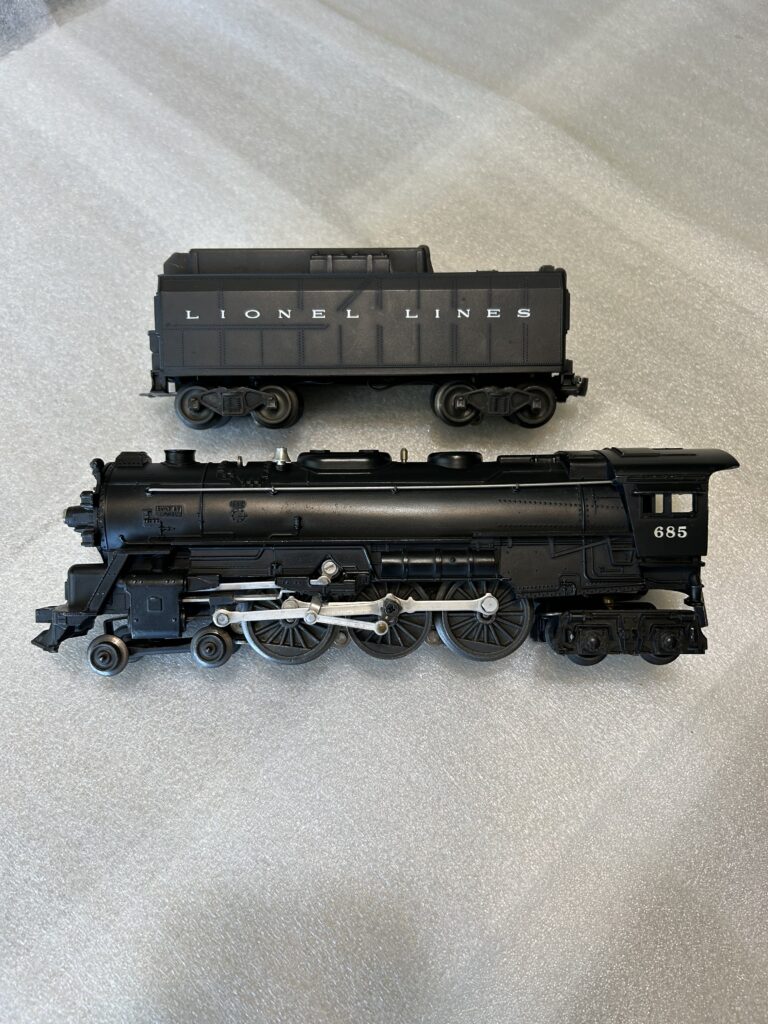
“#685 Steam Locomotive, 4-6-4 with white rubber-stamped number on engine cab and “Lionel Lines” also rubber stamped on the #6026W Santa Fe-type tender.”
The #685 Steam Locomotive, 4-6-4, Type II had the engine number hot-stamped in white lettering on the cab. This was a powerful pulling engine and has a lot of appeal to run a number of cars in a train set when operated. The engine’s direction was controlled by a three-position E-unit. When this engine and a set of cars was operated on a train layout, it created a lot of interest because of the operation of the main and side rods with the moving value gear on the side. This fully action packed engine was a favorite of many operators and brought a lot of attention by everyone viewing its operation on a layout. Again, the MagneTraction was a huge factor in its appeal and successful operation.
As you will see in the following picture, a complete #685 Steam Locomotive and its #6026W tender with white hot-stamped lettering comes with original Lionel boxes, cardboard inserts, instruction sheet, a bottle of smoke pills and a wooden compressor for the smoke stack. The rarity rating for a quality and complete #685 Steam Locomotive and tender with quality original Lionel boxes is in the area of a 6+ rating. Good luck in your hunt for a quality #685 engine and tender, it is worth it when you find a complete and high quality pair!
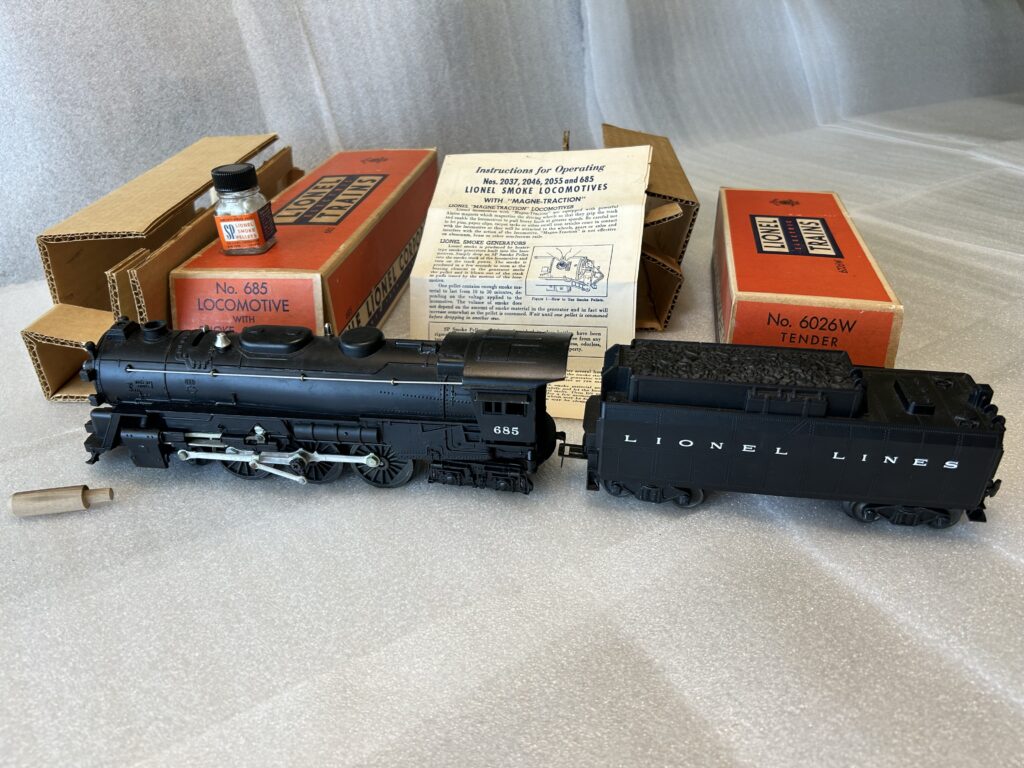
“#685 Steam Locomotive, 4-6-4 with white hot-stamped number on engine cab and the “Lionel Lines” tender #6026W was also hot stamped in white lettering.”
June, 2024
Welcome to Jerry’s Collectors Corner:
Today’s Feature: #58 Great Northern Rotary Snow Plow and #59 U.S. Air Force Minuteman Switcher
Both Postwar train operators and collectors have their favorite rolling stock on their layouts to operate and/or collect. My personal favorites are the motorized units manufactured during the 24 years of the Lionel Postwar period. Two of the unique and exciting motorized units to operate are the #58 Great Northern Rotary Snow Plow and the #59 U.S. Air Force Minuteman Switcher.
The #58 Great Northern Rotary Snow Plow was offered for sale for only three years from 1959 to 1961. This is truly one of the most interesting and enjoyable motorized units to run on your layout. The snow blower on the front always grabs everyone’s attention when operated on a train layout. The unique operating rotation of the snow blower’s blades is definitely an attention grabber for all model train layout viewers. These snow roller blades create quite a seen on your layout track and most often ignites many comments from everyone viewing its operation.
The #58 snow blower has an unpainted plastic green body with white painted cab sides and green hot-stamped lettering of the “Great Northern Railway” logo on both sides of the cab. This motorized unit is considered moderately RARE, but most importantly you want to find and collect the #58 rotary snow plow that has window struts (on both sides of the cab) that are neither broken or don’t even have a hairline crack. Finding a rotary snow blower with both “PERFECT STRUTS” on both sides of the cab is the challenge to collecting this highly desirable motorized unit. Be patient, it is well worth the wait to purchase this snow plow until you find one with great unbroken struts. Once you obtain your rotary snow plow, you know you will have lots of fun operating the motorized unit and it will bring joy to everyone viewing your layout operation.
The metal railings on both sides are painted white and this unit has an operating coupler on the rear in order for this snow plow to be able to pull a small load of train cars.
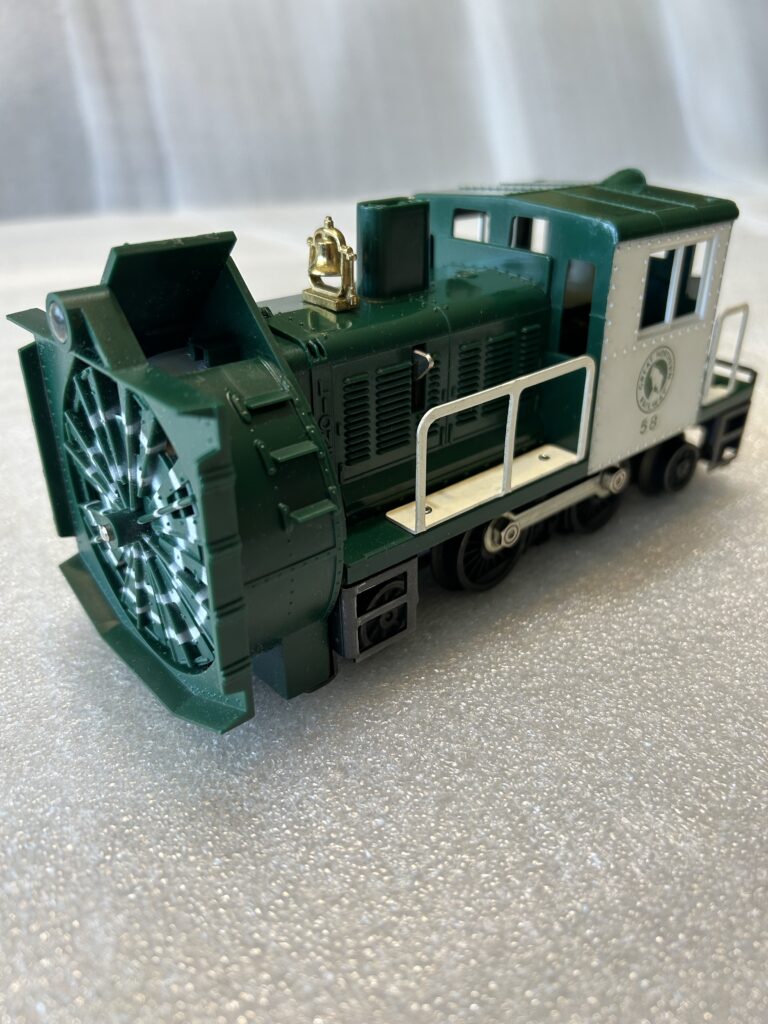
“#58 Great Northern Rotary Snow Plow with the rotary snow blower located on the front. It has an unpainted green plastic shell with green heat-stamped lettering over white painted cab sides.”
Next is the highly attractive and desirable #59 U.S. Air Force Minuteman Switcher which was only sold for two years from 1962 to 1963. This gas turbine switcher was a motorized unit with a 2-4-2 truck alignment. The shell was an unpainted white plastic that came with a red and blue heat-stamped “Minuteman” and “U.S. Air Force lettering. In addition, the two cab sides also had a red and blue Air Force symbol heat-stamped on both sides of the white plastic cab sides.
There was an ornamental bell in the center top of the cab and it also had metal hand rails painted white on the sides. In addition, this motorized unit had operating couplers installed on both ends and it had a three-position E-unit used for directional control. As mentioned before, the cab was a white unpainted plastic, but most often yellowed with time. The “whiter” the actual plastic cab appears truly makes a difference. Another words, the more purely white the plastic cab appears to be, the higher the value of the motorized unit and also much harder to find. If you come across a purely white plastic cab, that is RARE and be sure to obtain it to add to your collection. This would be a smart acquisition for your train collection.
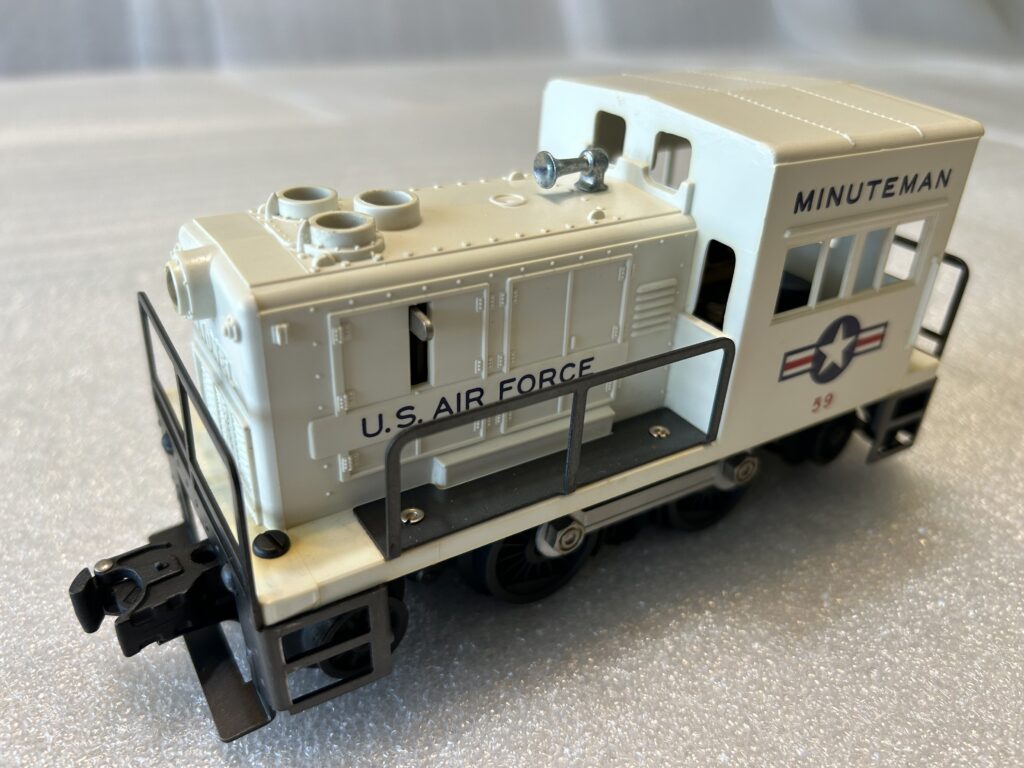
“#59 U.S. Air Force Minuteman Switcher with an unpainted white plastic shell. It has blue heat-stamped lettering and features a red and blue Air Force symbol also heat-stamped on the cab sides.”
Lastly, both of these motorized units are highly desirable to operate and collect. They are a challenge to find in a quality condition. Only purchase these motorized units if they have both unbroken struts (including no hair line cracks) on both sides of the cab. (The reason this is so difficult is that many children and inexperienced operators pick up these motorized units by placing their fingers over the struts and immediately breaking them when picking up the motorized unit.) The original boxes for these motorized units are difficult to find. Also, collecting the OB’s in good condition truly adds to the value of these motorized units.

“Quality #58 and #59 original boxes and their respective different cardboard liners and an inspection slip and a tube of lubricant. Try to collect these motorized units with their original Lionel train boxes.”
May, 2024
Welcome to Jerry’s Collectors Corner:
Today’s Feature: #264 Operating Fork Lift and #415 Diesel Fueling Station Accessories
Two of Lionel’s favorite operating accessories for layouts are the #264 Operating Fork Lift and the #415 Diesel Fueling Station. Both of these operating accessories add a lot of action, vitality and liveliness to operating a train layout.
The uniqueness of the operating fork life adds a tremendous amount of attention by all spectators as they view an operating layout. When the forklift actually grabs the timber and moves it from the platform to the operating lumber flat car, almost everyone watching comments out loud and expresses their delight when seeing the fork lift operating on a layout. In fact, the operating fork lift is my personal favorite Lionel operating accessory!

“The #264 Operating Fork Life actually lifting a timber and just about ready to place the timber of the #6264 Lumber flat car.”
The action pack operating fork lift car often is continuously watched as several timbers are lifted from the stationary platform onto the lumber car sitting on the operating track layout. Here is another view of the operating fork lift car situated on an operating layout ready for action.
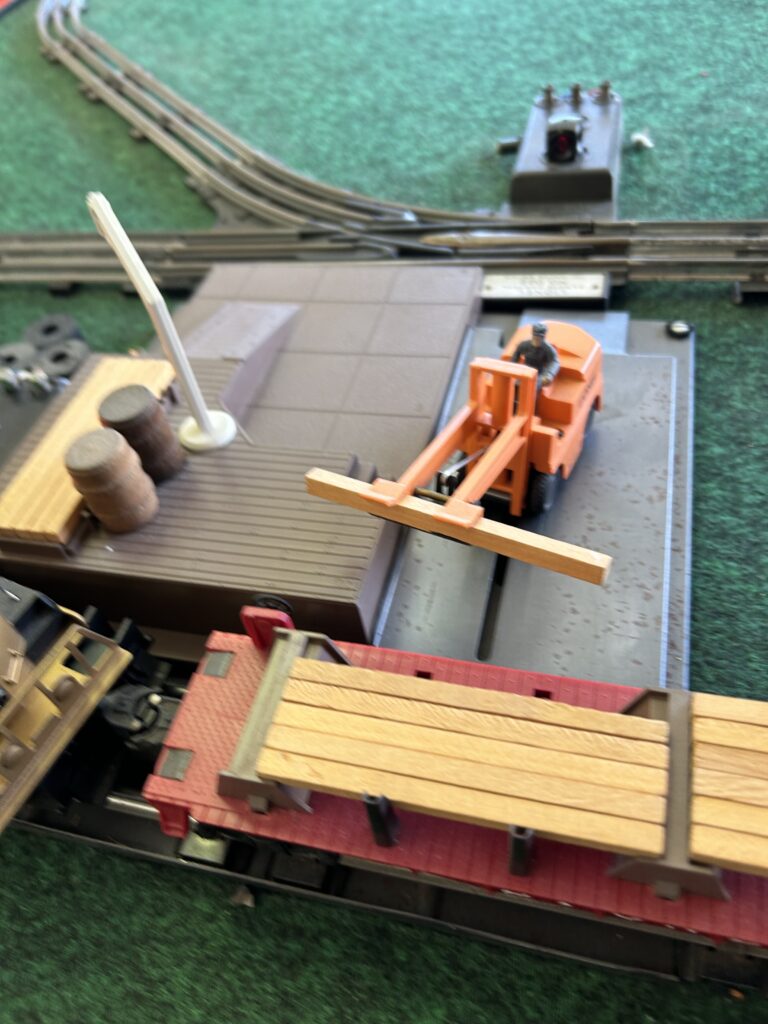
“Over view of #264 operating fork lift ready to transport timber from stationary platform to the #6264 lumber flat car on a traditional operating train layout.”
The location for placing these two Lionel operating accessories on a train layout is a decision that will be made by each operator when building their own train layout. As you will see, on my personal train layout I have placed these two exciting operating accessories next to one another. This has created an impact when operating my trains and the action definitely draws the attention of everyone in the room watching either or both of these operating accessories. The fork lift continuous action is an “attention grabber” and the diesel fueling station man running out to meet the train truly enhances the action on your layout. As you know, the #415 diesel fueling station is also illuminating and draws attention on you layout as well.
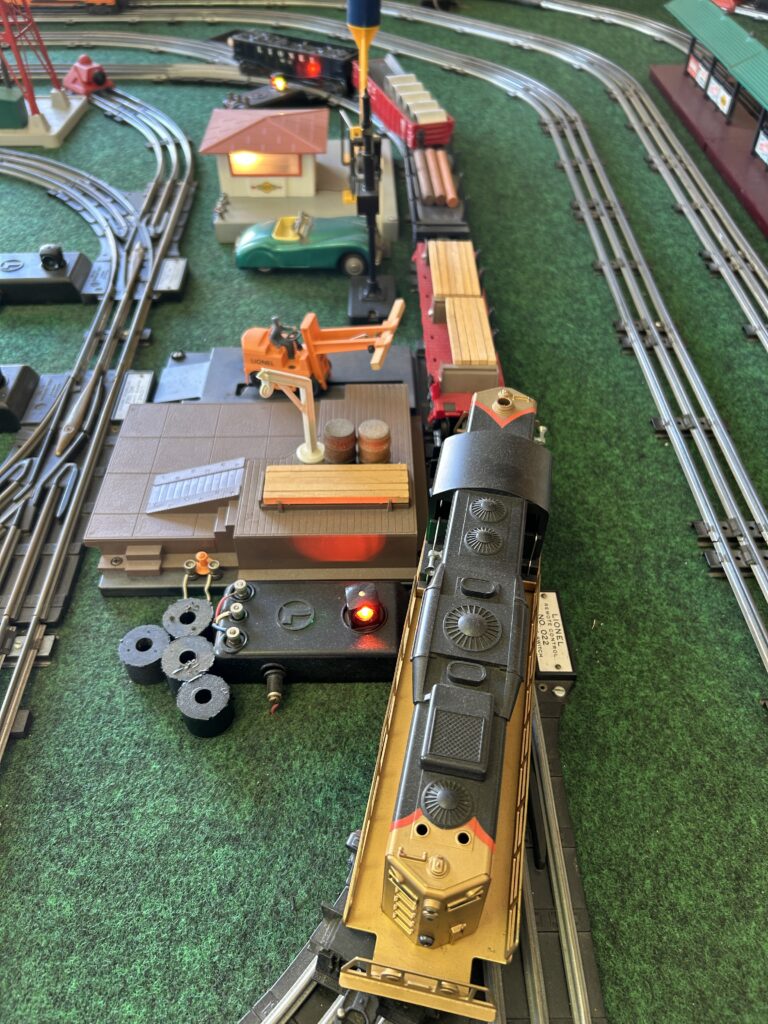
“#264 operating fork lift moving timbers from the lumber platform onto the #6264 Lumber flat car while the illuminated #415 Diesel Fueling station draws attention itself along side of the train tracks. This is especially true when operating you layout at night.”
Here are two pictures of the #415 Diesel Fueling station on my layout. First picture below shows the attractiveness of the fueling station situated on a layout and the second picture shows the train man ready to run out to meet the train on the layout and the brightness of the illumination of the fueling station on the layout.

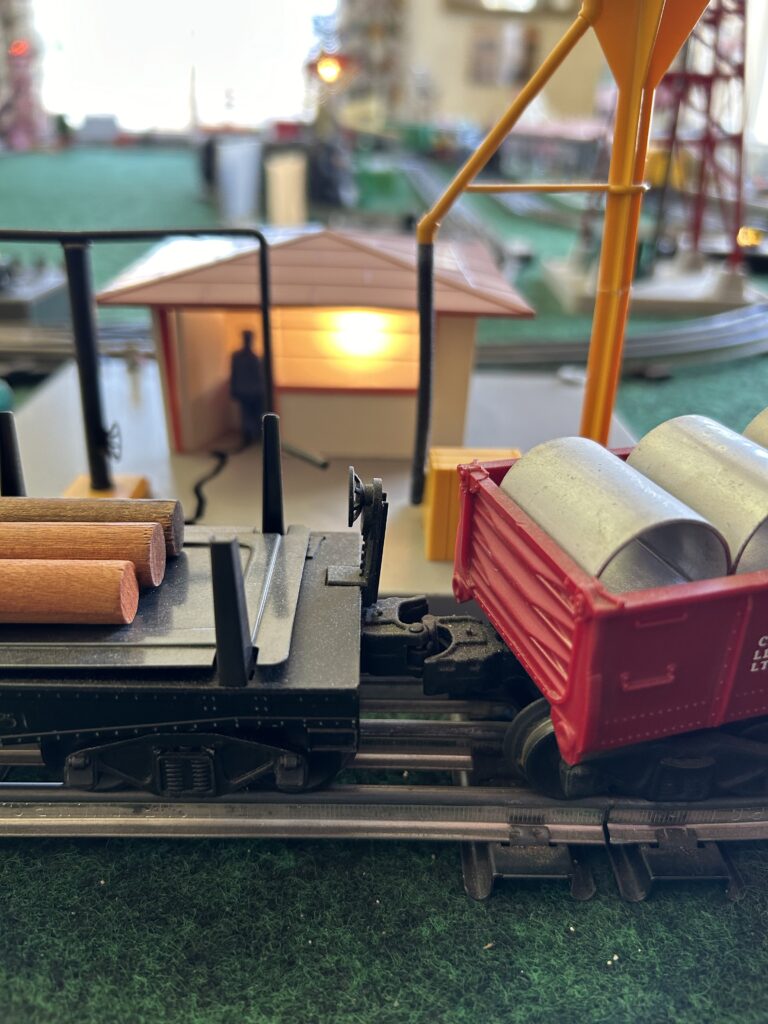
“Locating the operating diesel fueling station on your train layout and a close up look of the diesel fueling station from ground level of the train layout and viewing the powerful illumination coming from the fueling station on the layout.”
Lastly, I hope when you are searching to obtain these two operating accessories, you will be able to find them in their original carboard master cartons and with their individual instruction sheets. Happy hunting for these operating train accessories, as I know you will enjoy their operation on your layout as much as I have on my operating train layout.
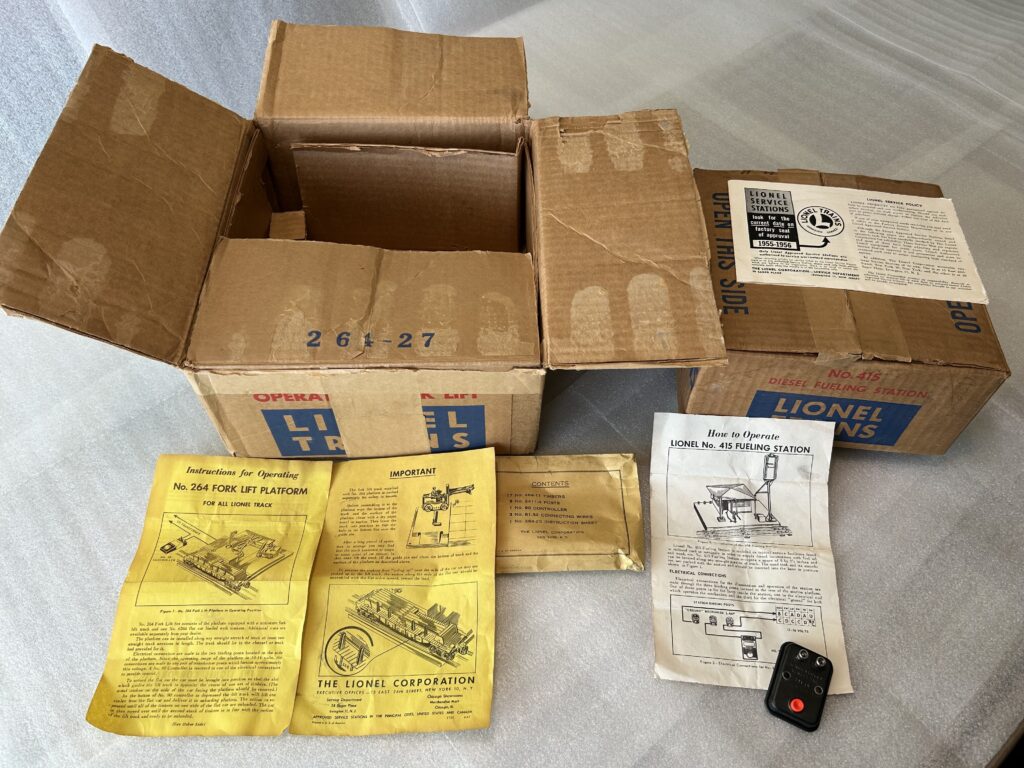
“The #264 Operating Fork Life master carton (with inserts) and the #415 Operating master carton and their individual instructional sheets.”
April, 2024
Welcome to Jerry’s Collectors Corner:
Today’s Feature: #2367 Wabash F3 Diesels
Both Type I and Type II of the #2367 Wabash F3 Diesels are highly desirable to acquire for your collection. However, the Type I is extraordinarily RARE! There are some distinguishing characteristics for these two types of diesels and both collectors and operators need to know how to spot these variations. This is extremely important as these F3’s could mistakenly be mismatched with the dummy unit of the #2240 Wabash diesel which may wind up being placed incorrectly with the A unit of the Type I #2367 Wabash diesel.
These #2367 Wabash diesels were offered for sale for only two years (1955 and 1956) and the Type I was manufactured in 1955 only. The locomotive bodies for both types were made of a royal blue plastic with the A unit painted blue while the shell of the B unit always had the blue plastic area left unpainted. In both situations, the roofs and upper bodies of both units of these diesels were painted gray. Here is the critical difference: the B unit of the Type I had rubber stamped lettering while the B unit of the Type II always had heat-stamped lettering.
Both types had a silk-screened white band on the lower side panels and both types also have a thin white stripe which was similarly applied to the center of the sides on both types and was interrupted by the molded-in details. Here is the critical difference: the B unit of the Type I had the “BUILT BY/LIONEL” rubber stamped on the same end of both sides of the shell while the B unit of the Type II had the “BUILT BY/LIONEL” heat-stamped on the opposite ends of the B unit shell.
These diesels had dual vertical mounted motors to power the locomotives, an operating headlight, and both came with Magnetraction. Obviously, operators were thrilled to run these powerful diesels because their operation allowed longer train sets to be employed with maximum efficiency to operate them.
Finally, the #2367 Wabash diesels had integral cab door ladders, closed portholes on the sides, louvered roof vents and a “Wabash Flag” herald placed on the nose using a water-slide decal.

“The #2367 Wabash F3 Diesel, Type I with a rubber stamped B Unit lettering and the “BUILT BY/LIONEL” stamped on the same end of both sides of the shell.”

“The #2367 Wabash F3 Diesel, Type II with the heat-stamped B Unit lettering and the “BUILD BY/LIONEL” stamped on the opposite ends of the B unit shell.”
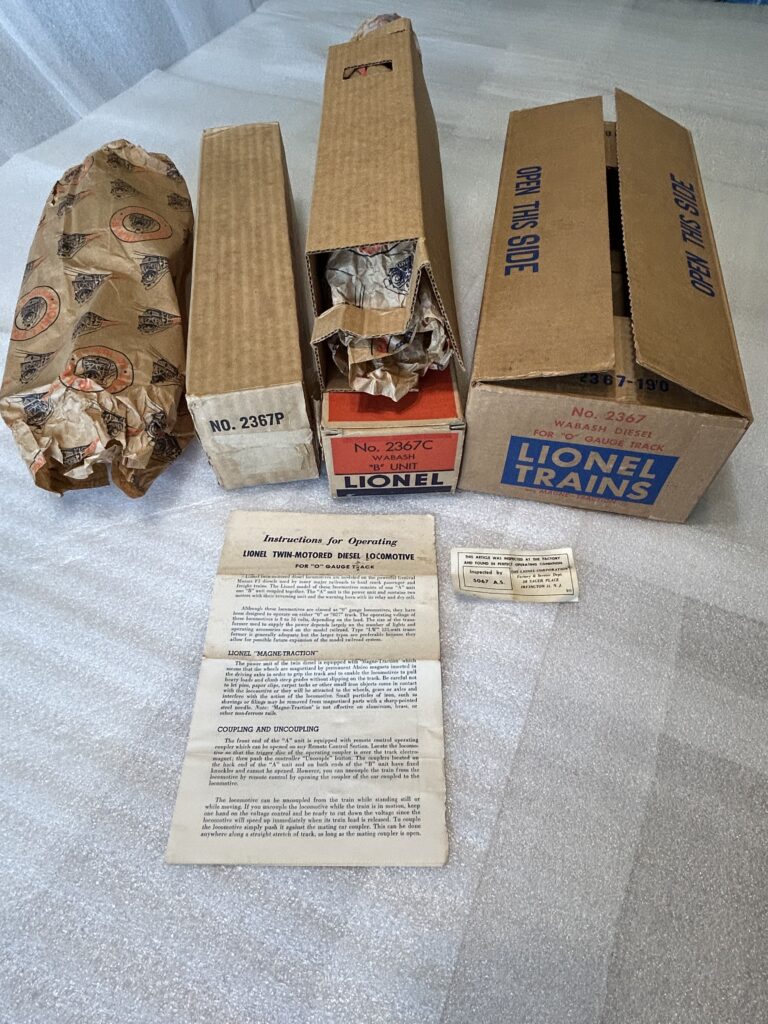
“Both Type I and Type II #2367 Wabash F3 diesels came with master cartons, individual A and B Unit original boxes, liner, factory wrap paper, instruction sheets and a packing slip.”
Finally, I believe it is critical to note the difference in the dummy B units for both #2367 Wabash diesel and #2240 Wabash diesel. This difference needs to be carefully understood and noted so you don’t accidently obtain or purchase a Wabash diesel set that has a mismatch. The dummy B units differ when you carefully examine the thin white stripe on the dummy B unit. Check the length of the final segment of the thin white stripe (near the “BUILT BY/LIONEL” marking). On the #2367 Wabash B Unit the length of the thin white line is ONLY 1/8 inch long. On the #2240 Wabash B Unit the length of the thin white line is 1/2 inch long. This is the only difference between these dummy B units and this is why it is so easy to have them switched or mixed up. This distinction is important to remember in order to protect yourself when acquiring the #2367 Wabash diesel set.

“The #2367 Wabash dummy B Unit (top unit) has a thin white line of ONLY 1/8 inch long. The #2240 Wabash dummy B Unit (bottom unit) has a thin white line 1/2 inch long.”
March, 2024
Welcome to Jerry’s Collectors Corner:
Today’s Feature: #11183 Lincoln Funeral Train, Part II
My previous article featured both the three car Lincoln Funeral Train (#11183) plus the special “Add-on 2-Pack” 19th Century Passenger cars set (#25631) to go with the original 3 car Lincoln Funeral Train set. In this article, I will be featuring a unique way to display this combine 5 car funeral train set as well as focusing on some of the memorabilia that is available to display with the Lincoln Funeral Train set in your train room.
The traditional or common way to display trains in either your train room or in your home is to place the trains on display on shelves mounted on your walls. This usually finds many trains fully displayed on your walls and truly does not give emphasis or focus for one individual set or group of trains. While there is nothing wrong with this traditional way of displaying the model trains, I would like to offer a different way to display the 5-car Lincoln Funeral Train in your train room or home. Consider placing the Lincoln Funeral train on a large wide shelf which would include both the 3-car funeral train and the 2-car passenger add on set and allow plenty of space to include a variety of memorabilia on the shelf. What I have found that is particularly outstanding about this combine 5-car set is the truly historic attention to details, authenticity and realistic accuracy that Lionel made in manufacturing this 5-car set. The colorful detailing of the funeral train engine with the many different colors of red, white, blue, yellow, gray, green and black are both beautiful and historically accurate. The tender displaying the many core wood stacks along with the colorfully decorated tender in green, red and gold is a beautiful sight to behold. Also, the 19th century passenger cars are artfully designed with the gold inlay side panels, exquisitely golden designed truck coverings, the silver bells and stars on the side of the passenger cars panels as well as the skillfully enhancement of the bunting on the side of the passenger cars. Also, the replica of the “Philadelphia, Wilmington & Baltimore R.R.” golden plaque is gorgeous. In my opinion, Lionel paid huge attention to detail and historic accuracy when manufacturing these passenger cars for the funeral train.
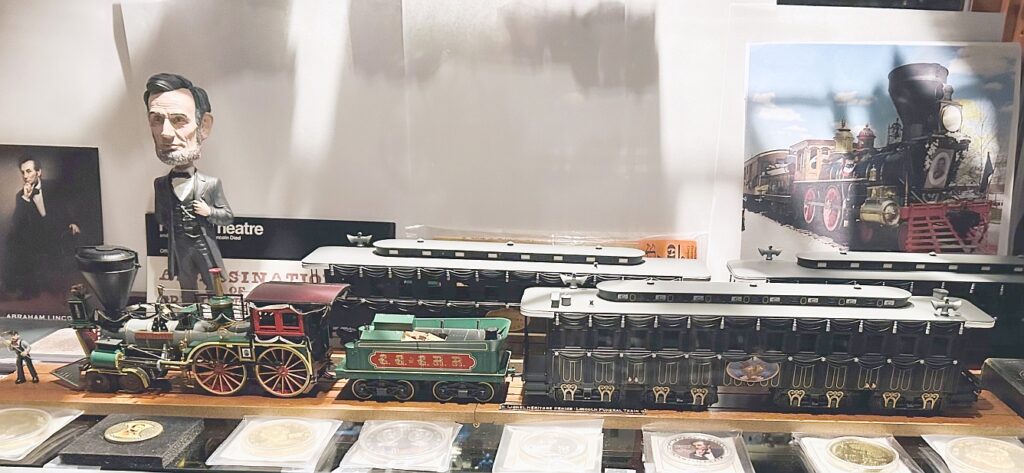
Lincoln Train Set and add-on two passenger cars displayed on a wide shelf in order to enhance the train set with many Abraham Lincoln memorabilia. Several coins featuring Abraham Lincoln displayed in a row in front of the Lincoln Funeral Train on the shelf
Obviously, there are many options and different mementos, collectibles, souvenirs, tokens, pictures, even a copy of the emancipation proclamation and a fantastic Abraham Lincoln bobblehead that are available to display with your Lincoln Funeral train set on your wide shelf. This is the fun part, everyone will enhance their display shelf differently, but creatively!
For me, I started with the many different Lincoln head coins that I could find. You can see some of them in the first picture. I also used two pictures for my display shelf. The first one was a picture of Abraham Lincoln (there are many available, just go online and you will find many choices) and also an enlarged picture (for the background) of the funeral train. I was in one of the many museum train stores on the East coast and found the Abraham Lincoln bobblehead. While the bobblehead is quite large, it expands the viewing of the display train shelf. It is especially appealing to young children and many teenagers.

Abraham Lincoln bobblehead which comes with a red base. It is “8 ¼” high and very colorful!

An enlarged picture (8 ½” x 9 ¼”) of the actual Lincoln Funeral Train that operated in 1865. Try going online, many pictures will be available to select from for your wide display shelf

Ford’s Theater, Official Park Guide” which was obtained from Ford’s Theater, National Historic Site, Washington D.C. This is a brochure from the National Park Service, U.S. Department of the Interior.

Upper left is a picture of “Abraham Lincoln, 16th President”, upper right is a narrative of “Abraham Lincoln, The 16th President” from The Danbury Mint. Bottom is a 2 coin set entitled “Abraham Lincoln Bicentennial Set in gold from the American Mint”.

Abraham Lincoln, 16th President 1861 to 1865” lighter and a “9 ½ x 4 ¼” picture of A. Lincoln with a one cent coin pictured near the bottom of the left side of the picture with the description “Abraham Lincoln, February 12, 1809 – April 15, 1865, 16th President of the United States of America” centered at the bottom of the picture.
Have fun decorating your train shelf honoring our 16th President, Abraham Lincoln and the Lincoln Funeral Train. There are many ways to be creative, but enjoy collecting the memorabilia to enhance displaying Abraham Lincoln historic mementos, souvenirs, tokens, and keepsakes.)
February, 2024
Welcome to Jerry’s Collectors Corner:
Today’s Feature: #11183 Lincoln Funeral Train, Part I
The major emphasis of the “Jerry’s Collectors Corner” articles has been to feature trains manufactured by Lionel during the 24 years (1946-1969) that Lionel produced trains. However, for the month of February, in memory of President’s month, I am going to make an exception and present the Lincoln Funeral Train.
It is recognizable, there has really been some unique “0” gauge trains generated during the MPC era that were never manufactured during the Postwar period which are both truly desirable and have a huge demand. One of these is the #11183 Lincoln Funeral Train set that was produced for only one year in 2013.
The Lincoln Funeral train has been part of the LRRC Heritage series created for collectors. This train was manufactured on a 1:48 scale.
The funeral train engine is very detailed, multi-colored and has elaborate mourning decorations including bunting, wreaths and a photo of President Lincoln in the front located just above the cowcatcher. There are additional pictures of President Lincoln on both sides of the engine just below the boiler fenders but between the large spoked wheels. The boiler is black, the top of the cab is maroon, the engine encasement is gray with gold stripes, and the side fenders on the boiler, headlight and smoke stack are all green. The spoked wheels are red and yellow and the air brakes are gold. The cab windows are red with both an engineer and fireman inside the cab. There is yellow striping on the front 4 trucks as well as yellow striping on the edge of the sides of the engine. As you may examine in the first picture featuring the Lincoln Funeral Train engine, the colorful design of this engine is breathtaking. Finally, there is a red “Nashville” sign with gold lettering on both sides of the engine. The cowcatcher is gray with a red metal control bar on the top of the cowcatcher. The engine is decorated with elaborate black & silver bunting honoring the memory of President Lincoln. Finally, there is a golden bell on the top of boiler with blue support struts and white stars decorated on the side of the support struts for the bell. Lionel went the extra mile creating the colorful details of this very famous “1865” Lincoln Funeral Train.
Lincoln’s funeral train made 13 major stops. At each stop, Lincoln’s coffin was taken off of the train and was placed on an elaborately decorated horse-drawn hearse. Each stop had a solemn procession to honor President Lincoln at a public building for viewing. The Lincoln Funeral Train departed Washington D.C. on April 21, 1865 carrying the coffin of President Abraham Lincoln. The funeral train went on a 1,654 mile journey to Springfield, Illinois where President Lincoln would be buried. The funeral train traveled through more than 400 cities in seven different states.
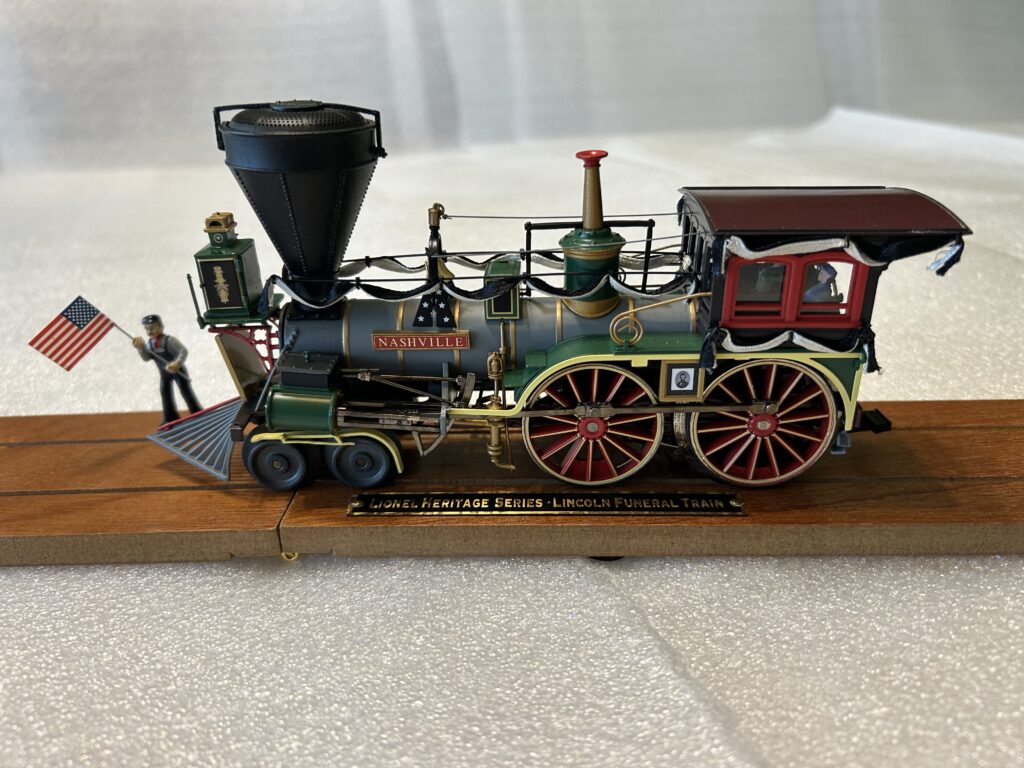
“#11183 Lincoln Funeral Train engine manufactured to the scale of 1:48. Colorful, detailed and decorated representing the actual “1865” funeral train used to honor and transport President Abraham Lincoln.”
The Lincoln funeral train tender was a green die-cast metal tender with gold striping. The “C. C. & C. R. R.” train logo on the side of the tender was red with gold lettering. It represented the “Cleveland, Columbus & Cincinnati Railroad” and had a black metal interior cover with simulated wood chunks openly displayed in the center of the tender. The tender had eight diecast trucks with a gold painted rim on each wheel. There was also a black brake wheel and two sets of operating pick up rollers on the tender.

“#11183 Lincoln Funeral Train tender with green painted die-cast metal base with simulated wood chunks in the tender bed and 8 wheel metal trucks with gold painted rims on the tender wheels. The tender has a red logo “C. C. & C. R. R.” with gold lettering on each side of the unit.”
The third car included in the #11183 Lincoln Funeral Train set was the “United States” Presidential Coach. This Presidential Coach is where Lincoln’s coffin was carried on the train and it also housed two protective uniformed guards as well. The shell of the coach is black with gold trim on each of the 12 side panels. In the center on each side of the coach is the “United States” Presidential seal (picture). In addition, all 12 windows and side panels on both sides are elaborately decorated with black bunting with 12 silver bells and 12 silver stars between the door panels making this Presidential Coach memorable, respectful and distinguishable. The roof of the coach was gray and only one end of the Presidential coach has a standing platform with a black plastic railing and the reverse end of the coach has no platform or railing. Finally, all 12 trucks (on each side) have extensively designed and decorated golden wheel wells. The Presidential Coach is both respectful and reverent. Lionel really paid attention to detail and authenticity!
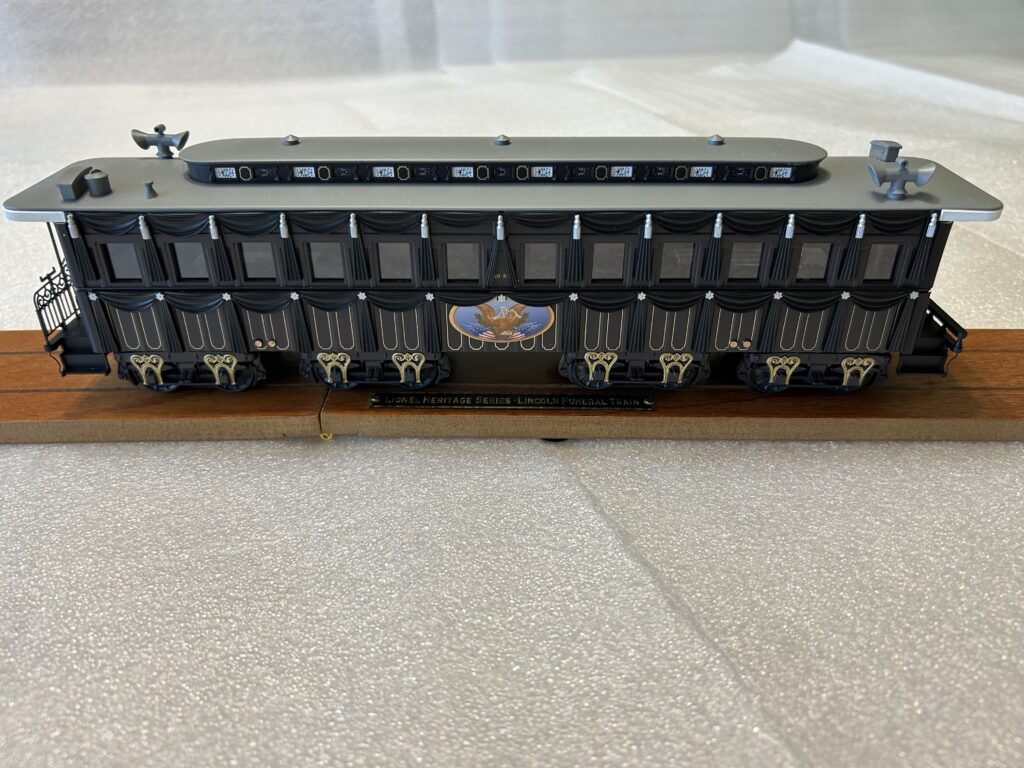
“#11183 Lincoln Funeral Train “United States” Presidential Coach. Elaborately decorated with black bunting and gold design sides panels and wheel wells. Coffin was carried in the center of this coach with two Pinkerton guards escorting this passenger coach.”
In 2013, Lionel also manufactured an “Add-on 2-Pack” 19th Century Passenger cars set to go with the original 3 car Lincoln Funeral Train set. These two passenger cars had die-cast metal trucks and detailed interior. Inside were several passengers with both bunting, 12 silver bells and stars on the outside of both sides matching the “United States” Presidential Coach described above in the funeral train set. However, these two passenger coaches did not have on the exterior of the cars the golden decorations on the 12 side panels or golden wheel well decorations. These two coaches had a matching gray roof and an elaborately designed plastic black railings on both ends of the passenger coaches. Also, it should be noted that Lionel provided a wooden track for both the Lincoln Funeral Train and the add-on two passenger cars for display.

“#25631 Two car 19th Century Passenger Car set offered as an “Add-on 2-Pack” option. Both passenger cars are a 1:48 scale model. Passenger cars had an exterior elaborate black bunting between all 12 windows and side panels. In the center on the side of the passenger cars is a metal sign indicating these passenger cars were from the “Philadelphia, Wilmington & Baltimore” Railroad.”
Part II of this article will feature many of the memorabilia that is available to display with the Lincoln Funeral Train set and the add-on 2 passenger coach set. It will also offer a different way to display this 5-car Lincoln Funeral Train set in your train room.
January, 2024
Welcome to Jerry’s Collectors Corner:
Today’s Feature: #3512 Operating Fireman and Ladder Car
During the 24 years of Lionel Postwar production of trains, one of the most interesting subsets of the model trains produced by Lionel during this era was what was known as the “Military and Space Cars”. A lot of specialty was focus by Lionel on both the military and space cars they manufactured. The most fanciful flatcar conceived during this period was the #3512 Operating Fireman and Ladder Car. It was definitely one of the favorites for both operators and collectors alike.
This fireman flatcar was manufactured for only three years from 1959 thru 1961. The unpainted red plastic body had white heat-stamped serif lettering. It came with two operating couplers, one of which was not standard as it was equipped with a drive belt, AAR-type trucks and a red light encased with a plastic cover which would flash as the flatcar traversed down the track. This was an attention getter and truly loved by all kids and adult operators. This flatcar added a lot of pizzazz to an operating layout. The fireman with his large white plastic hose swung from side to side as the flatcar moved down the tracks. This operation added a lot appeal, enchantment and fascination and created fun times enjoyed by everyone.
The operating fireman and ladder flatcar, Type I was the most common variation produced. It had an ingenious and somewhat complex sheet medal extension ladder which was mounted on the top of the car (and could be extended nearly 12” on a siding to simulate firemen going to a rescue on a burning home or a superstructure on a layout). This flatcar also had two rigid black medal ladders hung on each side of the car (which made Lionel unable to install a brake wheel on this flatcar). There was a gold bell mounted on the flatcar and most importantly, it came with three metal nozzles mounted right behind the rotating fireman with his large white plastic hose. Especially important is to have all three metal nozzles attached to the plastic base to make this flatcar complete. This part is key for collectors to have a desirable #3512 fireman and ladder car in their collection. Be sure when attending train meets or train auctions that your fireman and ladder car contains these THREE metal nozzles to have your car be complete.
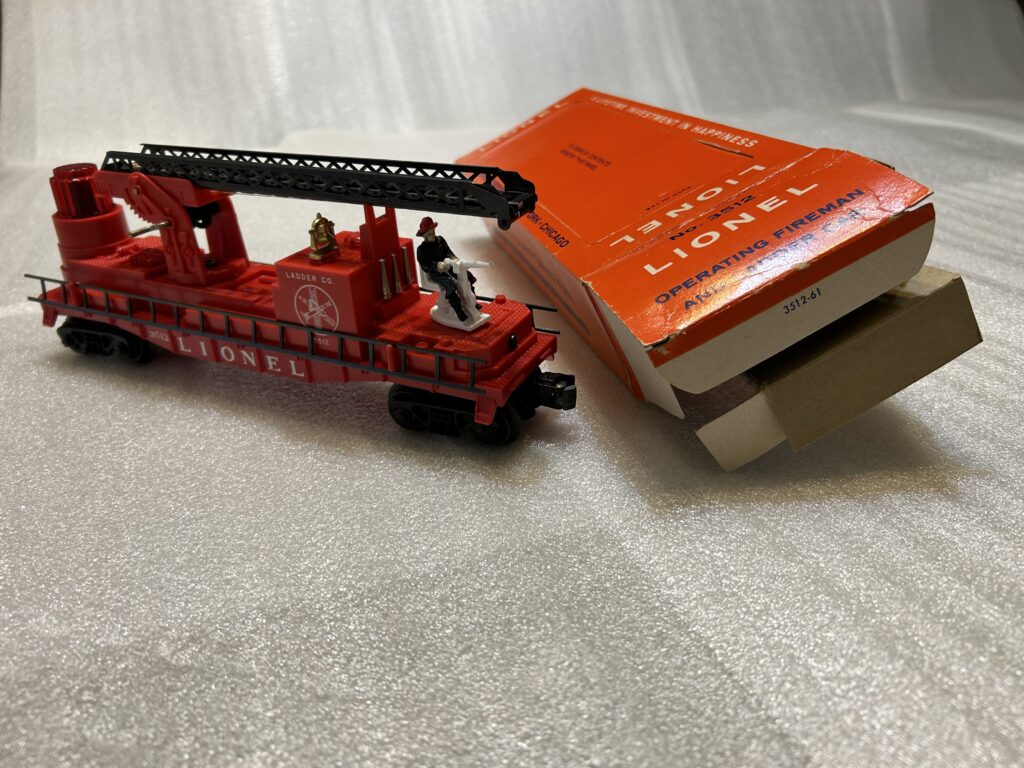
“#3512 Operating Fireman and Ladder Car, Type I, with black extension ladders mounted on the top of the car. Flatcar has white heat-stamped serif lettering on the sides and THREE metal nozzles attached to the car directly behind the rotating fireman with the large white plastic hose.”
The second variation of the #3512 Operating Fireman and Ladder Car, Type II is more challenging to locate than the Type I variation, but still is possible to acquire at a train meet or train auction. It comes with silver extension ladders mounted on the top of the red unpainted plastic car. The remaining features of this fireman car are identical to the Type I variation described above. The Rarity rating for the Type II variation is a “7”.

“#3512 Operating Fireman and Ladder Car, Type II, with silver extension ladders mounted to the top of the unpainted plastic car. It contains THREE metal nozzles attached to the car directly behind the rotating fireman with the large white plastic hose.”
Finally, this operating flatcar creates a lot of action which gains attention as both the flashing light at one end of the flatcar is beaming while the rotating fireman with his large white plastic hose is swinging from side to side at the other end of the flatcar as it moves down the track. Enjoy the operating fireman car, it is fun and attracts a lot of attention on a layout!
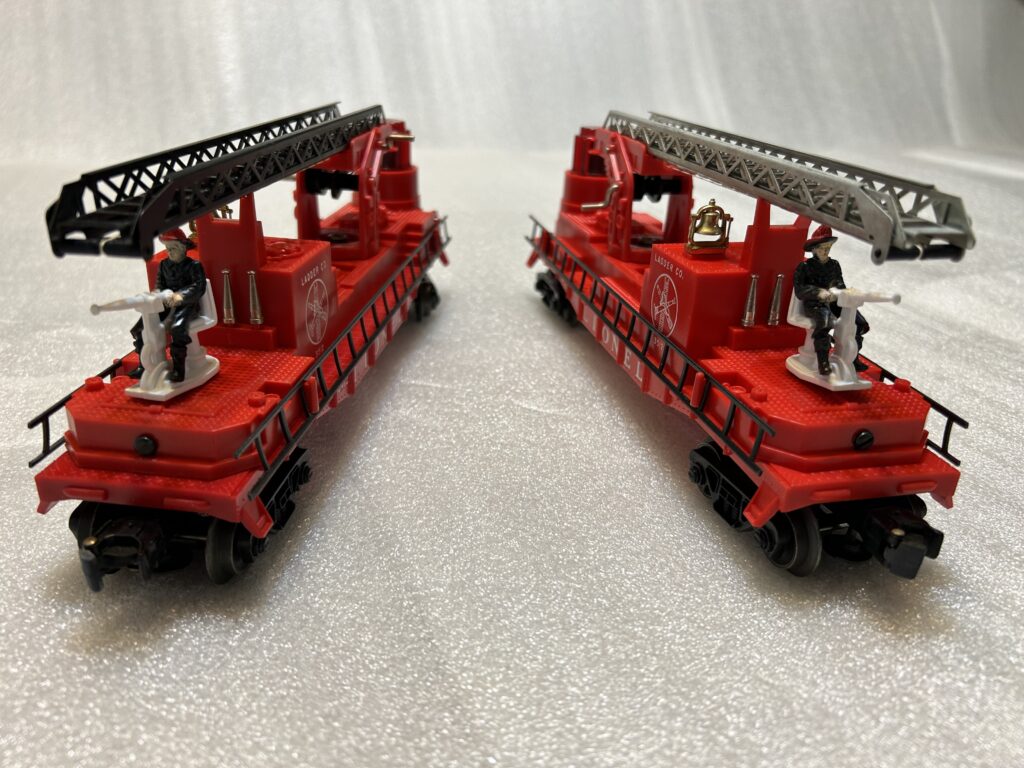
#3512 Operating Fireman and Ladder Car, both Type I and Type II, frontal view of flatcar showing the metal nozzles located behind the rotating fireman with the large white plastic hose.”
December, 2023
Welcome to Jerry’s Collectors Corner:
Today’s Feature: #6119-50 and #6119-75 D.L.&W. Work Cabooses
While the #6119-50 and #6119-75 work cabooses are fairly common, two of these four variations are extremely RARE. If you locate one of the two RARE #6119-75 D.L.&W. Work Caboose variations, either at a train meet or in a train auction, you will have a fabulous discovery and could acquire an attractive addition to your collection at a very reasonable cost. The key take away is that almost all collectors and operators are not at all aware of how RARE two of these 4 variations are and finding either one will greatly enhance your train collection. More about these really two RARE variations later in this article.
First of all, the #6119-50 D.L.&W. Work Caboose was offered in several inexpensive sets starting in 1956. Both the tool compartment and cab were both an unpainted brown plastic in starter sets and were attached to a painted matching brown sheet-metal frame. It had only one magnetic coupler (however, many operators added a second magnetic coupler to the rear of this work caboose when operating trains on their layouts), bar-end trucks and a very short die-cast smokejack. The lettering on the metal frame was white heat-stamped serif lettering that was widely spaced. It should be noted that the number stamped on the cab was only “6119” and it did NOT include the “-50” on the cab stamping. The “D.L.&W.” stamped on the cab sides represented the “Delaware, Lackawanna and Western” railroad.
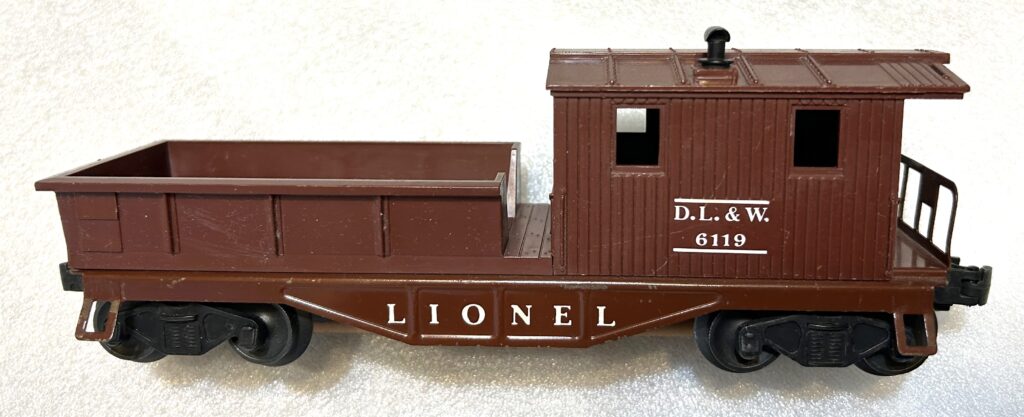
“#6119-50 D.L.&W.” Work Caboose has an unpainted Brown plastic cab and tool compartment with white heat-stamped lettering, short die-cast smokejack and bar-end trucks.”
The first of the three variations of the #6119-75 D.L.&W. Work Caboose, Type I was first manufactured in 1957 and was produced for only three years (1957-1959). It had both an unpainted light gray cab and tool compartment. The lettering on both the cab and sheet metal frame was black heat-stamped lettering. The metal frame was painted a matching light gray and only came with one operating coupler. The lettering on the frame was widely spaced sans-serif lettering (and this is key to know because that is what separates this Type I variation from the extremely RARE Type II and Type III variations). This Type I variation came in a desirable standard Orange/Blue Lionel box.
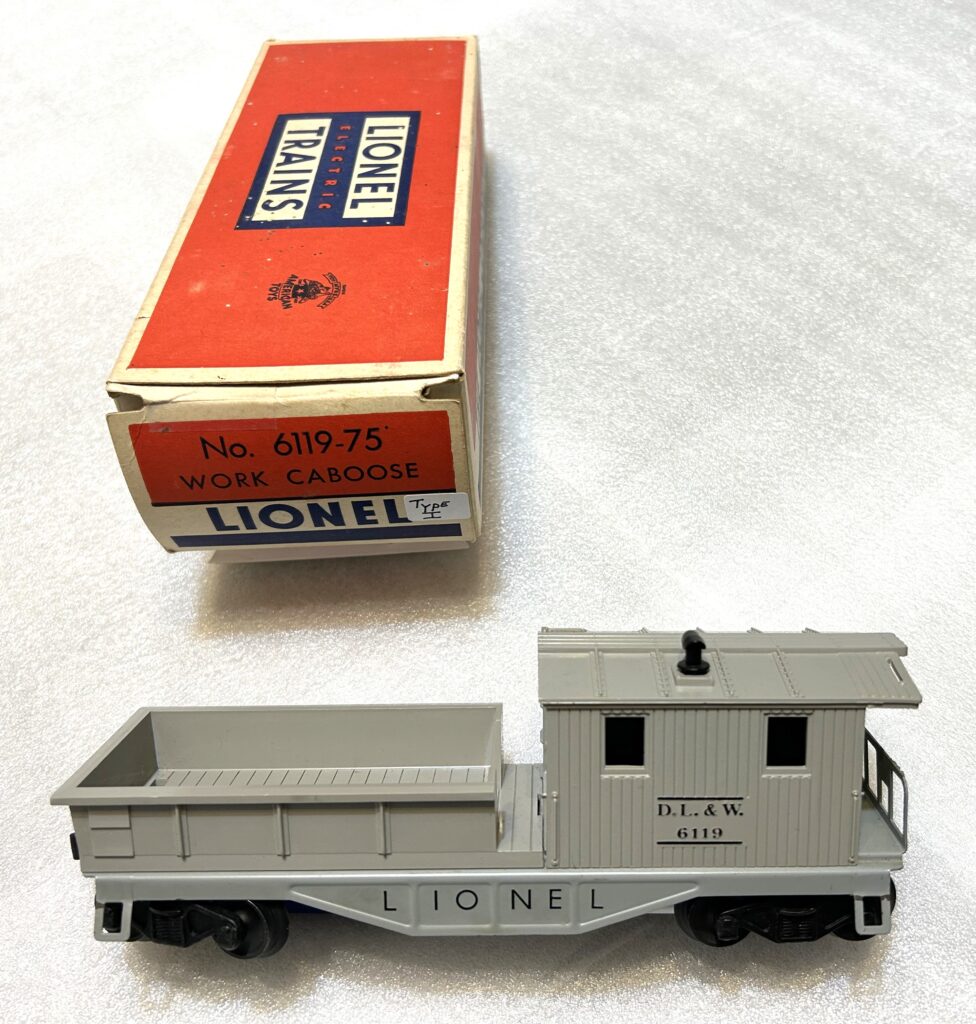
“#6119-75 D.L.&W. Work Caboose, Type I with original Lionel box. Both cab and tool compartment were unpainted light gray plastic with a matching painted light gray sheet-metal frame. Lettering on the side was black heat-stamped with widely spaced sans-serif lettering.”
Now let’s look at the #6119-75 D.L.&W. Work Caboose, Type II. This is the first of two extremely RARE variations for this work caboose. The Type II variation has a Rarity Rating of an “8”.
As you know, the Rarity rating for Lionel engines, rolling stock and accessories produced are based on a rating scale of 1 to 8. In the 24 years of Postwar Lionel trains (1946-1969), I believe this is the ONLY car produced that has TWO variations rated with the highest rarity rating level of an “8”. The difference in these variations is found in the heat-stamping on the side of the metal frame. As I mentioned before, most train collectors have not picked up on this RARITY rating of an “8” and finding either variation Type II or Type III would be a smart addition to your collection.
The Type II variation is identical to the Type I variation described above except for the closely spaced, black rubber-stamped serif lettering on the metal frame. Look carefully at the black stamping of ”Lionel” on the light gray painted die-cast frame. It is distinctive, bold, and sharply serif lettering style. This Type II brings a huge premium, especially if the work caboose is in LN or MINT condition.

“#6119-75 D.L.&W. Work Caboose, Type II with original Lionel box. This variation is identical to Type I except for the closely spaced, black rubber-stamped bold serif lettering on the metal frame. Rarity Rating is an “8”.
The second RARE variation of the #6119-75 D.L.&W. Work Caboose, Type III also has a Rarity rating of an “8”. Both the cab and tool compartment are identical to the two previous variations Type I and Type II. The major difference is the widely spaced, black rubber-stamped serif lettering on the metal frame.
In summary, these two RARE variations differ only on the stamping on the side of the metal frame. This is why novice train operators and collectors usually don’t pick up on the stamping differences with these two work cabooses. Good luck, either one of these two RARE variations may easily be found. Happy searching!!!😊
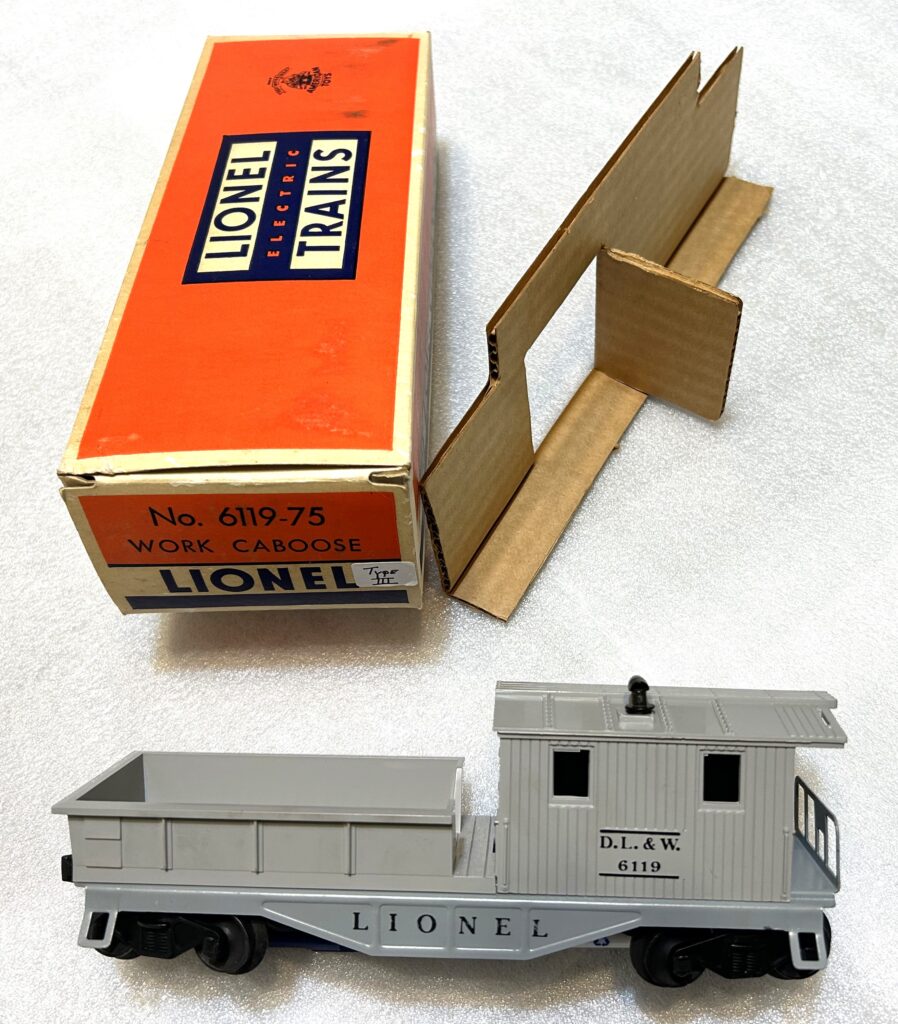
“#6119-75 D.L.&W. Work Caboose, Type III with original Lionel box and cardboard liner. This variation differs only with the widely spaced, black rubber-stamped serif lettering on the metal frame. Rarity Rating is an “8”.
Finally, I am adding one additional photo which contains ALL 3 variations of the #6119-75 D.L.&W. Work Caboose so you may easily compare AND examine the Black rubber-stamping of ALL 3 variations. Noting that the Top Work Caboose, Type I is the common variation and the Middle Work Caboose, Type II and the bottom Work Caboose, Type III are the TWO RARE VARIATIONS.
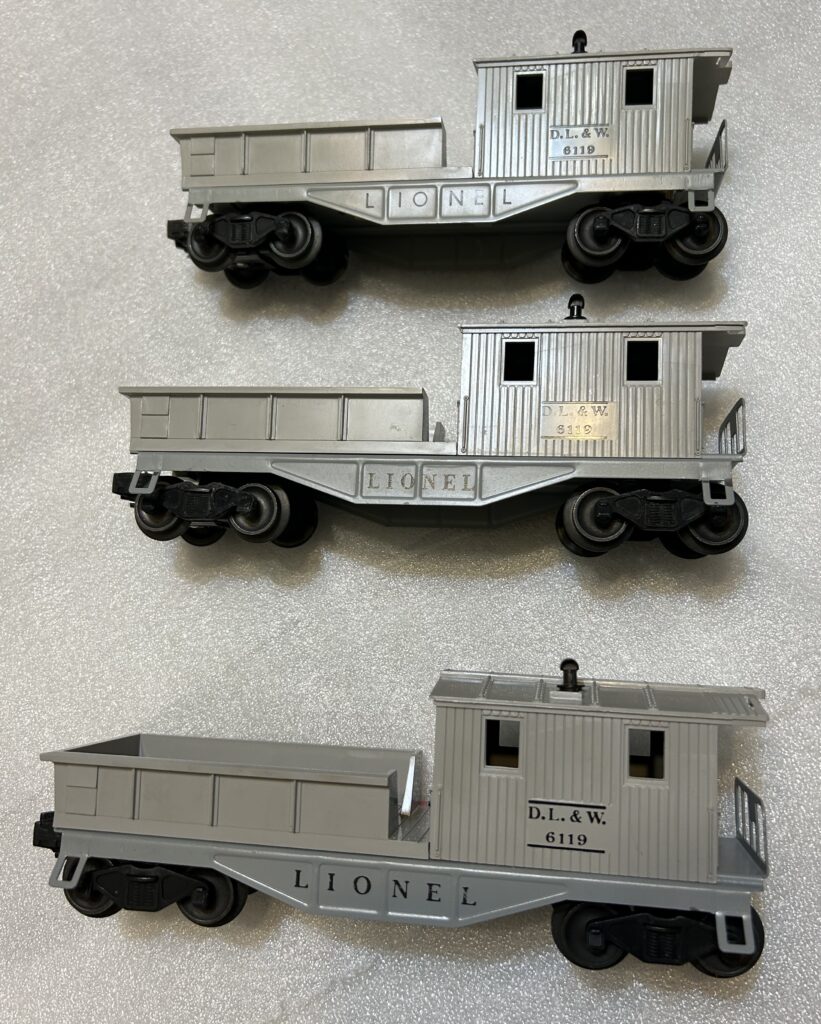
“#6119-75 D.L.&W. Work Caboose, Type I (top work caboose) is the common stamping, #6119-75 D.L.&W. Work Caboose, Type II (middle work caboose) has Rarity Rating of an 8, and #6119-75 D.L.&W. Work Caboose, Type III (bottom work caboose) also has a Rarity Rating of an 8.
November, 2023
Welcome to Jerry’s Collectors Corner:
Today’s Feature: #30 and #38 Operating Water Towers
Important to both model train operators and collectors were the accessories that Lionel manufactured during the Postwar era of 1946 thru 1969. Lionel knew this and in the late 1940’s, the operating water towers were a success.
The #30 Operating Water Tower was produced for only four years from 1947 thru 1950. The Type I variation was initially produced in 1947 and it was listed in the Lionel catalog thru 1950. The die-cast base was a dark gray with brown painted simulated timbers supporting the double wall tank. The roof was painted gray with an unplugged hole in the center. The tank was a translucent amber plastic which was also lined with Kraft paper. The operating solenoid-lowered plastic spout worked well and was attractive and attention getting accessory when operating on a train layout. The 1947 original box had the tower inserted in the box on its side. This is a very difficult original box to locate and collectors seek it out all of the time.
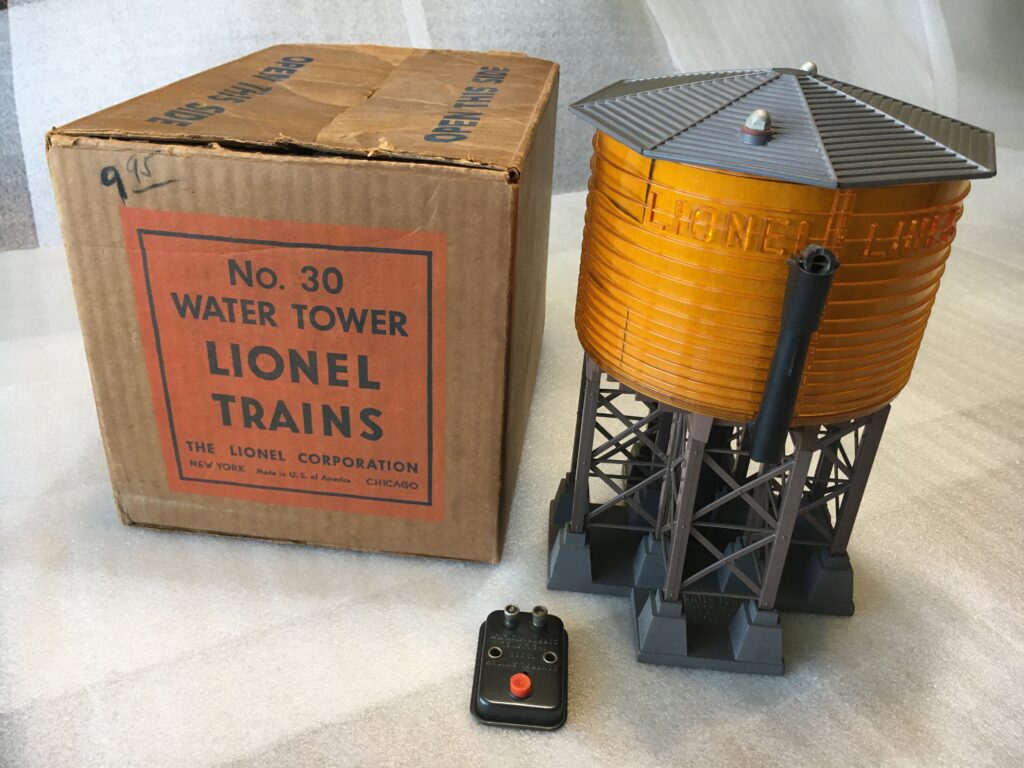
“#30 Operating double wall Water Tower, Type I, with brown plastic simulated timber supporting the tank with a gray painted plastic roof. This water tower came with a controller to operate the solenoid lowering plastic spout.”
The #30 Operating Water Tower, Type IV variation also has brown plastic simulated timber supporting the single walled tank. It had a painted dark gray plastic roof, but the roof did not have a hole in the center. It is pictured below. Please note that sometimes the plastic roof was painted a light gray, but there is no difference in value or demand due to this coloration.
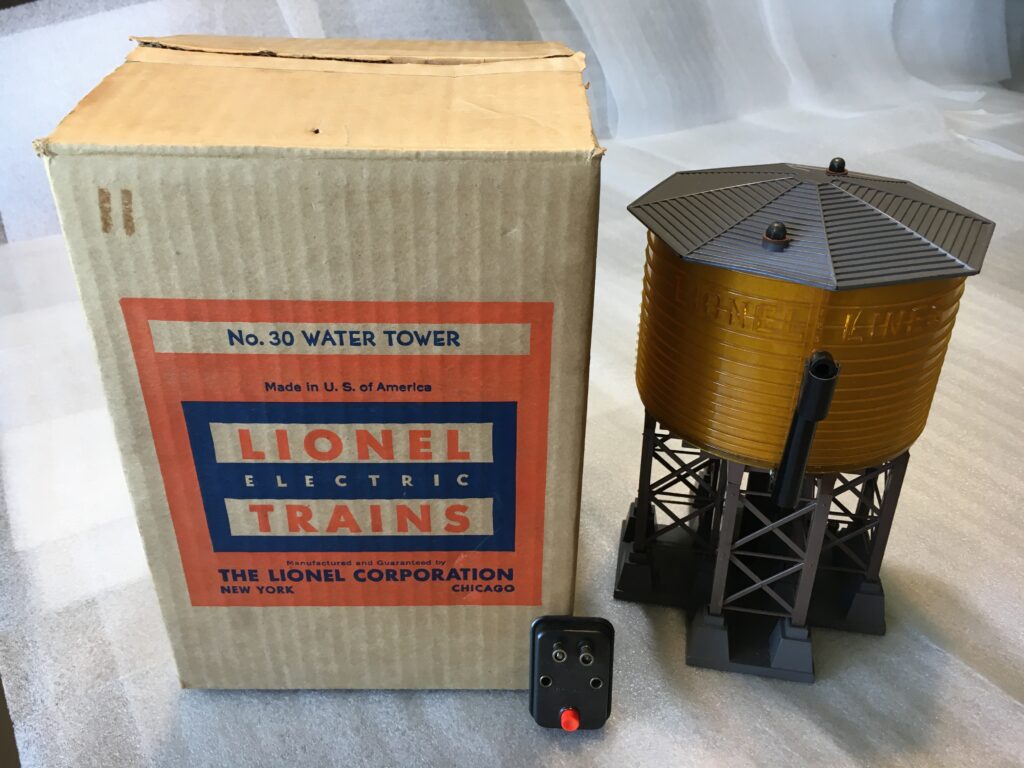
“#30 Operating single walled Water Tower, Type IV, with brown plastic simulated timber supporting the tank with a gray painted plastic roof. This water tower also came with a controller to operate the plastic spout.”
The Type IV #30 Operating Water Tower was mounted upright in its original cardboard box. It came with an Instruction sheet and cardboard inner flaps to hold the water tower standing upright in place in the original cardboard box.
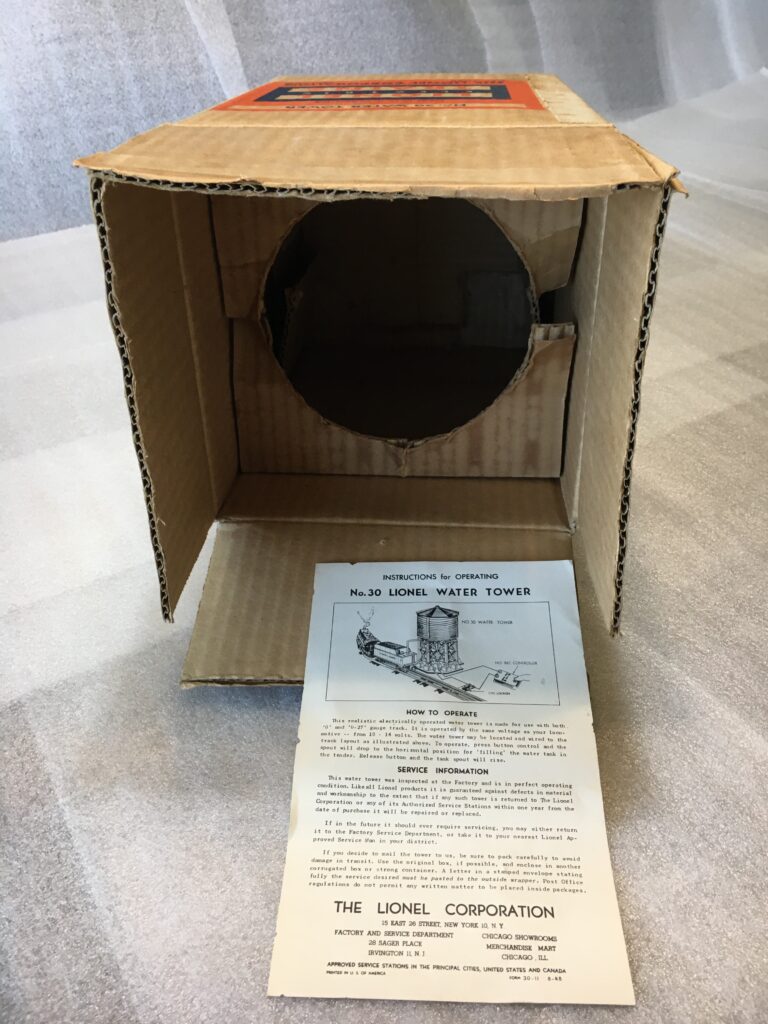
“Interior view of original box for Type IV, #30 Operating Water Tower packed upright in the cardboard box.”
#30 Operating Water Towers, Types II and III (not pictured) were identical except the simulated timber supporting the tank was painted black. Black rubber washers were placed under roof mounting nuts in these two variations.
Next is the extremely desirable and RARE variation, the #38 Operating Water Tower. The demand is high for this scarce operating water tower which was manufactured for only two years in both 1946 and 1947. This Type II water tower came with a light gray painted die-cast base, intricated brown plastic simulated wood supports holding the double walled amber color tank. The tank was controlled by a #96C controller which both lowered the spout and started the pump. It was really neat to see the pump transfer the water from the area between the inner and outer tank walls to a holding area near the top center of the amber tank. When the button on the controller was released, the spout raised and the action of the pump stopped. Next, the water began to drain due to gravity back to the area between the tank walls. The #38 Operating Water Tower, Type II, had a plastic roof painted red.
This is an exciting accessory to operate and truly demands a lot of attention by spectators at your train layout. It is an action pack accessory and adds both joy and excitement when operating on a train layout. The #38 Water Tower has a Rarity Rating of a 6! There is also a Type I, #38 Operating Tower (not pictured) that came with dark gray or brown painted roofs with the simulated plastic tower supports painted black. It should be noted that when the #38 Operating Tower was brand new, it contained a packet of tablets for coloring the water. Unless, you find a factory sealed MINT #38 Operating Water Tower, you will not find these tablets for coloring the water filling in the tank.
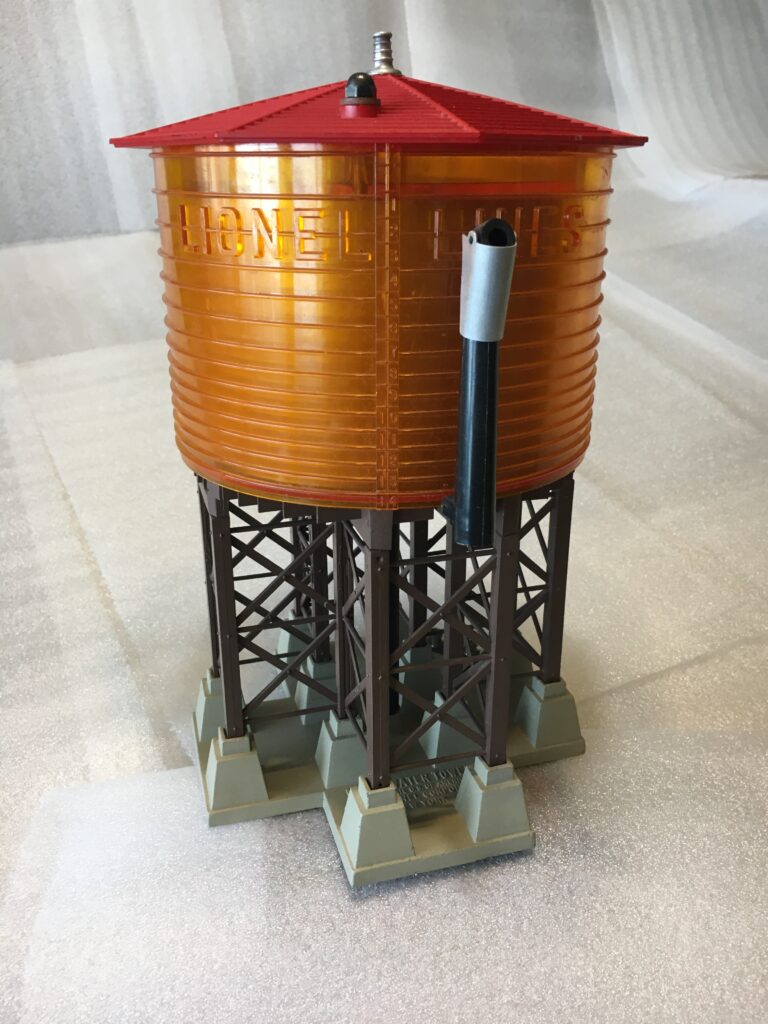
“RARE, #38 Operating Water Tower, Type II, with light gray painted die-cast base, detailed brown simulated wood supports, amber colored tank, that came with a red roof. This operating water tower was double walled and operated moving the water between the 2 walls in the tank to the interior of the tank. When operation was stopped, gravity would fill the water back between the double walls.”
Action pack accessories obviously add a lot when viewing a train layout. These operating water towers were a favor of operators and enjoyed immensely by everyone viewing their action when operated on a train layout!
October, 2023
Welcome to Jerry’s Collectors Corner:
Today’s Feature: Special Fall Season “Halloween Edition”
As you know, I write one Postwar Lionel Train article per month. This will be my 38th consecutive Lionel train article. All of these articles have featured Lionel trains during the 24 year period of POSTWAR Lionel trains (1946-1969). However, this month I am going to deviate a little bid and feature a Lionel MPC Halloween gang car to help celebrate the coming of the Fall season and a very special “G” scale “Mickey and Goofy” handcar, which I believe is a Lionel classic, truly quite awesome and is one of my MOST favorite train cars of all time. So here we go!!!!
Everyone enjoys the Lionel motorized units, especially the many different handcars produced by Lionel over the Postwar period, MPC years and the LTI phase of Lionel trains. Helping to launch the Fall season and get the Fall season under way, the Lionel #28428 “Halloween Hand Car” was produced for only one year in 2007 during the MPC era of Lionel trains. This handcar featured two Gandy dancers (which is a slang term used for early railroad workers in the United States, which most often referred to them as “section hands”, who actually laid and maintained railroad tracks in the many years before the work was mechanized). These two crewmen came with “Pumpkin” heads and they operated on a bright plastic orange hand car. What is really neat is to watch this gang car operate when it sails along the track on your layout. It is truly an “attention getter” and many times mesmerizes the on lookers at your layout, especially many young children. This “Halloween Hand Car” truly marks the spirit of the coming fall season for operating your trains on your layout.
The other important consideration about this time of the year is that the coming of Fall marks in my opinion the coming of what I call the “Train Season”. These four months of November, December, January and February every year are the height of train activity for most collectors and operators alike throughout the United State. It is during these four months of the “Train Season” you witness the highest number of train meets, the largest attendance by train enthusiast at train meets, the largest number of quality model train auctions and the most club train meets scheduled during the year. I am glad Fall is coming as it means the 4 months of the train season begins!!! Time to operate your trains, have friends, relatives and colleagues over to see your layout and enjoy sharing your trains with your family.
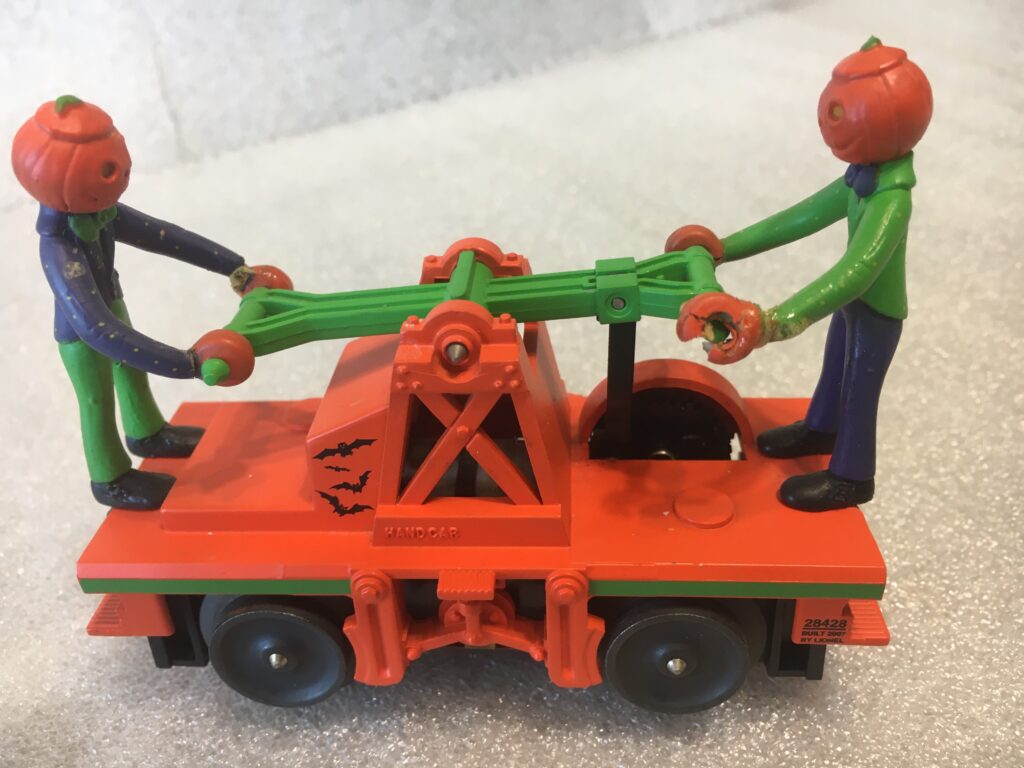
“#28428 Handcar with a bright plastic orange hand car and two Gandy crewmen dancers with Pumpkin heads”
Next, I would like to present the #8-87216 “G” scale “Mickey and Goofy” Hand car. “G” scale (1:24) trains are the largest commercially available scale gauge for operating model trains. “G” scale trains are most often used for outdoor garden railroads due to its durability and large size. “G” gauge is sometimes referred or interpreted as “garden scale”. Many times, you will also find “G” scale model trains operating indoors on a track mounted against the wall near the ceiling. Many restaurants that operate trains for their customers usually prefer to feature “G” scale trains because they are large, easy to see and attractive to watch for their patrons.
This large “G” scale Lionel train features both “Mickey” and “Goofy” as crewmen operating a large blue plastic hand car. With its “yellow” wheels it is definitely an attention-grabber and draws everyone’s excitement when operating. This hand car is definitely a “crowd pleaser” and a hand car that you may want to consider adding to your model train collection.

“#8 -87216 “G” scale “Mickey and Goofy” bright blue plastic hand car with yellow wheels with “Disney” OB”
This “G” scale hand car is a bundle of fun and an operating “Goofy” is truly unique to watch. Your train friends will be enthralled and almost hypnotize when watching this hand car operate. They will definitely return many times to view this hand car operating on your layout!
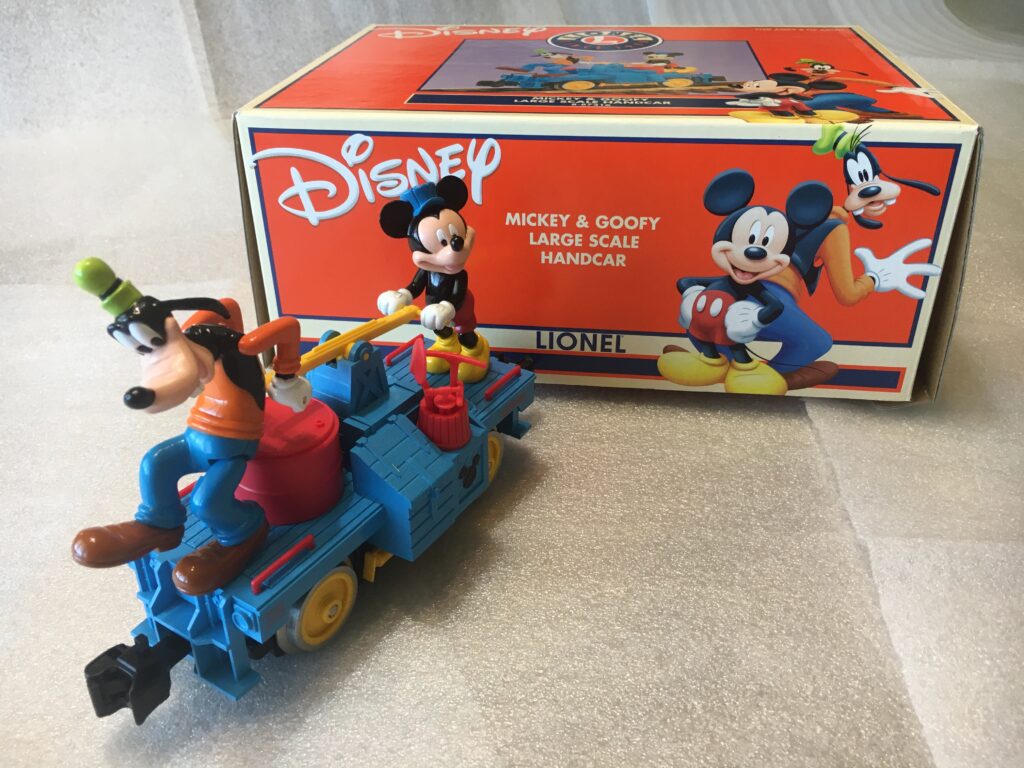
“Frontal view focused on the extra large “Goofy” crewman operating the gang car facing backwards when pumping the hand car”
Now, go have some fun, time to add this beautifully designed hand car and
operate the large “G” scale hand car on your layout, you will be glad you did!!!!
September, 2023
Welcome to Jerry’s Collectors Corner:
Today’s Feature: #6464-75 Rock Island Box cars
The #6464-75 Rock Island box car has two major variations which are described as a Type I and a Type II box car. It was produced for only three years. The Type I box car was manufactured in 1953 and 1954. The Type I box car in this series, only came with a Type IB plastic body mold. This means it had the first three columns of rivets on the left side of the box car incomplete at the top. The second column of rivets from the left end of the car had two interruptions. As noted, a Type IB body mold only comes with a smooth internal roof.
This Rock Island box car, Type I, has a glossy green-painted body and has a deep gold heat stamped lettering. The doors were also painted the same glossy green paint as the body of the car. You can also find a lesser known Rock Island painted a flat green body and doors, but it has the same value and is not sought after by collectors or operators. This car was only stamped with the number “R. I. 6464” and the “-75” was simply not included on the heat stamping on the sides of the box car. This box car came with bar-end trucks, a brake wheel, single tack board doors and two magnetic couplers.
Finally, the deep gold heat stamped markings included the “NEW 5-53” stamping on the sides of the box car.
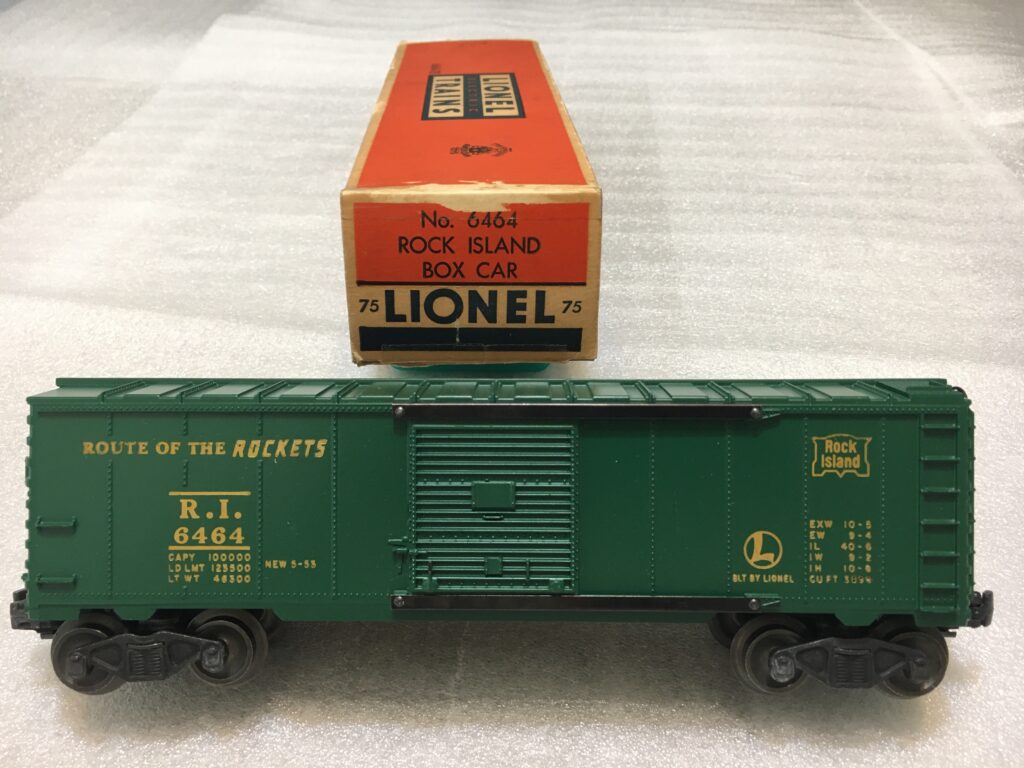
“#6464-75 Rock Island box car, Type I variation with a glossy green painted body and single tack board doors with a deep gold heat-stamped lettering.”
The major second variation of this 6464 series box car was known as the Type II variation. It was produced only for one year in 1969 and was packed with a Hillside Checkerboard Lionel box (see picture below). This Type II variation was produced with a Type IV plastic body mold which only comes with interior roof ribs.
The Type II variation was different in many ways from the Type I variation. First of all, it was produced only with multiple tack board doors, but did not include the “NEW 5-53” imprint. But most important, the gold heat stamped lettering was actually a light gold heat stamped lettering. It is a distinctively different type of gold heat stamped lettering (which most pricing guides do not include this gold stamping difference). This Type II variation comes with bar-end metal trucks, which is quite unusual for box cars produced by Lionel in 1969.

“6464-75 Rock Island box car, Type II variation with a glossy green painted body and multiple tack board doors with a light gold heat-stamped lettering.”
Lastly, I am including a third picture that is specifically focusing on the coloring of the gold stamping of these two variations. Unfortunately, as mentioned before, almost ALL pricing guides do not point out this distinctively different type of gold heat stamped lettering. Examine, the photo below, you will truly see the dissimilar and unlike DARK and LIGHT gold heat stamped lettering of these two variations. The contrast is quite obvious and markedly different.

“Check out the DARK gold stamping of variation Type I (the top box car) and the LIGHT gold stamping of variation Type II (the bottom box car”.
August, 2023
Welcome to Jerry’s Collectors Corner:
Today’s feature: “#1882 4-4-0 Steam Locomotive General Set” (third in a series of three famous “General” Locomotive articles)”
This is the third in a series of three articles featuring the various “General” steam locomotives 4-4-0 sets. The #1882 4-4-0 Steam Locomotive General Set was an uncatalogued set that was manufactured for only one year in 1960. This is the rarest and most difficult General set to obtain and has the highest demand from both collectors and operators to acquire. This General Locomotive set has a Rarity rating of a 7 (on a scale of 1 to 8). It is commonly referred to as the “Halloween General Set” due to its orange and black dominant colors. The picture below shows this #1882 General Set displayed on a “Theme Shelf” instead of being placed flat on a wall of train shelves. This unique display approach is encouraged and demonstrates an alternative way of displaying your trains either in your home or in your train room.
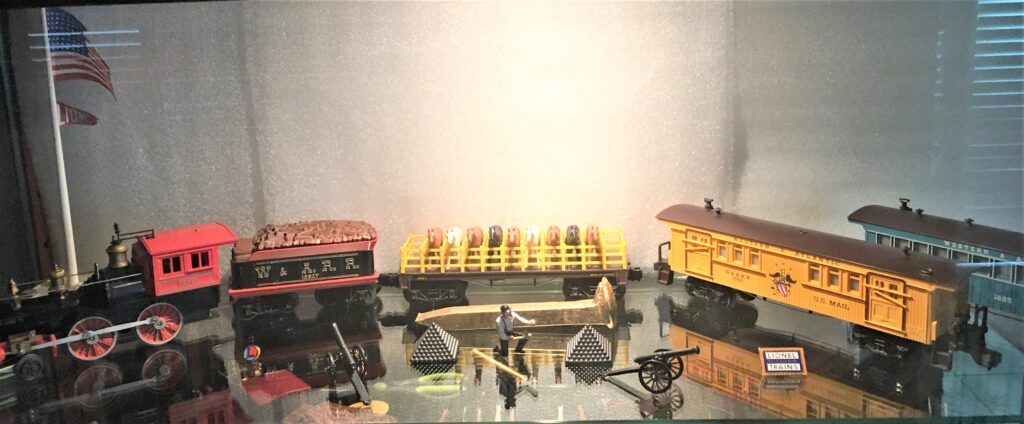
“1882 4-4-0 Steam Locomotive General Set displayed on a theme shelf with two cannons, stacks of cannon balls, a miner and the “Lionel” American Flag.”
The “027” gauge #1882 4-4-0 Steam Locomotive General has a black unpainted plastic boiler and tile orange-painted cab and cowcatcher. Also, the side gear boxes are also tile orange-painted. The large power wheels feature the “Halloween” orange painted wheels. The #1882 engine has gold-painted heat-stamped lettering, gold-painted steam and sand domes and a bright gold-painted steam ornamental bell. This engine includes the extremely fragile black plastic ornamental whistle. However, this steam locomotive does not have the boiler banding and piping detail on the engine. The #1882T tender also has the orange striping and black painted tender. The “W & A.R.R.” lettering on the tender is a bright gold heat-stamped painted gold.

“#1882 4-4-0 Steam Locomotive General and #1882T Tender known as the “Halloween General Set” with bright orange and black painted locomotive and tender with gold heat-stamped lettering.”
The #1887 General flatcar was produced and came in the Sears #9666 “General Set”. The brown flatcar had yellow heat-stamped “1887” lettering on the left end of the flatcar and “BUILT BY LIONEL” stamped on the right side of the flatcar. This flatcar also had two wire truss rods installed beneath the car and came with arch-bar trucks. Uniquely, the fences were a bright yellow plastic (#1862 flatcar and the #1872 flatcar came only with brown plastic fences), there were 10 sections of unpainted yellow plastic fencing keeping the horses apart. This horse flatcar came with a load six horses: two white, two tan and two black horses all manufactured by Bachmann Bros. You can find the “BB” logo under the bellies of the horses. This is important to check when acquiring this flatcar to ensure the horses are original and are not reproductions. Couplers at both ends are non-operating couplers.
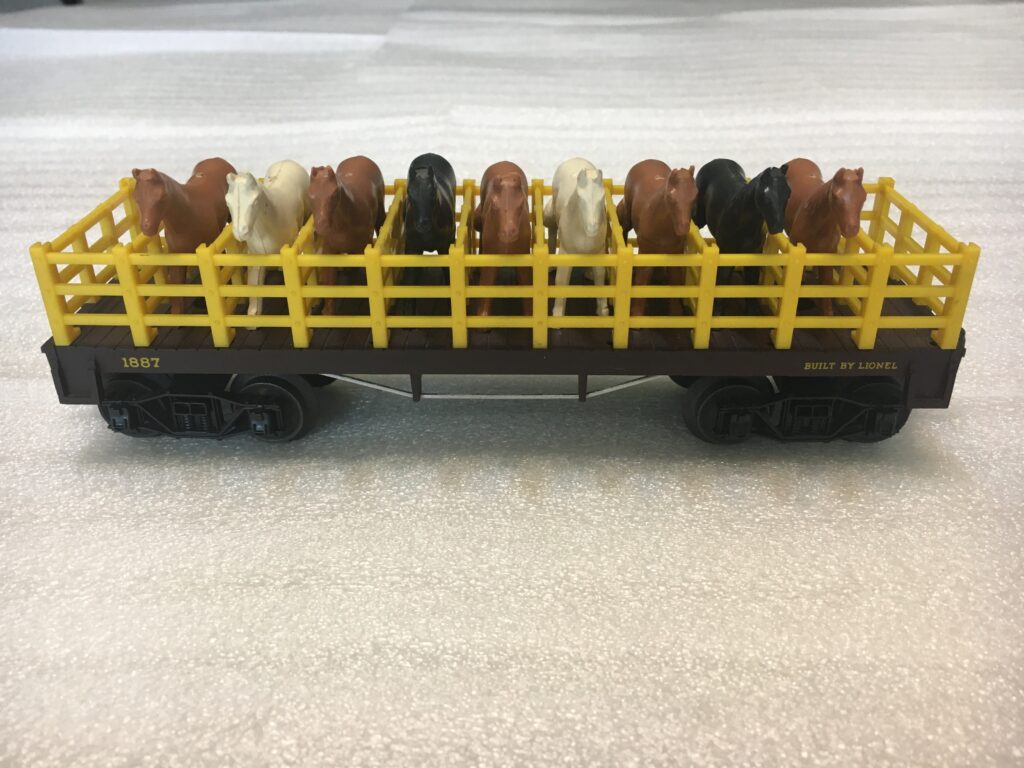
“#1887 General flatcar with six plastic horses, brown plastic flatcar with gold heat-stamped lettering.”
The #1866 “Western & Atlantic” Mail-baggage combination passenger coach was painted yellow and has simulated wooden construction sides with a brown plastic painted roof. Like the #1875 Mail-baggage combination passenger coach, it came with an attractive American golden eagle and flag decal that is center on each side of the passenger coach. This coach had brown heat-stamped lettering, but was NOT illuminated. It came with an opaque window shell, two smokestacks and two roof ventilators, wire truss rods under the body of the coach, brake wheel at each end and non-operating couplers at each end of the passenger coach.

#1866 “Western & Atlantic” Mail-Baggage combination passenger coach with an American golden eagle and flag decal in the center of each side. This Non-illuminated passenger coach has two smokestacks, two roof ventilators, stainless wire truss rods under the body of the combination car and arch-bar trucks.”
The last car in this General set is quite unique! The #1885 “Western & Atlantic” passenger car is painted blue. It is the ONLY blue passenger car in any of the three General Locomotive sets produced by Lionel. As a result, it is highly coveted by all collectors and operators. This passenger car does have the wire truss rods under the body of the coach, an opaque window shell, two smokestacks and two roof ventilators as well as a brake wheel at each end of the car. This Non-illuminated passenger car has non-operating couplers at each end of the passenger coach. Locating this blue passenger coach in a LN+ or MINT condition is difficult, but highly desirable.

#1885 “Western & Atlantic passenger car painted blue. Includes stainless wire truss rods under the body of the passenger, an opaque window shell and a brake wheel at each end of the car. Lionel never made an individual OB for this car since it only came in a set.
July, 2023
Welcome to Jerry’s Collectors Corner:
Today’s feature: “#1872 4-4-0 Steam Locomotive General Set” (second in a series of three famous “General” Locomotive articles)”
Lionel manufactured this model of the “Civil War General” locomotive for four years, beginning in 1959 and the final year of production was 1962. It was designed to replica the famous General locomotive stolen during the civil war in 1862 by Union dedicated sympathizers in an attempt to quickly end the American civil war. It was the second of three different General locomotives produced by Lionel, but the only one that was “O” Gauge. The #1872 4-4-0 Steam Locomotive General Set was sold as set #2528WS and was known as the “Five-Star Frontier Special Outfit” set. This set came in a yellow set box and the engine, tender and three cars all were in separate original Lionel boxes. The set also came with original Lionel Super “0” gauge track.
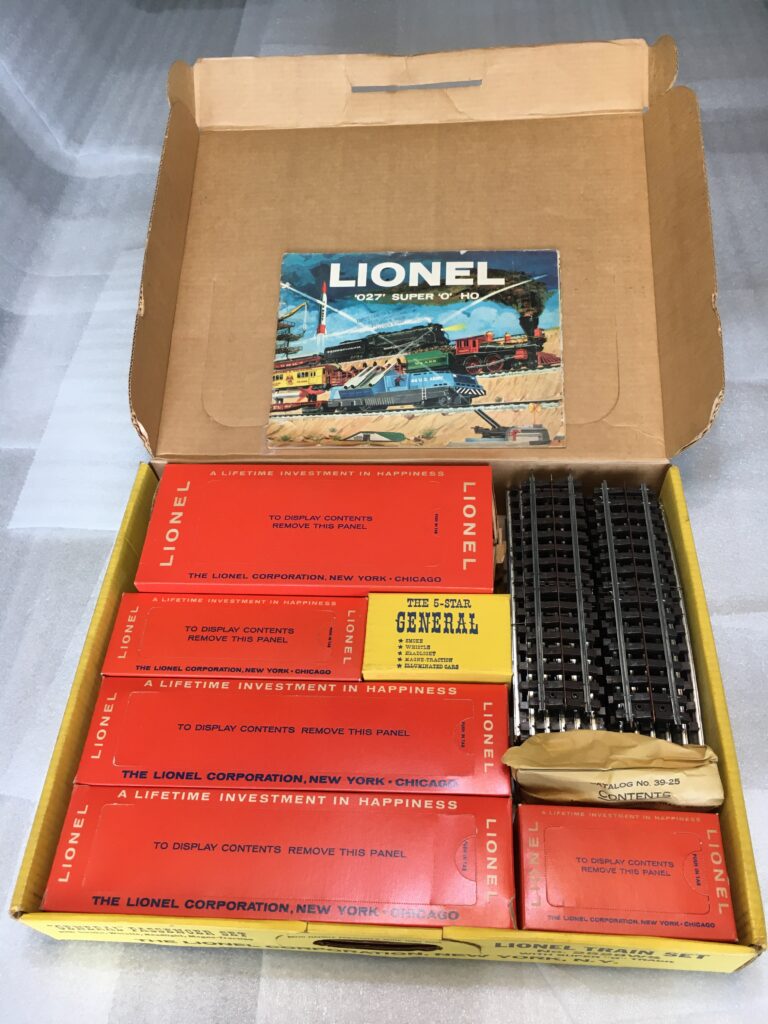
“#2528WS Five-Star Frontier Special Outfit set containing the #1872 4-4-0 Steam Locomotive General in an original yellow set box with the locomotive, tender and three cars in separate original Lionel boxes and Super “O” gauge Lionel track.”
The #1872 4-4-0 Steam Locomotive General had a gray painted plastic boiler and tile red-painted cab, cowcatcher and part of the headlight housing unit also had tile red-painting. In addition, the large power wheels and the center section of both the sand dome and the steam dome were painted tile red. The top and bottom portion of the sand dome and the steam dome were painted gold as well as the ornamental bell which was entirely painted gold. The engine cab and tender have a metallic gold heat-stamped lettering and striping. Of special note is the very fragile unpainted black plastic whistle which is critical to be UNBROKEN in order to have a high value locomotive (but, reproduction black plastic whistles are available). This engine also has separately applied piping detail and boiler banding and it has a working headlight. This was the ONLY General locomotive of the three produced by Lionel that has both MagneTration and smoke. As a result, this General locomotive is highly desirable by both operators and collectors. The 1872T green tender has a rubber “Wood” load and an operating rear coupler.

“#1872 4-4-0 Steam Locomotive General and green #1872T tender. The engine and tender have an operating headlight, liquid smoke unit, MagneTraction and there is metallic gold heat-stamped lettering and striping on both the engine and tender.”
The #1877 General flatcar has at least six plastic horses (two black, two tan and two white horses). The brown plastic flatcar is usually an unpainted brown plastic, but also comes as a painted brown plastic flatcar. There does not appear to be a difference in value whether the brown plastic flatcar is painted brown or not. This flatcar has a yellow heat-stamped “1877” on the left side of the flatcar and “BUILT BY LIONEL” on the right end of the car side. There are also two wired truss roads installed beneath the car and this flatcar comes with arch-bar trucks. A ten section plastic fence keeps the horses standing up on the flatcar.
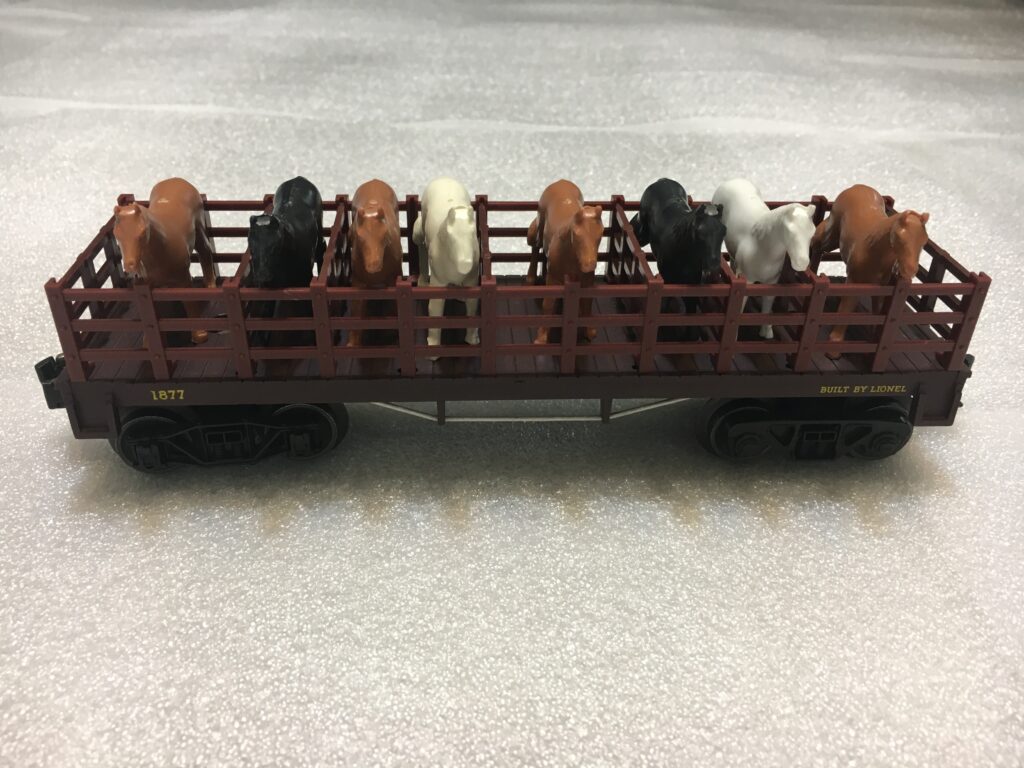
“#1877 General flatcar with at least six plastic horses, brown plastic flatcar with gold heat-stamped lettering.”
The #1875W “Western & Atlantic” Super “0” passenger coach was painted yellow and has a simulated wooden construction side with a brown painted roof. The tender in this set was so small, it could not house the mechanized air-chamber whistle. As a result, Lionel installed the air-chamber whistle into this passenger coach and added the “W” to the number of the car to indicate that the whistle was installed inside this passenger coach. This passenger coach also had two windows cutouts on each side to allow for air from the whistle mechanism to escape. This passenger coach had illumination and came with brown heat-stamped lettering, simulated truss rods installed underneath the coach and self-centering couplers at both ends of the passenger coach.
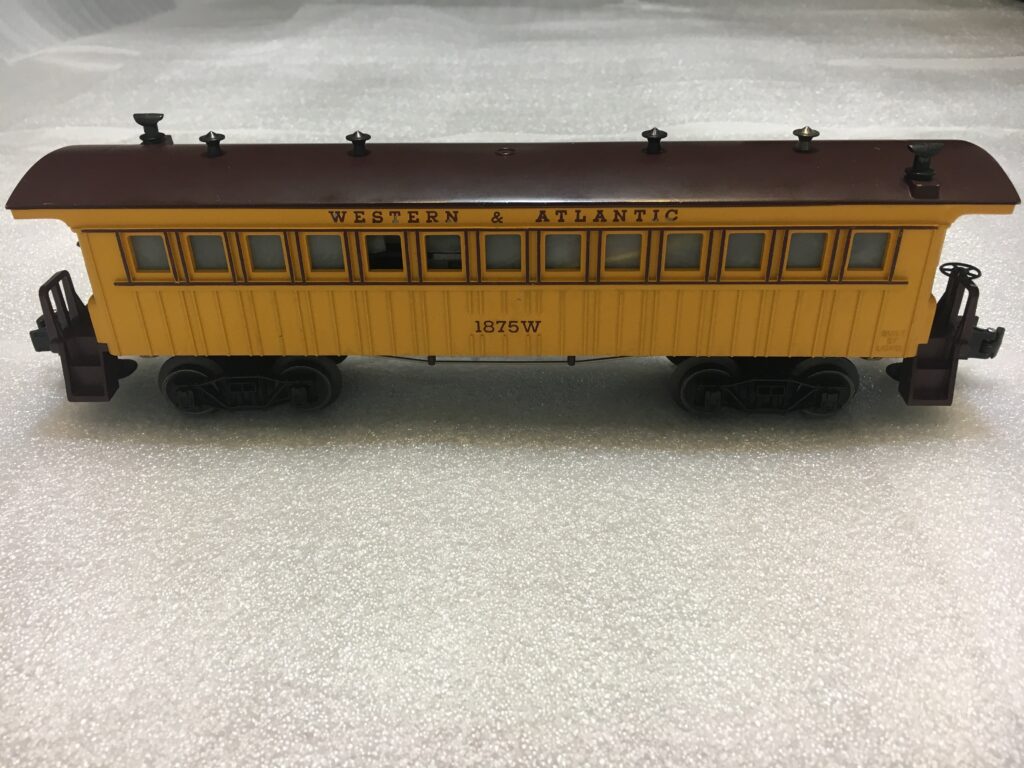
“#1875W “Western & Atlantic” Super “0” passenger coach with illumination. Two self-centering couplers and stainless wire truss rods under the body of the coach were included. Installed inside the passenger coach is the mechanized air-chamber whistle.”
The #1876 “Western & Atlantic” Super “0” Mail-baggage combination passenger coach was painted yellow and has simulated wooden construction side with a brown painted roof. An attractive American golden eagle and flag decal is centered on each side of the passenger coach. It has illumination, brown heat-stamped lettering, opaque window shell, two smokestacks and two roof ventilators, wire truss rods under the body of the coach, arch-bar trucks, brake wheel at each end and a self-centering operating coupler at each end of the passenger coach.
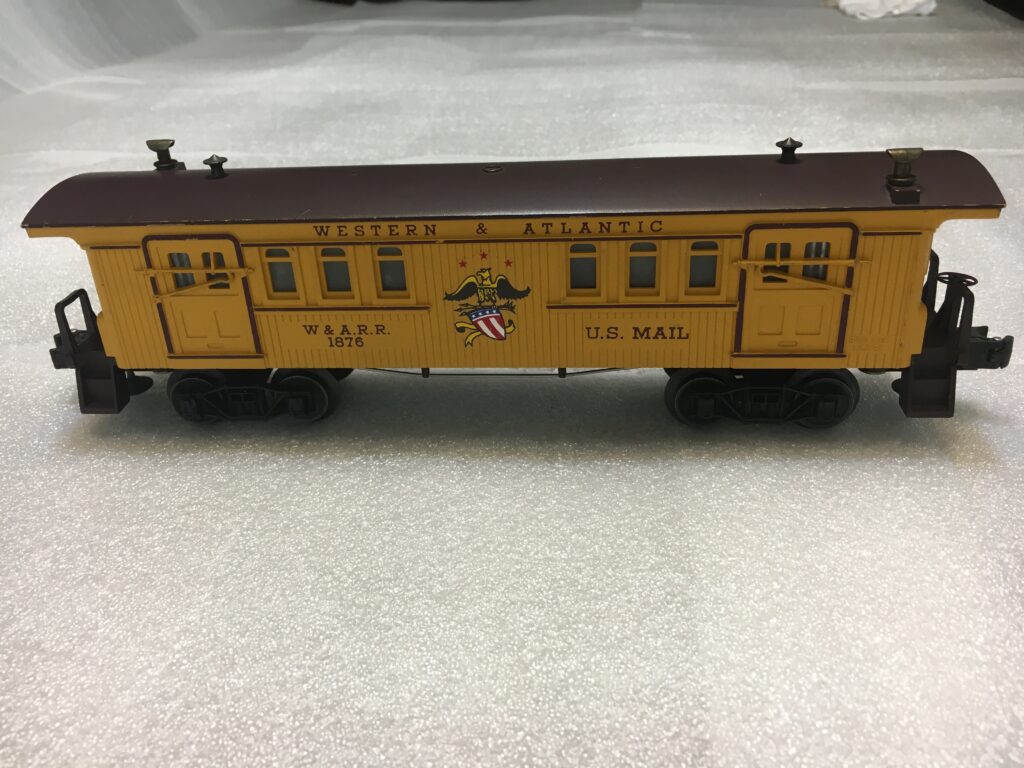
“1876 “Western & Atlantic” Super “0” Mail-baggage combination passenger coach with American golden eagle and flag decal in center of each side. This passenger coach comes with illumination, two smokestacks and two roof ventilators, stainless wire truss rods under the body of the combination car, self-centering operating couplers and arch-bar trucks.”
Finally, sold only as a separate sale item by Lionel and never included in the Super “0” Gauge General locomotive set is the #1875 “Western & Atlantic” Super “0” passenger coach. It was painted yellow with simulated wooden construction side and a brown painted roof. It had illumination, an opaque window shell (with no cut outs), two smokestacks and two roof ventilators, stainless wire truss rods under the body of the passenger coach and self-centering operating couples with arch-bar trucks. This passenger coach is RARE and is scarce to find. Most operators are looking for this separate sale passenger coach to add to their Super “0” Gauge General passenger set.
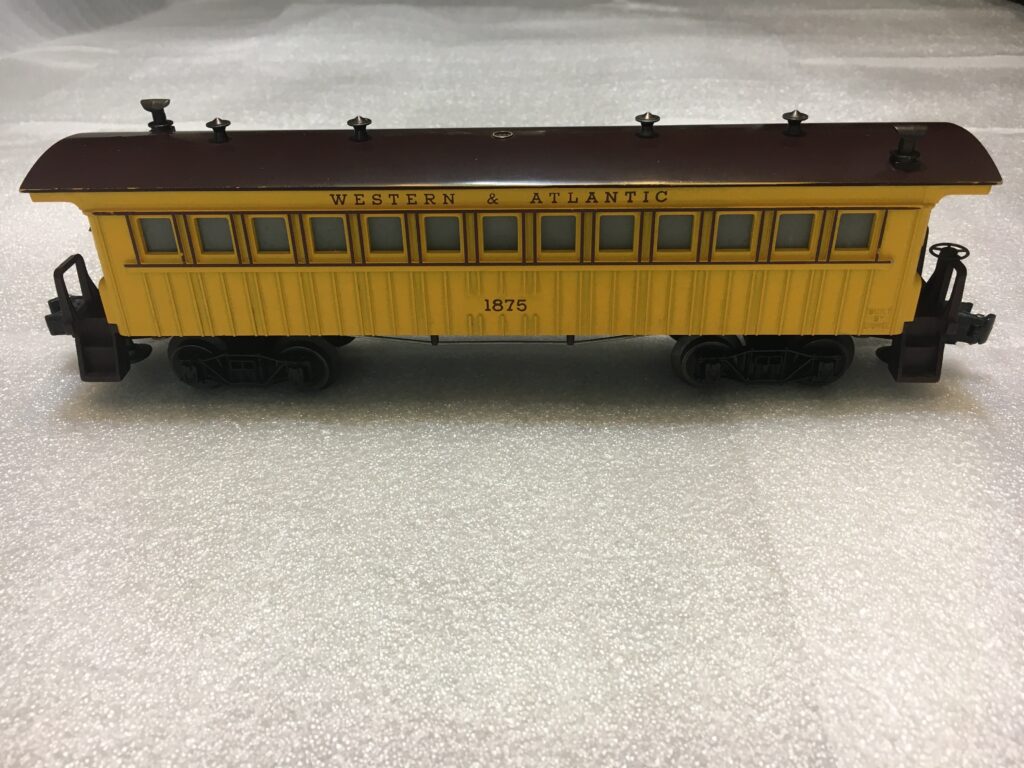
“#1875 “Western & Atlantic” Super “0” passenger coach with illumination, operating self-centering couplers and stainless wire truss rods under the body of the passenger coach. Sold ONLY as a separate sale item by Lionel and is very RARE!
June, 2023
Welcome to Jerry’s Collectors Corner:
Today’s feature: “#1862 4-4-0 Steam Locomotive known as “The General” was famous in the Civic War locomotive chase in 1862’’ (first of a series of three “General” Locomotive articles)”
Union civilian James J. Andrews, formerly from Kentucky worked for the Union Army during the early years of the American Civil War. He and approximately twenty men led a daring raid behind the Confederate enemy lines taking “The General” locomotive of the Western and Atlantic Railroad in an attempt to burn bridges and tunnels between Atlanta, Georgia and Chattanooga, Tennessee in 1862. This daring attack during the Civil War became known as “The Great Locomotive Chase.” The locomotive was stolen at Big Shanty, near Kennesaw, Georgia. They headed north destroying telegraph wires and tracks along their route in an attempt to discourage pursuers and render the railroad worthless and prohibit the confederate soldiers from attempting to provide supplies to the confederate troops in Tennessee. After an 87 mile chase, the “General” lost power. Andrews and his raiders then scattered, but they were captured, court-martialed and Andrews himself was sentenced to hang in one week. He escaped while in jail, but was later recaptured and hanged on June 7, 1862.
Lionel produced the first of three “General” 4-4-0 steam locomotives in 1959. This Lionel Train Set #1612 (“027” version) was manufactured for four years from 1959-1962. Lionel also produced the #1862 General locomotive in an #1800 set known as “The General Frontier Pack.” In 1956, Disney produced the movie known as “The Great Locomotive Chase” starring Fess Parker. This created a lot of excitement in the country about the “General” 4-4-0 steam locomotive and Lionel was extremely interested in capturing the national attention and engrossment this movie had created for trains. The #1862 4-4-0 steam locomotive was the first of three “General” locomotive sets produced by Lionel seeking to capitalize on the national interest this movie created in the country. (Subsequential articles will feature Lionel’s #1872 4-4-0 Steam Locomotive (“0” gauge variation) and the #1882 4-4-0 Steam Locomotive set known as the “Halloween General” (“027” variation).
The Lionel Train Set #1612 known as “The General Passenger Set” (“027” gauge variation) came in a yellow set box with a picture on the cover of the set box of the “The General” engine and the four cars offered in the set.

“The top and front panel of the yellow set box of the “1862” 4-4-0 Steam Locomotive and four cars”
The “1862 4-4-0 Steam Locomotive” had a painted gray plastic boiler and the cab and cowcatcher were both painted red. Both the engine and tender have metallic gold heat stamping lettering and striping. In addition, separately installed ornamental bell, steam dome and a sand dome were all painted gold. Very critical to the value and desirability of this engine is a complete and unbroken delicate unpainted black plastic whistle. This is the most fragile part of this steam locomotive and must be found in tack and complete. This locomotive also had a wire handrail that goes thru both the steam dome and the sand dome and connects around the front of the gray plastic boiler. In addition, this #1862 locomotive has an operating headlight and a two-position E-unit. It should be noted that this locomotive does NOT have MagneTration or smoke (as does the #1872 steam locomotive which will be reviewed in a succeeding article). The #1862T tender has a green painted plastic body, gold heat stamped lettering and a simulated wood load composed of rubber. It also contains one non-operating coupler.

“#1862 4-4-0 Steam Locomotive with painted red cab and cowcatcher and the #1862T Green tender with simulated wood load.”
This set also contains three additional cars. The first is the #1877 “General” Flatcar with six plastic horses (two black, two tan and two white horses). The body is molded in brown plastic and painted brown with yellow heat-stamped “1877” on the left side of the flatcar and “BUILT BY LIONEL” on the right end of the car side. There are also two wired truss rods installed beneath the car and this flatcar comes with arch-bar trucks. A ten section plastic fence keeps the horses standing up on the flatcar.
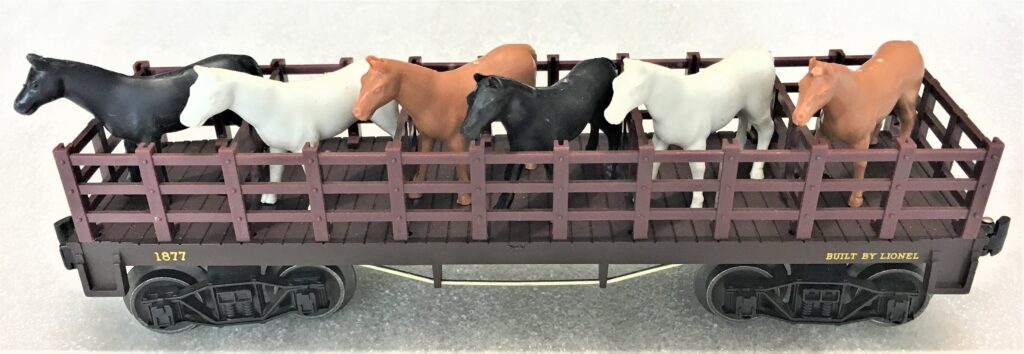
#1877 “General” flatcar with SIX horses, painted brown plastic flatcar with gold heat-stamped lettering.
The next car in this set is the “#1865 Western & Atlantic” coach car”. This coach car had a simulated wooden body which was painted yellow and the roof was a painted brown plastic. The lettering was a heat-stamped brown and the coach car was numbered “1865”. This coach car was non-illuminated and had 2 non-operating couplers. The truss rods were made of stainless wire and decorated the underbody of the car.

“#1865 Western & Atlantic” coach car” with 2 non-operating couplers and stainless wire truss rods under the body of the car.”
Lastly, the final car in this set is the “#1866 Western & Atlantic” mail-baggage combination car”. It also had a simulated wooden body painted yellow with both a painted brown roof and brown heat-stamped lettering. Unique to this combination car is the “Western & Atlantic” American golden eagle symbol decal in the middle of the side of the mail-baggage car. The mail-baggage car was non-illuminated and had 2 non-operating couplers. Its truss rods were made of stainless wire and decorated the underbody of the combination car.
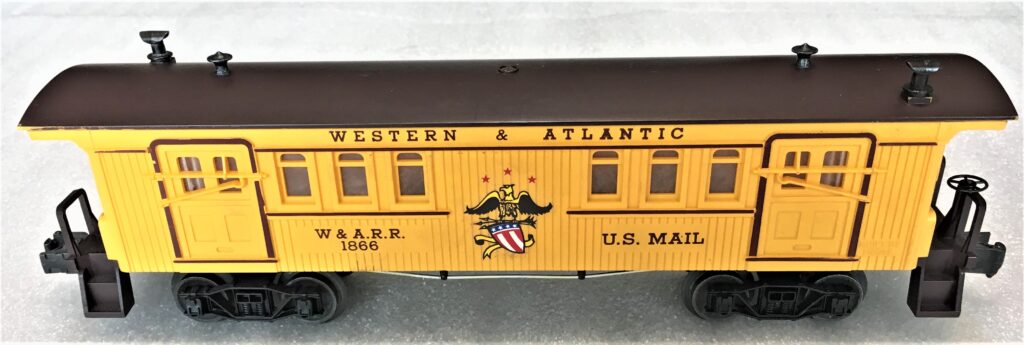
“#1866 Western & Atlantic” mail-baggage combination car with the American golden eagle symbol decal in the center of the car. It has 2 non-operating couplers and stainless wire truss rods under the body of the combination car.”
Walt Disney Productions in 1956 produced the movie, “The Great Locomotive Chase,” starring Fess Parker, Jeffrey Hunter and Granville Owen. This movie is the true story depicting James J. Andrews and his Union spies stealing a “General” train from under the noses of 4,000 Confederate troops, which began the great locomotive race which could have caused an early end to the civil war. This movie is rated as one of the six best train movies ever produced!
As indicated before, the next two articles in this series will feature the #1872 4-4-0 Steam Locomotive General set (“O” Gauge variation) and the #1882 4-4-0 Steam Locomotive General set known as the “Halloween General” set (“027” Gauge variation).
May, 2023
Welcome to Jerry’s Collectors Corner:
Today’s feature: “New Haven” Delights: #2242 New Haven F3 Diesel and #6468-25 New Haven Automobile Cars (3 variations)
Most collectors and operators obviously enjoy acquiring the “6464” series of Lionel Postwar boxcars. Closely behind this goal is the purchase of the various F3 diesel locomotives. The most sought after F3’s would be any of the 3 major “Santa Fe” F3 diesels. However, obtaining and securing a “Quality” #2242 New Haven F3 diesel is obviously a close second. The checkerboard paint scheme is so unique and exceedingly desirable, most collectors and operators seek to add this “New Haven” #2242 F3 Diesel to their train collection.
The ”New Haven” #2242 F3 Diesel was manufactured for only two years (1958-1959). This F3 included orange heat-stamped lettering on the sides of the diesel and a white “NH” heat-stamped lettering on the nose of the diesel. The reason I inject the description of a “Quality” New Haven F3 diesel is that the silver paint on the Lionel postwar trains is so easy to scratch, smear or even just a single finger print will permanently degrade the silver. As a result, this vastly contributes to the challenge of adding this F3 diesel to your train collection.
The unique 4 colors of silver, white, black and orange in a specialized checkerboard pattern definitely adds a great deal of appeal and presents a color painting scheme totally unique to the New Haven F3’s. The New Haven F3’s has a pair of one-piece ornamental horns, an operating headlight, operating horn, MagneTraction and an operating front coupler. In addition, the die-cast frame is painted silver, the pilot casting is painted black and it has chemically blackened sideframes. Lastly, this F3 has closed portholes and a louvered roof.
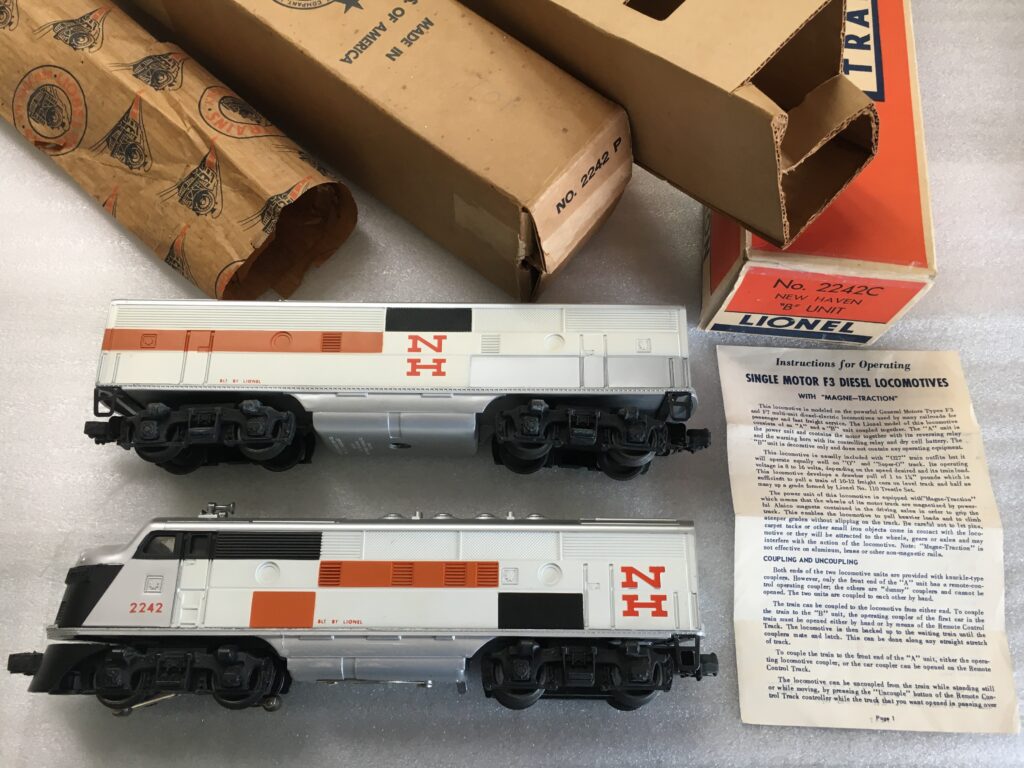
Side view of the 4 color “Checkerboard” painted #2242 New Haven F3 Diesel and original boxes.”
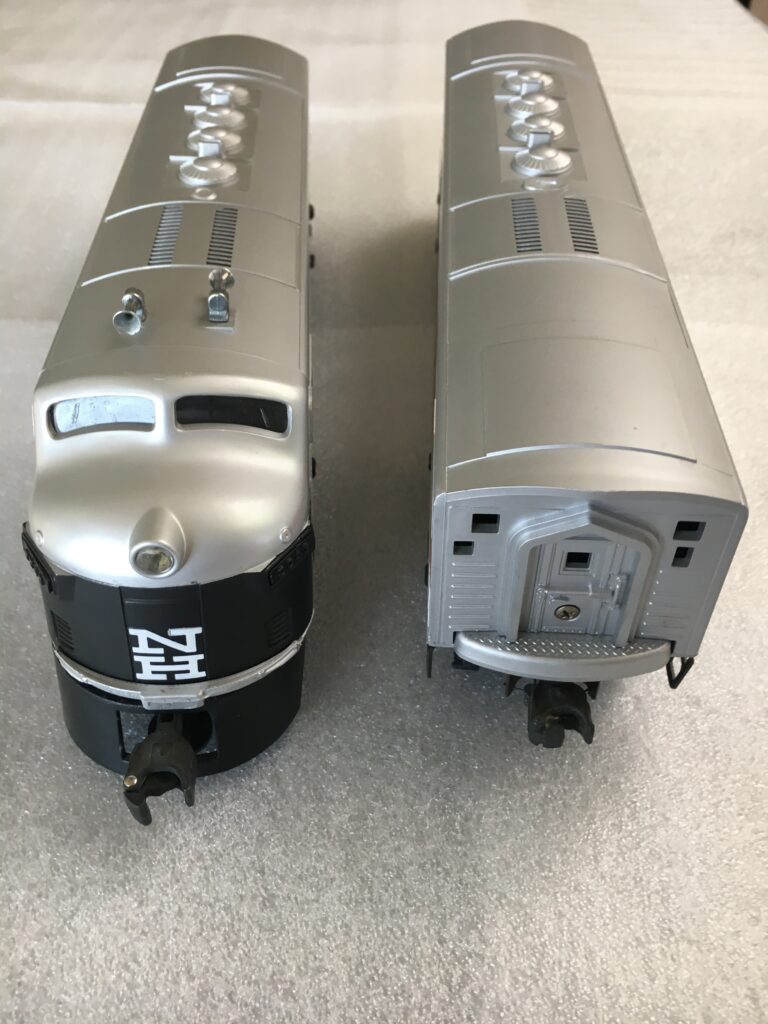
“ Front view of the #2242 New Haven F3 Diesel with white heat-stamped “NH” lettering on the nose and showing the louvered roofs on both the A and B units”
Postwar Lionel never produced a New Haven caboose. However, there are three distinctive variations of the #6468-25 New Haven double-door automobile cars which were manufactured during a three year period (1956-58). There are two basic types of the New Haven double-door automobile car. They are the Type I car which was produced with two different paint schemes on the large “N” and a single variation for the Type II car to be described later in this article.
The #6468-25 New Haven double-door automobile car has different heat-stamping on EACH side of the car. This is not the case for typical boxcars which most often has identical stamping on each side of the boxcar. When looking at the left side of a double-door automobile (left side defined as the side you are looking at when the brake wheel is to the LEFT at the top of the roof), the #6468-25 New Haven double-door automobile car Type Ia comes with a big black “N” heat-stamped to the left of the unpainted black plastic double-doors. There is a white “BLT 3-56/By Lionel” heat-stamped to the left of the doors at the bottom of the side. There is no other data printed to the left of the double-doors. Also, the second column of rivets to the left of the double-doors has three rivets at the top and two rivets at the bottom of the column. To the right side of the black double-doors at the top portion of the shell, the automobile car has “New Haven” heat-stamped in black. In addition, the shell is heat-stamped “NH 646825” all in white and has 4 columns of data also heat-stamped in white. On the opposite side (or what is described as the right side of the car) when the brake wheel is to the right at the top of the roof, the “New Haven” is in black and the “NH 646825” again is in white heat-stamping. On the right side, the big black “N” is heat-stamped with a black full serif “N” and a white full serif “H” below. Again, near the bottom the “BLT 3-56/By Lionel” is heat-stamped all in white. This car was produced as an unpainted orange plastic body with bar-end metal trucks and operating magnetic couplers at both ends.
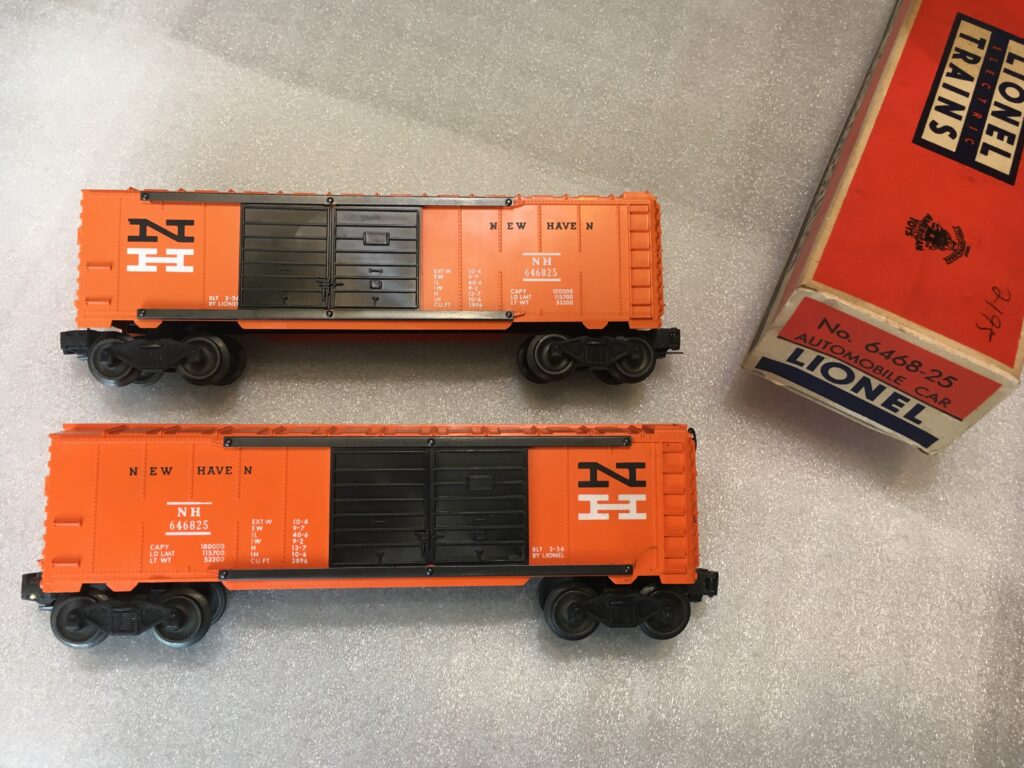
Top car is the “#6468-25 New Haven double-door automobile car Type Ia with a big black full-serif “N” to the left of the unpainted black plastic doors (left side of car). The bottom car is the same “646825 New Haven double-door automobile car Type Ia with the big black full-serif “N” to the right of the unpainted black plastic doors (right side of car)”
The #6468-25 New Haven double-door automobile car, Type Ib car is identical to the previous car except for two changes. The first one is obvious, the large black “N” has a half-serif heat-stamped letter and the only other difference is the orange plastic shell is a lighter orange color.
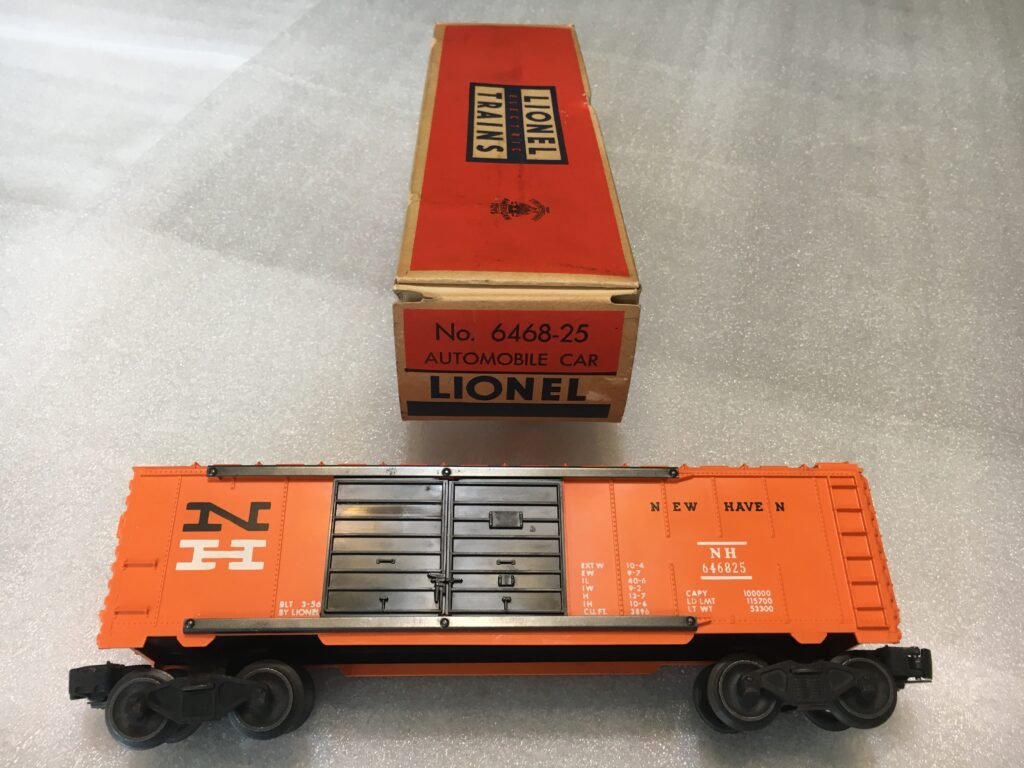
“#6468-25 New Haven double-door automobile car Type Ib with a big black half-serif “N” and lighter orange unpainted plastic shell. “
The last variation of the “6468-25 New Haven double-door automobile car, TypeII is identical to the previous car except the big “N” is heat-stamped in white and is a half-serif letter. This variation of the New Haven double-door automobile car is the RAREST of all! It has a Rarity rating of a 6!
Look for this white “N” heat-stamped to the right of the double-doors variation because it is so rare and many collectors may miss spotting this variation when attending a train meet. It is also good to quickly check for these automobile cars when attending a train meet, you may spot this rare variation and be able to actually find this variation at a reasonable price!!!

“6468-25 New Haven double-door automobile car, Type II with the big WHITE half-serif “N” to the right of the unpainted black plastic doors.”
Oh, thank heavens for the “New Haven” Delights!
April, 2023
Welcome to Jerry’s Collectors Corner:
Today’s feature: #6427 “Lionel Lines”, #6437 “Pennsylvania”, #6447 “Pennsylvania” & #6457 “Lionel” Cabooses (#6400 Postwar Series Cabooses)
For the most part, the #6400 Postwar series cabooses are quite common and most came illuminated. They were relatively inexpensive, and have bright white heat-stamped lettering. However, there is one major caboose in this series which is an exception and it is both extremely rare and is NOT illuminated. This caboose commands a high purchase premium and is intensely sought after by most collectors and could be a major discovery for you when attending a train meet. I will be discussing this caboose later in the article.
Now let’s take a deeper look at the #6400 postwar series of Lionel cabooses.
The first in this series of cabooses is the #6427 “Lionel Lines” caboose, Type 1.
This N5C porthole type caboose was manufactured in the “Lionel Lines” road name (& “Pennsylvania” road name, not pictured), and was produced for six years (1954-57, 1959-60). It had a painted Tuscan shell with white heat-stamped lettering, bar-end metal trucks, single operating couple, interior illumination and came with a clear plastic window insert. However, the number heat-stamped on the sides was the 5 digit number “64273”.
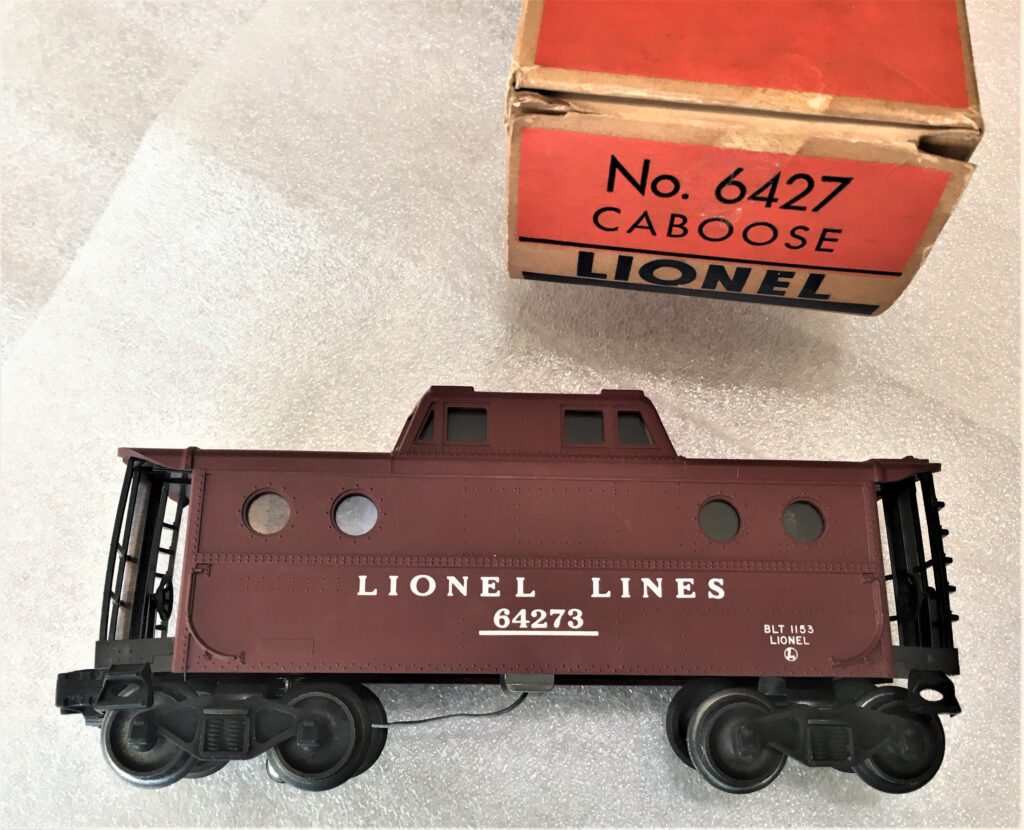
“6427 “Lionel Lines” N5C caboose, Type 1, with a single operating coupler and clear plastic window insert.”
The next variation is the #6427 “Lionel Lines” caboose, Type 2. It is identical in everyway to the Type 1 except it was produced with two operating couplers. Obviously, this variation is preferred by operators when running their trains and making connections on their layouts.
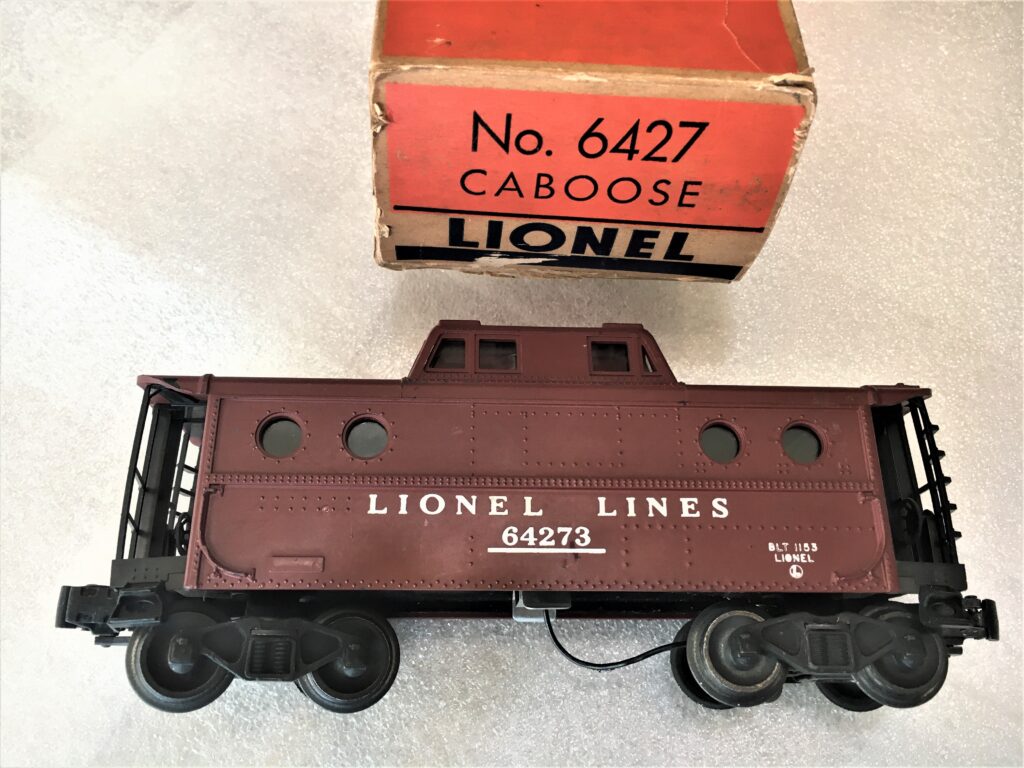
“#6427 “Lionel Lines” N5C caboose, Type 2 with an operating coupler at each end of the caboose and with a clear plastic window insert.”
The next caboose in this series is the #6437 “Pennsylvania” N5C caboose. This N5C porthole type caboose came in both “Pennsylvania” and “Lionel Lines” (not pictured) road names. They were manufactured for 8 years (1961-1968). It came with a painted Tuscan shell and with white heat-stamped lettering, two operating couplers, interior illumination, a clear plastic window insert, but with AAR type trucks. Also, the original box for this car was a clear plastic type window box made by Lionel.
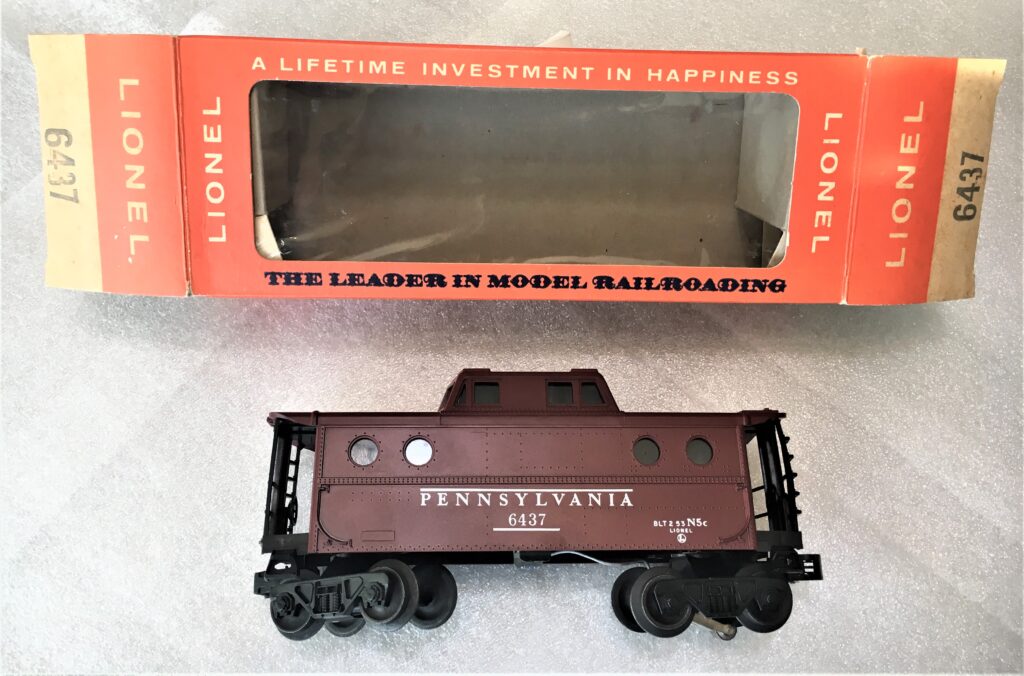
“#6437 “Pennsylvania” N5C caboose with two operating couplers, interior illumination, a clear plastic window insert, AAR-type trucks and a Lionel window type box.
As mentioned early, the tremendously desirable and vastly coveted caboose in this series is the #6447 “Pennsylvania” N5C caboose. It was produced for only one year in 1963 (and came as a single item in one Super “0” set). It is extremely RARE and has a Rarity Rating of a “7”. Interesting enough, it is the only caboose in this series that was NOT illuminated. As a result, due to the following four basic reasons, this caboose had a limited production run (Non-illuminated, offered only in a special single set, came with a single coupler and manufactured for just one year), and very few of these cabooses were actually manufactured by Lionel. This presents a real challenge for collectors to find. In addition, operators were not at all interested in this caboose because it was not lighted. That is why it is possible to find this very RARE caboose at a train meet because unsophisticated sellers are not aware of all of these conditions and it is possible to find this caboose at a reasonable cost. Thus, keep it in mind, always watch for the #6447 Non-illuminated “Pennsylvania” caboose at your next train meet!

#6447 “Pennsylvania” N5C caboose with a single operating coupler, NON-lighted, a clear plastic window insert, AAR-type trucks and a regular Lionel type box.
The last in this series of #6400 cabooses is the #6457 “Lionel” cupola-type body caboose. This caboose was manufactured for five years (1949-1953) and was considered the top-of-line line caboose due to the white heat-stamped lettering (featuring the double-circle-L Lionel logo), interior illumination, clear plastic window insert, tall metal smokejack, two sheet metal ladders, black metal frame with battery boxes and two brake wheels. This caboose had a Tuscan painted body with a black die-cast smokejack and two operating couplers. This caboose is known as the Type 2 (and there is also a Type 1 black plastic smokejack caboose that can be found, but is not pictured).
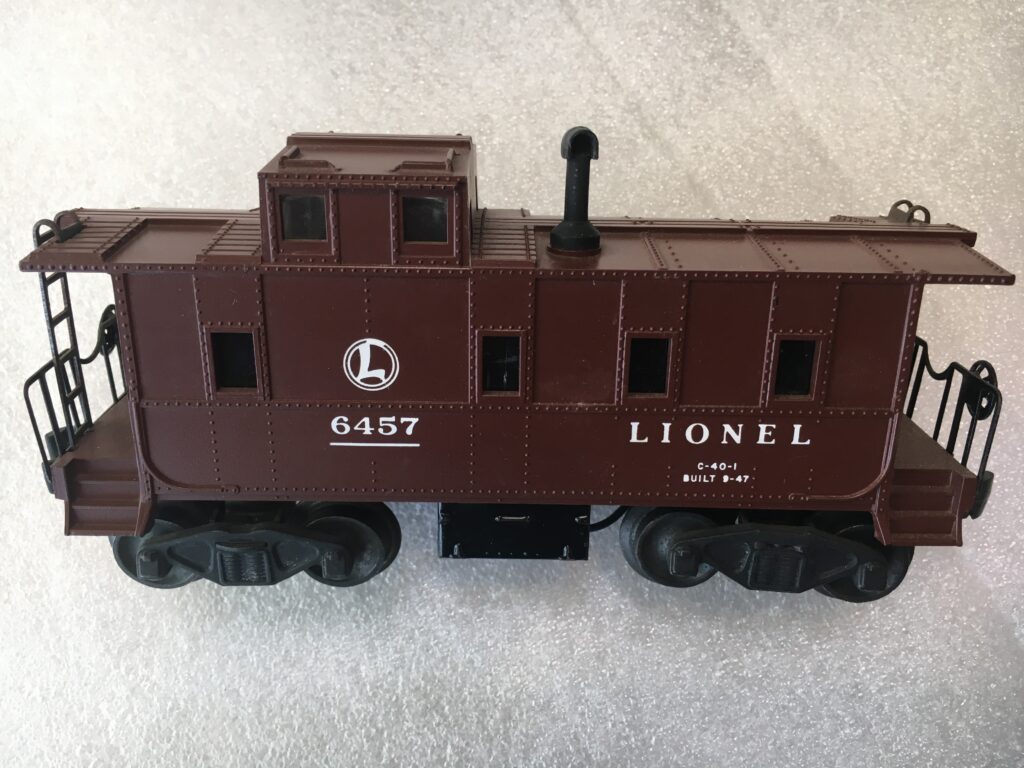
#6457 “Lionel” caboose, Type 2. It has a Tuscan painted cupola-type body which features white heat-stamped lettering with the double-circle-L Lionel logo and interior illumination. This caboose has a clear plastic window insert and a tall black metal smokejack and a black metal frame with battery boxes.
While operators always prefer cabooses with illumination with dual operating couplers, the collectors always seek to add the RARE non-illuminated caboose to their collection. Enjoy finding all of these cabooses for your train collection!
March, 2023
Welcome to Jerry’s Collectors Corner:
Today’s feature: #6464-200 Pennsylvania & #6464-225 Southern Pacific Box cars
Within the 24 years of the Lionel Postwar period (1946-1969), the acquisition of the #6464 series box cars has always been highly desirable. This is true for both operators and collectors alike. This article will focus on two of the most sought-after and popular box cars in the #6464 series of box cars manufactured by Lionel.
The first #6464 box car we are going to examine is the #6464-200 Pennsylvania box car, Type A. It was produced for three years, from 1954-1955 and in 1969. There are three prominent variations of this box car. These variations had Tuscan painted bodies with white heat-stamped lettering and a Tuscan painted single-block doors and bar-end trucks. The first variation is known as Type A and had a shell with the Type I body mold and the built date “NEW 5-53” heat-stamped on each side of shell.
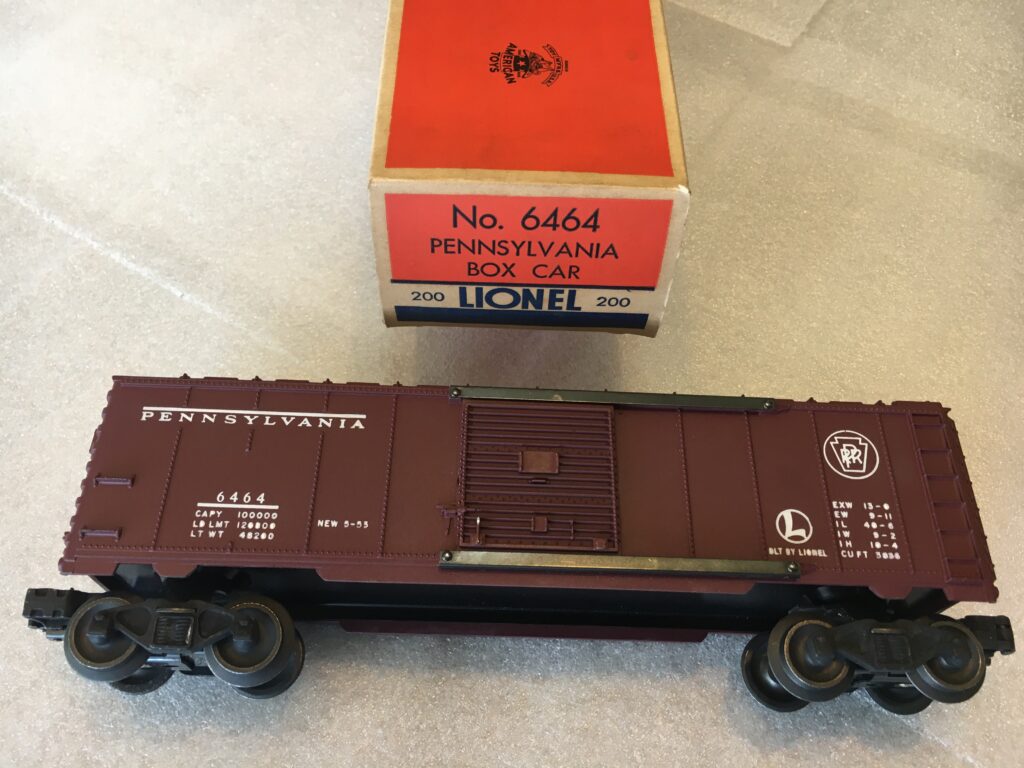
“#6464-200 Pennsylvania box car, Type A, with Type I body mold painted Tuscan and with white heat-stamped lettering and single-block doors.”
Next variation is the #6464-200 Pennsylvania box car, Type B. The shell on this variation had a Type IIa body mold, but otherwise was identical to the Type A variation.

“#6464-200 Pennsylvania box car, Type B, with a Type IIa body mold painted Tuscan and with white heat-stamped lettering and single-block doors.” (This photo is from the Lyle Leverich Collection)
The third variation was the #6464-200 Pennsylvania box car, Type C. This variation was produced only in 1969 and came with a Type IV body mold painted Tuscan and also had white heat-stamped lettering, single-block doors and came with an interior ribbed roof. But third variation was without the “NEW 5-53” built date stamping on its sides. It also came in the traditional Hagerstown Checkerboard type OB.
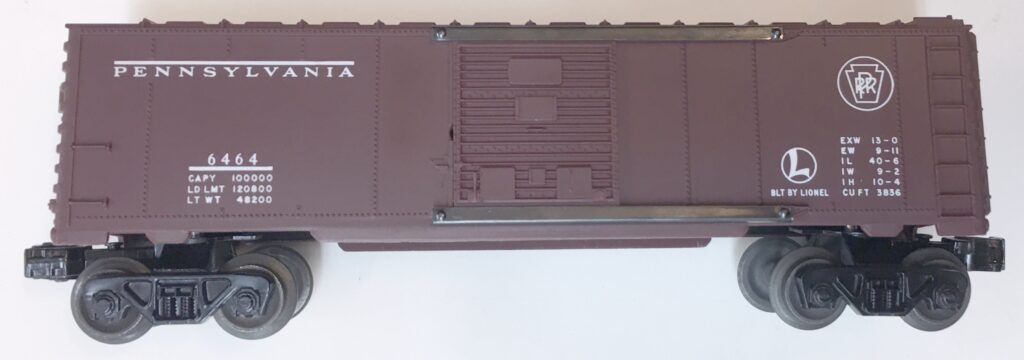
“#6464-200 Pennsylvania box car, Type C, with a Type IV body mold painted Tuscan with white heat-stamped lettering, single-block doors, ribbed roof, but without the “NEW 5-53” built date stamping.” (This photo is from the Lyle Leverich Collection)
Let’s look at the #6464-225 Southern Pacific box car. It was also only produced for three years, from 1954 thru 1956 (but no late 1969 variation was produced for this #6464 box car). The vast majority of this series #6464 box cars came only with a Type IIa body mold, black painted body with both white and yellow rubber-stamped lettering, black painted single-block doors and bar-end trucks. The “S.P.” lettering was rubber-stamped only in white while the “Southern Pacific” logo was rubber-stamped only in yellow. This box car also had a stylized “Overnight” arrow in both yellow and red rubber-stamping. This was a beautifully designed car and highly desirable to acquire.
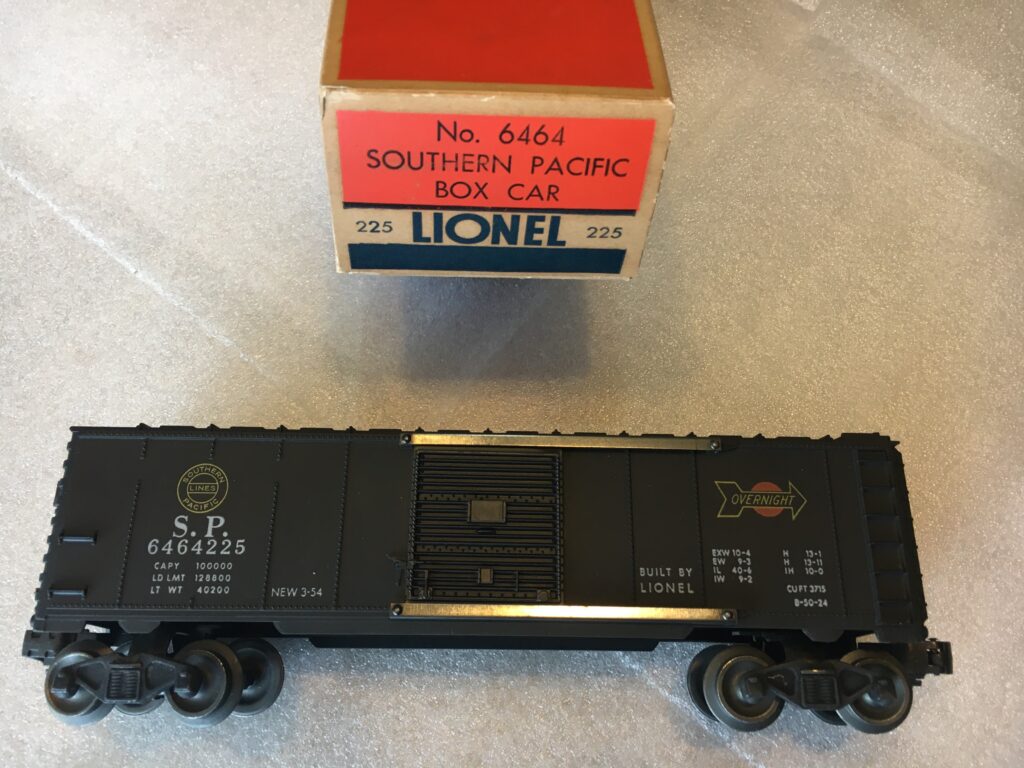
“#6464-225 Southern Pacific box car with a black painted body, black painted single-block doors and bar-end trucks. The body mold was a Type IIa. This box car had white, yellow and red rubber-stamping logos on the sides.
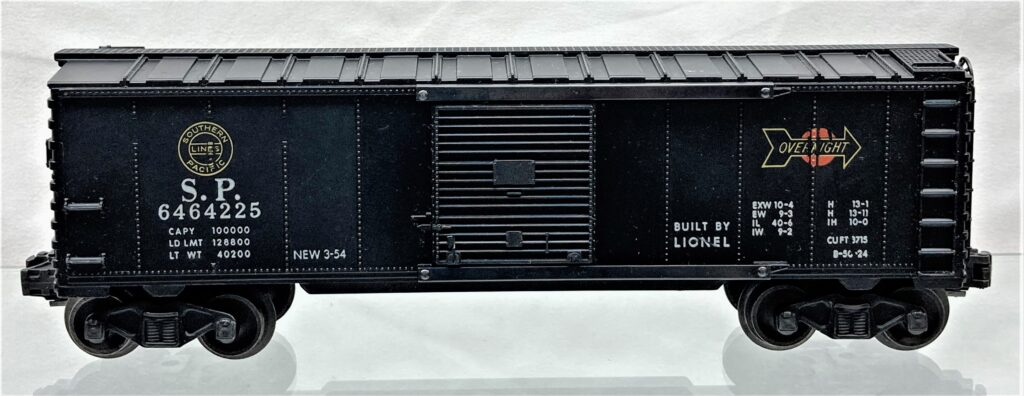
Pictured is a RARE #6464-225 Southern Pacific box car with a Type I body mold.
February, 2023
Welcome to Jerry’s Collectors Corner:
Today’s feature: “#773 Steam Locomotives, 4-6-4 (1950 and 1964 variations)”
In the 24 years of the Lionel Postwar period (1946-1969), the #773 Steam Locomotive (4-6-4) is the most sought after Lionel train piece of the entire Lionel Postwar period. This engine has the greatest demand to acquire in order to add to one’s collection. It is the single addition for any operator or collector’s train collection that truly brings satisfaction when obtained. A number of train videos available on the internet features the #773 Steam Locomotive (4-6-4) which enhances the already strong desire to take possession of this steam engine and intensifies the passion to expand everyone’s train collection by both operators and collectors. No Lionel train collection will ever feel complete until the #773 Steam Locomotive (especially the 1950 variation) SET is acquired and added to one’s train collection. This is why I believe that the #773 Steam Locomotive is the “Holy Grail” of the Lionel Postwar trains. (“The train that is being earnestly pursued or sought after!)
Many feel that the #773 Steam Locomotive (4-6-4) is rare, that simply in my opinion is not true. However, due to the very high demand for this steam engine, there is not a single other Lionel train piece that matches or exceeds one’s desire to possess than this steam engine. The #773 steam locomotive (1950) is a beautifully designed New York Central-type Hudson that has a black painted die-cast body with a silver rubber stamped cab number.
The #773 Steam Locomotive was produced only for one year in 1950. It was later again manufactured for three years from 1964 thru 1966. The 1964 variation has three different types of tenders that offer a variety to the 1964 style produced #773 engine.
Now let’s look at both the 1950 and 1964 productions of the #773 steam locomotive and the three tender variation of the 1964 produced #773 steam locomotive.
In 1950, the #773 Steam Locomotive (4-6-4) was produced in honor of the 50th Golden Anniversary of the Lionel Corporation. This steam locomotive came with the new “MagneTration” feature, smoke unit, enhance die-cast boiler that was painted black and was decorated with a moveable ornamental bell. It also has a whistle, wire handrails, hexagonal based flagstaffs on a pilot beam and an operating headlight. I want to also point out that a key feature of an original 1950 #773 steam locomotive has the silver rubber-stamped number beginning slightly to the left of the 4-window cab feature. Many of the #773 professional restorations or repainted steam engines have the silver rubber-stamping number beginning slightly to the right of the 4-window cab. This is an important distinction since the true value of a repainted 1950 steam locomotive is much less than the value of a LN+ or MINT original #773 steam locomotive set.
The #773 Steam Locomotive came with the #2426W semi-scale whistle tender. This tender was rubber stamped “Lionel Lines” in silver and had wire handrails both on the front of the tender and the back half top of the tender. The #2426W tender was discontinued after this one year of production. That is why a matching pair of the original #773 steam locomotive (1950) and the #2426W tender is important to have and is truly desired by both operators and collectors alike.
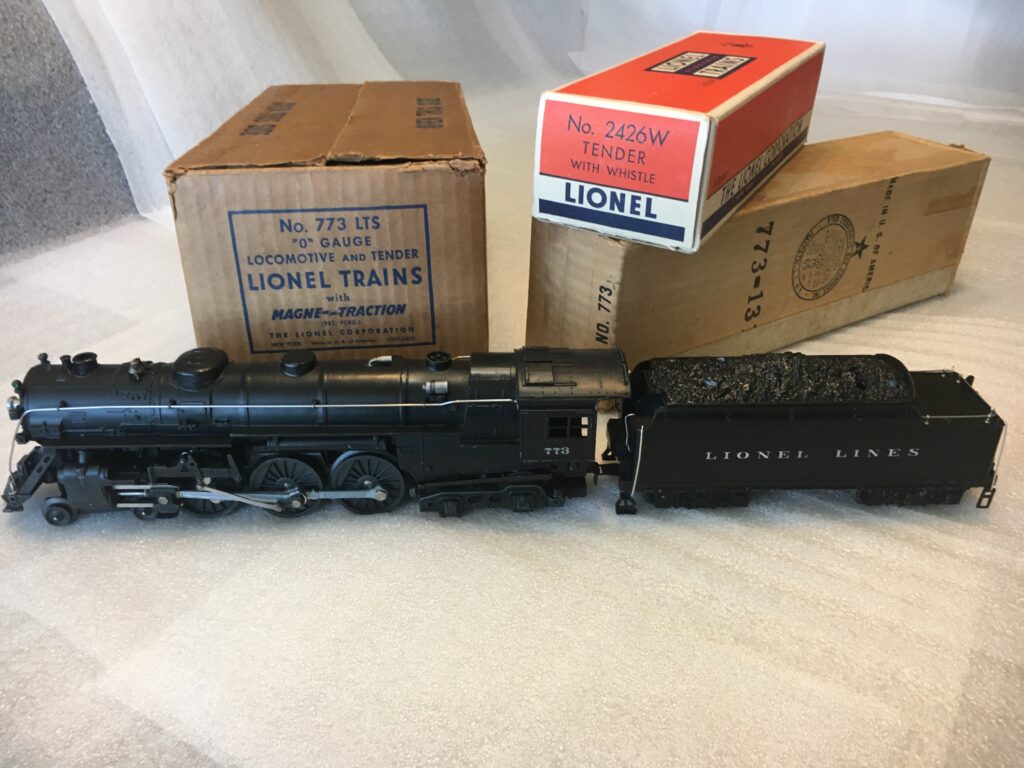
“#773 Steam Locomotive (4-6-4) and #2426W “Lionel Lines” tender with wire handrails, original boxes and master carton. The #773 Steam Locomotive SET is the “Holy Grail” of the Lionel Postwar period.”
The first of three tender variations for the 1964 produced #773 Steam Locomotive (4-6-4) came with the #736 steam lined “Pennsylvania” tender. It was lettered in white, but the number boards were blank. The back up lights portholes were molded shut on this tender body. Interesting fact is that many of these #736 tenders were assembled with their water scoops incorrectly installed facing backwards. However, another variation finds that some were assembled as designed correctly for the 736 steam locomotives manufactured between 1960 thru 1968.

“#736W tender with “Pennsylvania” stamped in white lettering to accompany the 1964 version of the #773 Steam Locomotive. Some of these tenders had their water scoops incorrectly installed facing backwards”
Finally, #773 Steam Locomotive (4-6-4), 1964 variation came with the #773W tender (usually found with a #736W Tender OB). This tender was stamped in white with the lettering “New York Central”.
The #773 Steam Locomotive (4-6-4), 1964 variation is stamped distinctively different on the cab from the 1950 variation. The white rubber stamped number on the cab is typically LARGER on the 1964 variation than on the 1950 variation. The 1964 engine original box is stamped in red (instead of the typical black lettering) and is numbered #773-131. This steam locomotive and the #773W “New York Central” tender are highly desirable, but not as sought after as the original 1950 variation set described above.
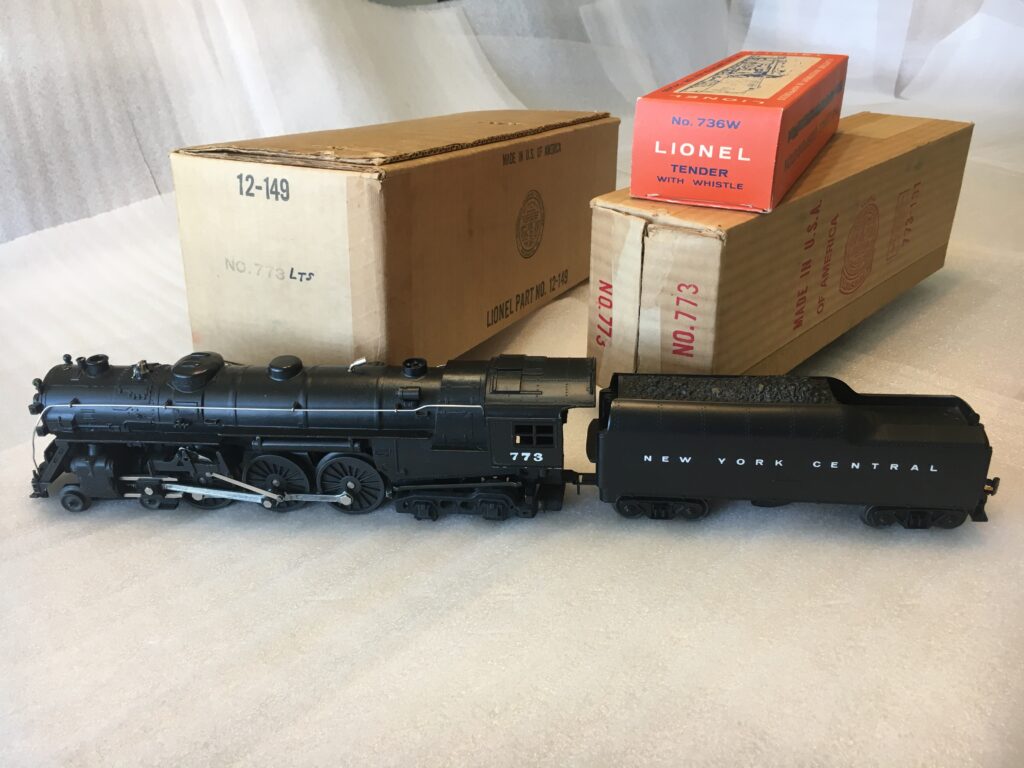
“#773 Steam Locomotive (4-6-4) with larger white lettered stamped “773” on the cab and the white lettered #773W tender stamped “New York Central” with the Red imprinted original engine box, original orange #736W tender box and the 1964 master carton”
I wanted to include in the same picture both the 1950 and 1964 #773 Steam Locomotive (4-6-4) Sets for close up examination. Look carefully, in this last picture, the 1950 #773 set is pictured (top) with smaller SILVER stamping as compared to the 1964 #773 set which has larger number stamping and is in WHITE (not silver). Keep an eye out for obtaining either or both #773 Steam Locomotive Sets, they can be found at train meets, from friendly collectors or at many of the train auctions. Enjoy, it will be a great addition to your train collection!
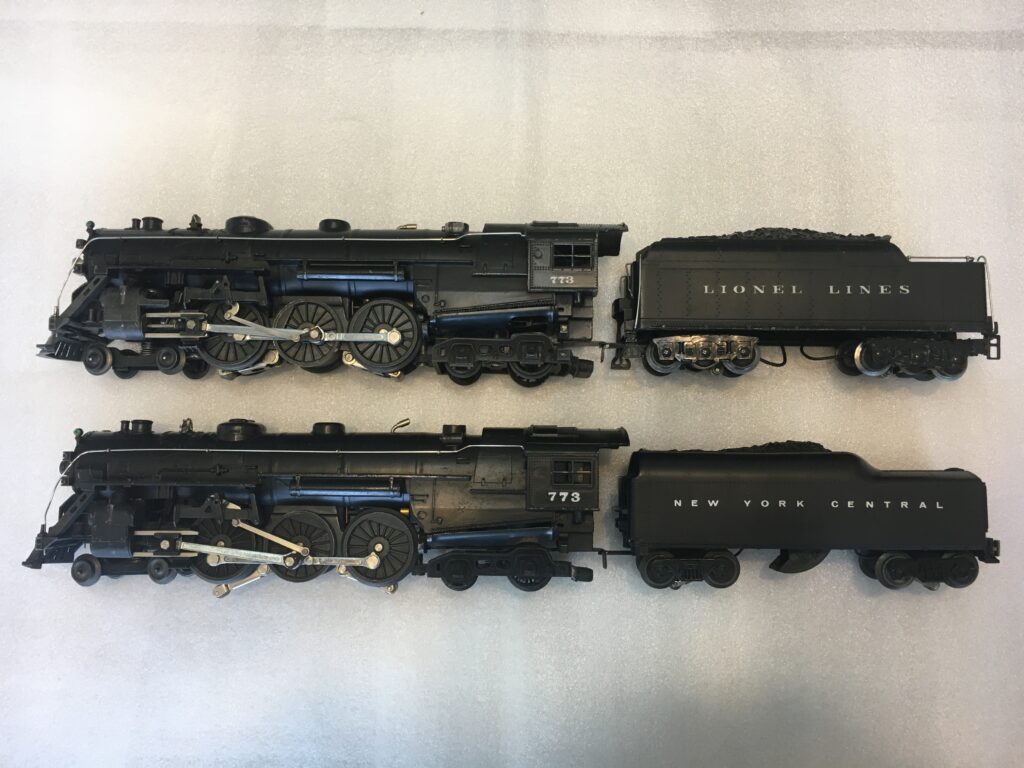
“#773 Steam Locomotive (4-6-4), 1950 variation (top set) with SILVER number stamping and the desirable #2426W tender with “Lionel Lines” stamped in silver. Below this is the #773 Steam Locomotive (4-6-4), 1964 variation with larger WHITE stamping of the #773 number and the #773W tender with “New York Central” stamped in WHITE.”
January, 2023
Welcome to Jerry’s Collectors Corner:
Today’s feature: “Action Pack #3370 and #6473 Operating Cars”
These two action pack operating cars uniquely provide continuous operation/animation when operating a moving train on a layout. Big smiles from all spectators and excitement in the train room are always evident when either one or both of these cars are connected on to a moving train on a layout.
The operating #3370 Wells Fargo Animated Sheriff and Outlaw Car was produced by Lionel for four years, from 1961 thru 1964. This operating car was an unpainted dark green plastic shell with yellow heat-stamping. The stampings included the “Wells Fargo” lettering and the “Western & Atlantic” railroad lettering. It also featured two figures that automatically and smoothly popped up and down (alternating as the car goes down the train) simulating a bandit dressed with a blue shirt, mask, cowboy hat and pointing a gun and a sheriff dressed in a yellow shirt, brown cowboy hat and also pointing a gun. This continuous action always provided a lot of watchful eyes focused on the operating car as it transcends down the track. This car is one of the inexpensive cars produced by Lionel, but guaranteed a great deal of viewing interest when operated on a moving layout.
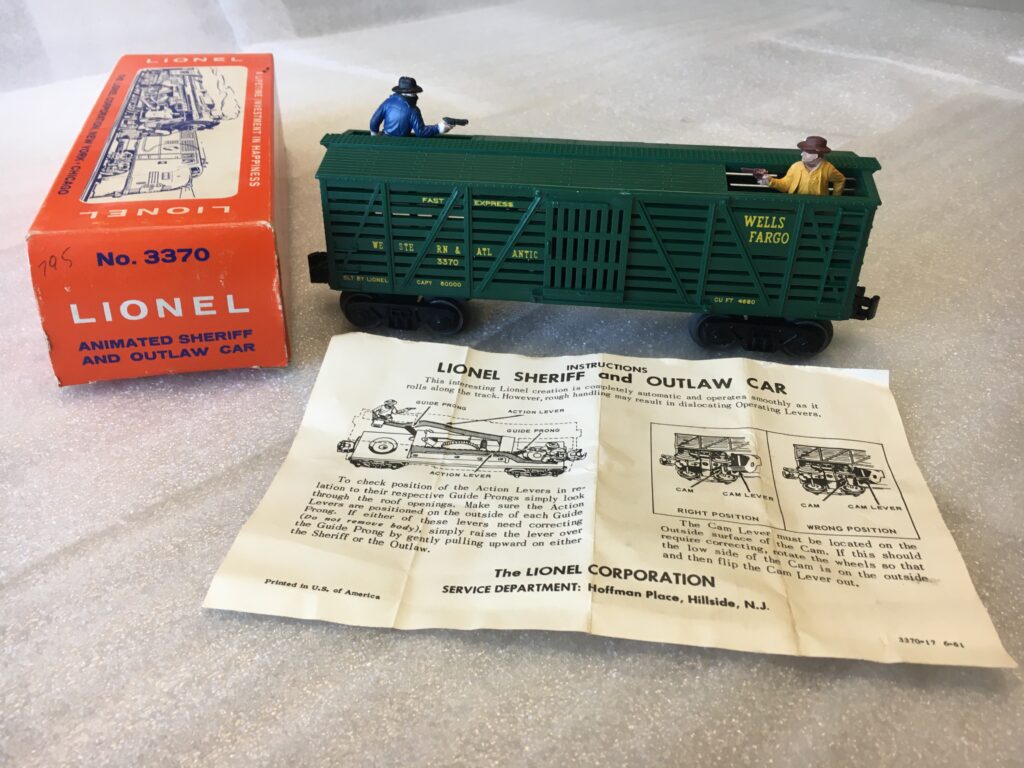
“#3370 Wells Fargo Animated Sheriff and Outlaw Car featuring both a shooting sheriff and shooting bandit”
The other action pack operating car is the #6473 Rodeo Car. It is commonly referred to as the “Horse Transport” car due to the four bobbing horse heads incorporated within the car. The rodeo stock car was produced by Lionel for six years from 1962 through 1966 and later reintroduce again in 1969. The four bobbing horse heads had two heads appearing thru a window on each side of the car, one was a brown plastic horse head and the other horse head was white. This car was an unpainted yellow plastic shell with either red or maroon hot stamped lettering. However, quite significantly, the unpainted yellow plastic shell came in extremely different yellow plastic coloring. One common type was a light yellow plastic shell and a very desirable type was the dark or mustard colored yellow shell. Since the coloring of the plastic shell was so different, I have included a picture of each type and then a picture of both types together in order to show the demonstratively difference in the coloring of the plastic shells.
This action pack operating car was also a lot of fun running on a layout. The bobbing horse heads usually drew everyone’s attention when this car was included on an operating train rolling down the track. Younger children especially enjoy seeing this car operated on a layout.
Lastly, watch for the mustard colored shell rodeo car at a train meet or train auction. They can be found and these operating cars provide a lot of fun and attention for a train on a running layout.
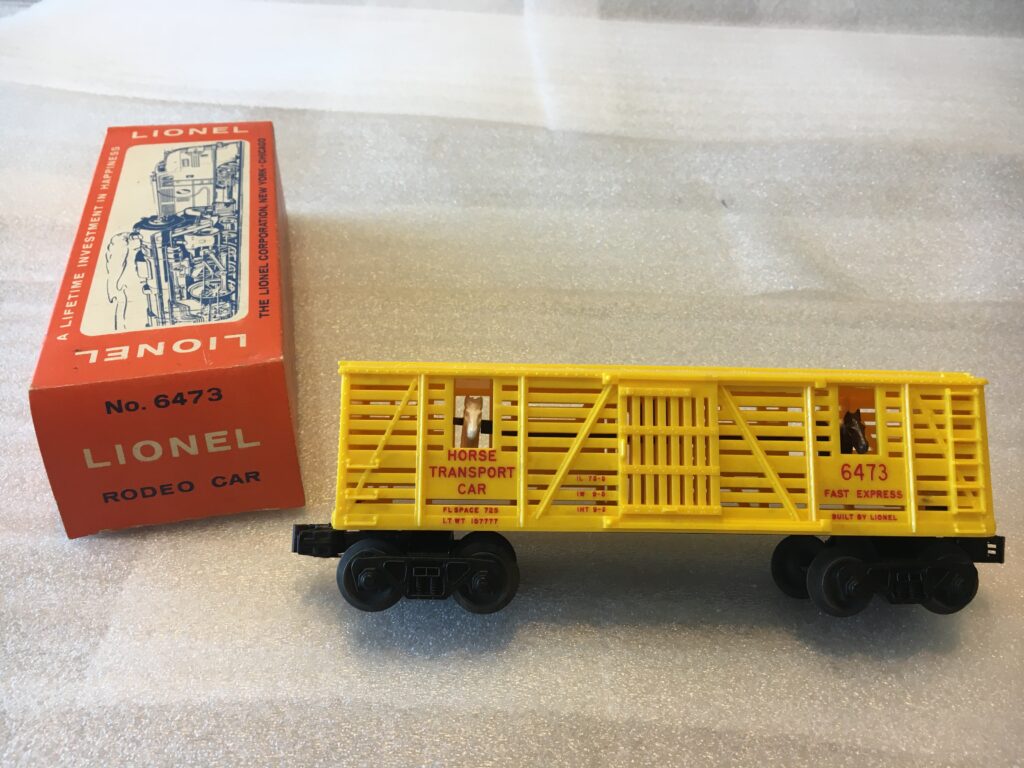
“#6473 Rodeo Car, Type I with a light yellow plastic shell.”
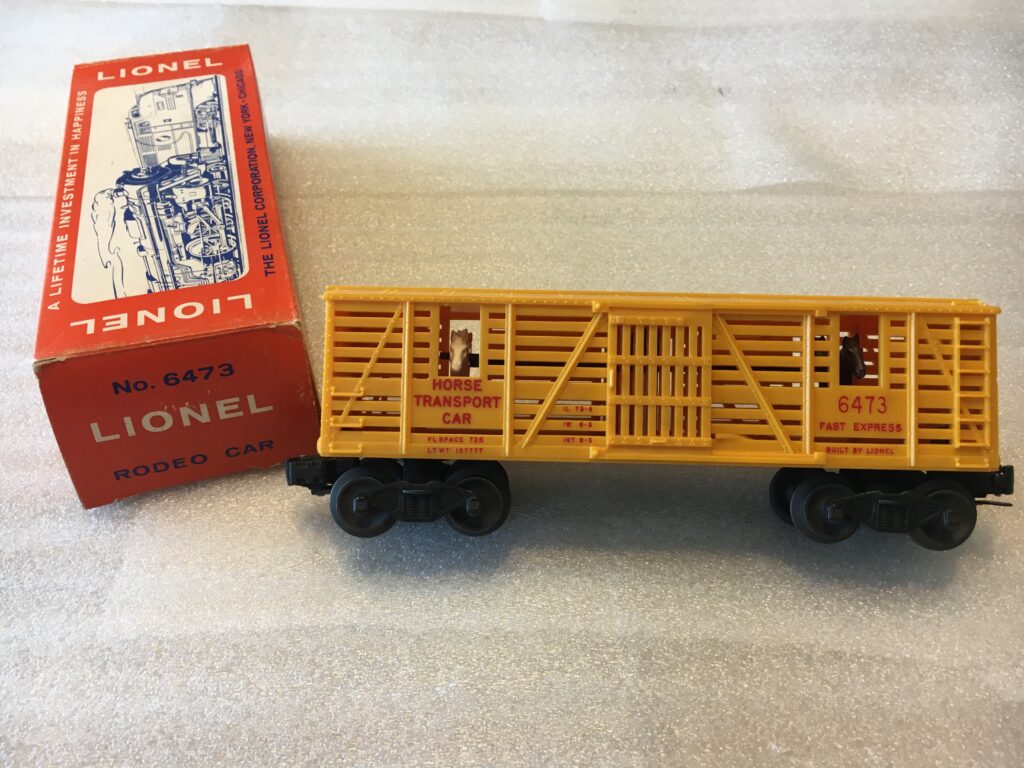
“#6473 Rodeo Car, Type II with a dark mustard plastic shell.”
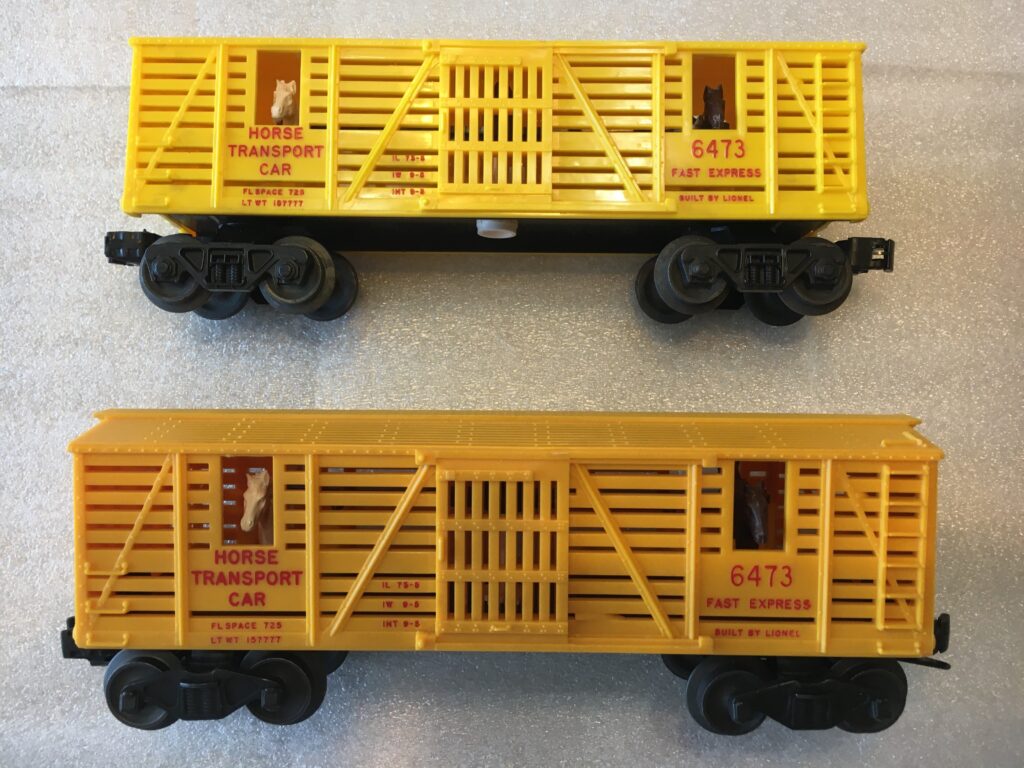
“Comparison of colors for both types of the #6473 Horse Transport car.”
Have fun, add these two action pack operating cars to your layout/collection. Their continuous action provides a treat and excitement when operating a layout!
December, 2022
Welcome to Jerry’s Collectors Corner:
Today’s feature: “Lionel Operating Christmas Theme Cars”
It is now December, almost all train operators and collectors become very excited this time of the year because this is when they received their first train as a gift at Christmas time, which they always remember! In fact, ask any train operator or collector, “What was the first train Santa brought you at Christmas?” They easily and readily identify their first train gift they received at Christmas. In addition, these 4 months of November, December, January, and February are the ABSOLUTE prime four months of the year for the best train meets, best train auctions and the most time both operators and collectors build and operate their trains on their home made layouts! “December is a time to Remember!”
This article is going to feature and describe four prime operating Christmas theme cars made by Lionel. Interesting, all four of these Christmas theme operating cars were manufactured after the end of the Postwar period by Lionel trains (which officially is considered 1969 as the end of the Postwar period for model trains).
This first of these four operating Christmas theme train cars was manufactured in Mt. Clemens, Michigan for only one year, in 1988. It is the highly sought after #18403 Operating Santa Claus Hand Car. This operating hand car has a bright green platform base with a black plastic handlebar pumper. It features both Santa and Mrs. Clause pumping the handcar. It is certainly a favorite for everyone, but children especially adore this handcar.

“#18403 Operating Santa Hand Car with an unpainted green plastic platform”
Next is the #18408 Operating Santa Clause Hand Car. It is a variation of the previously produced handcar, but has a very light gray platform base (looks nearly white) with a green plastic handlebar pumper. It is also described by Lionel as an operating hand car with both Santa and Mrs. Clause operating the pumping of the hand car. It was only manufactured in Mt. Clemens, Michigan for one year, in 1989. Lionel then produced in 1994 the #18422 operating Santa and Snowman Hand Car. (This car is not pictured in this article)
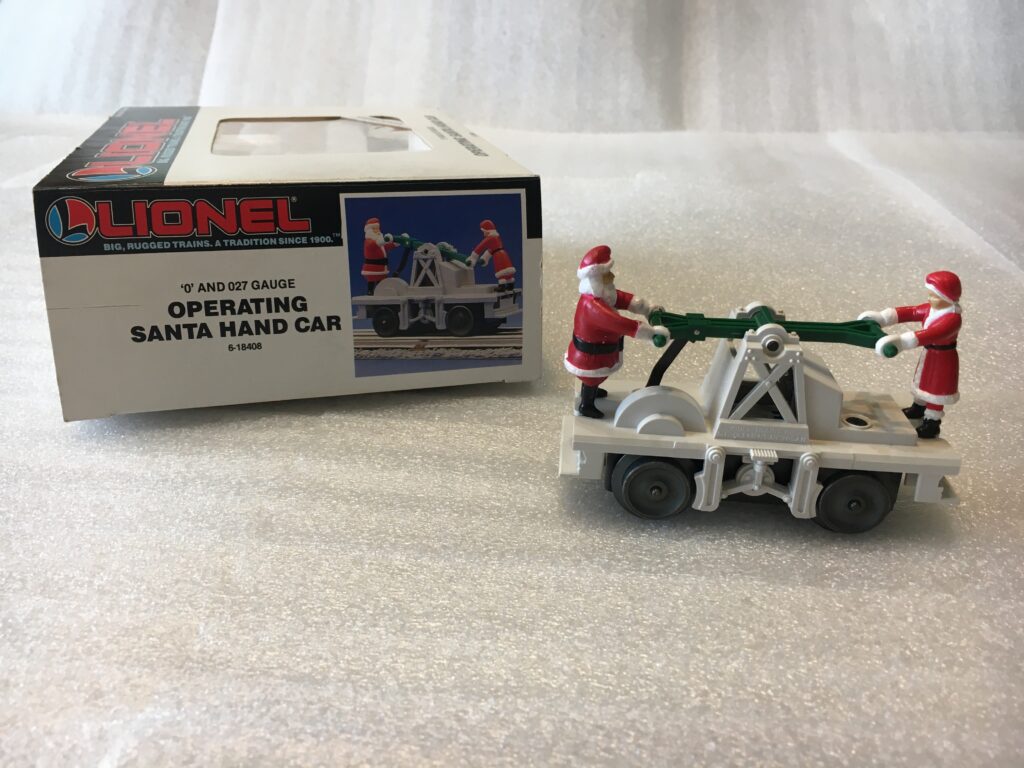
“18408 Operating Santa Hand Car with an unpainted light gray plastic platform”
The third featured Lionel themed hand car is my personal favorite operating hand car. It is the #18433 Mickey and Minnie Operating Hand Car. While the plastic base for this hand car uses the same mold as the two previously reviewed hand cars in this article, it comes with a gold painted plastic platform base with a black plastic handlebar pumper. It features injection-molded plastic Mickey and Minnie figurines. These Christmas decorated Mickey and Minnie statuettes which are plastic (as compared to the rubber only figurines operating the other two described hand cars) are quite large as compared to the rubber figures. Both of the Mickey and Minnie statuettes are nearly twice as tall and have large plastic hands on the black plastic pumper and hang way over the back of the plastic platform base of the hand car. Both Mickey and Minnie are appropriately dressed for Christmas in their red outfits and are a delight to operate on a train layout, especially at Christmas time. This car was manufactured by Lionel in China for two years, both in 1996 and 1997. They are package in the more traditional orange and blue striped Lionel box.
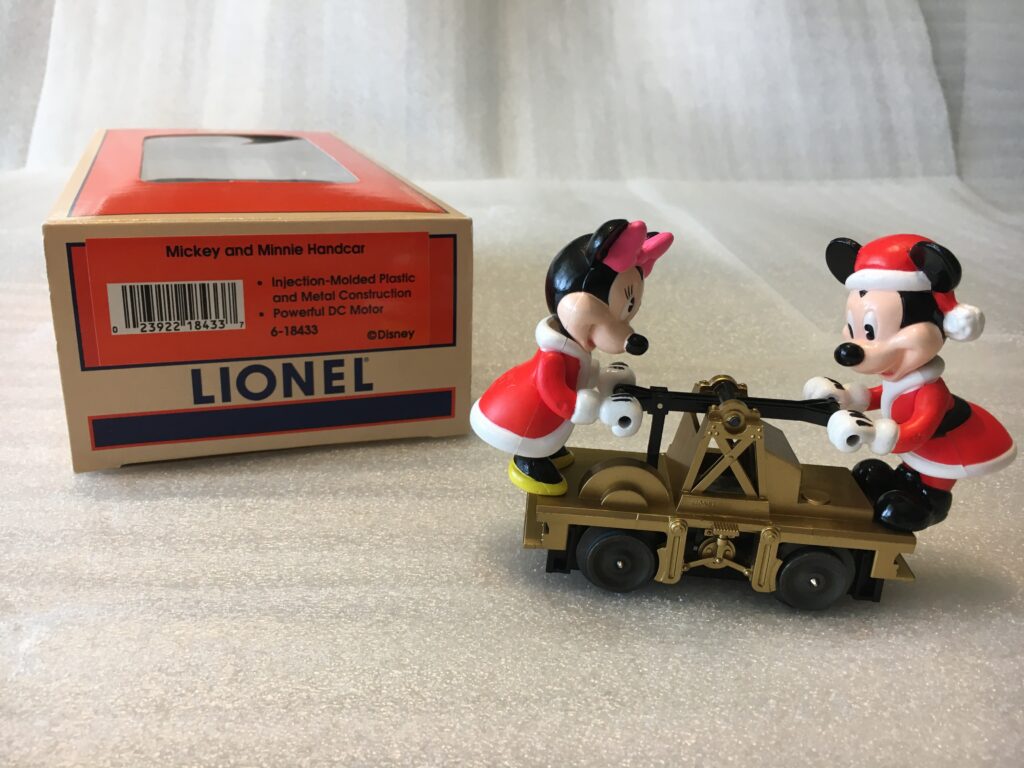
“18433 Mickey and Minnie Operating Hand Car with their Christmas outfits operating a painted gold plastic platform”
The last Lionel Christmas themed car is a motorized unit. This is the #28427 Operating Holiday Railroad Snowplow. This operating motorized snowplow has a painted plastic silver snow plow, dark green painted shell, painted red roof and red painted metal handrails and one gold painted stripe on each side. It also has a beautifully designed hot-stamped red and gold “Holiday Railroad” insignia on the cab with seasonally designed holly leaves in gold with green background from the cab. This Christmas snowplow was manufactured for three years from 2008 thru 2010. The Christmas snowplow has an operating headlight and comes with a gold plastic bell on the nose of the engine. It is a great unit to operate on your layout at home, especially during the holiday season. I wish everyone and their family a Happy holiday season!

“#28427 Operating Holiday Railroad Snowplow with colorful red and green painted cab, and silver painted snow plow”
November, 2022
Welcome to Jerry’s Collectors Corner:
Today’s feature: “#3376 and #3386 Operating Giraffe Cars”
Operating cars are the favorites of both postwar operators and collectors alike. This unique operating car, the “Giraffe Car” brings a lot of smiles and excitement to everyone’s faces when Lionel postwar trains are operated. These operating “Giraffe Cars” known by Lionel as the “Bronx Zoo” operating cars were manufactured for only six years. They were produced five years straight from 1960 thru 1964 and then brought back for one year only in 1969 as an uncatalogued operating car.
The most common “Giraffe Car” is the #3376 Operating Giraffe Car, known as a Type 1 car. This action car had an unpainted blue plastic body with white heat-stamped lettering. A spotted giraffe would duck down beneath the telltale signal as the train approached any low clearance (which was common place because real railroads would admonish the brakeman which usually rode on the top of the cars when approaching any low clearances). The brown-spotted giraffe extended thru the roof of the car and after ducking, the giraffe would then pop back up after clearing the danger of any low clearance. Many operating layouts actually install their telltale signal just before a low crossing bridge or a short tunnel and this increases the excitement of all viewers watching the trains operate on a layout. Try it, you will have a lot of fun setting up your layout this way. This operating giraffe car had two operating couplers which were usually AAR-type trucks and sometimes bar-end trucks. Please note that after 1963, this giraffe car came only with one operating coupler and one non-operating coupler.
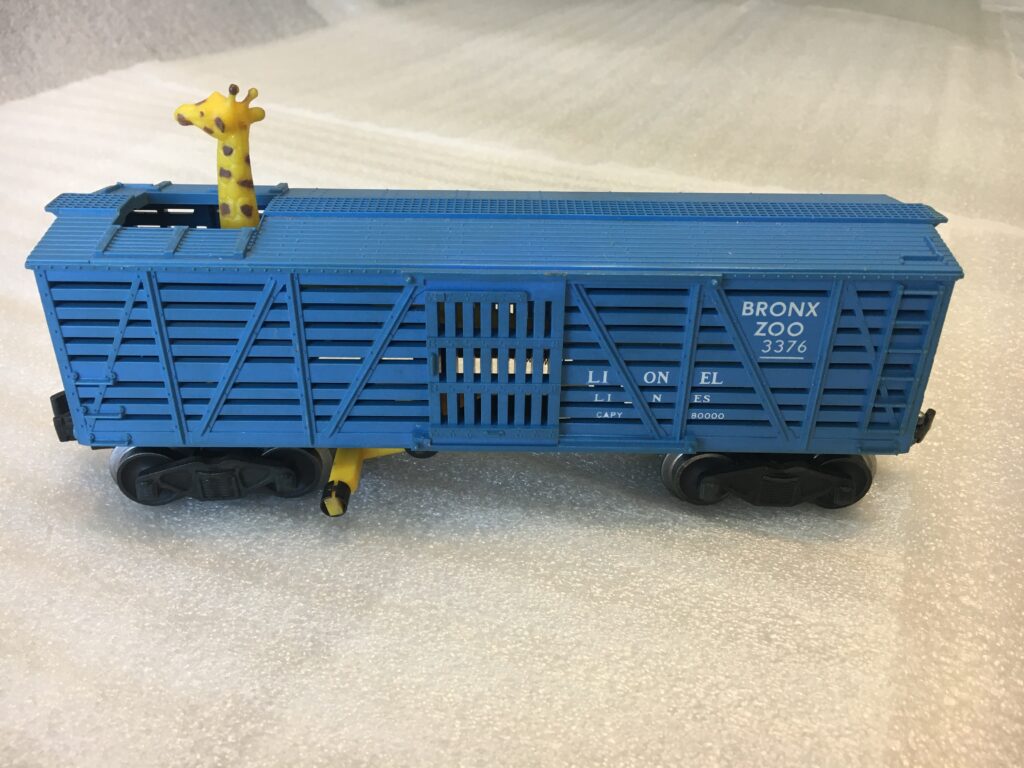
#3376 Operating Giraffe Car with a brown-spotted giraffe, unpainted blue plastic body and white heat-stamped lettering. This operating car has two bar-end metal trucks.
Next is the #3376 Operating Giraffe Car, a Type II car which is the rarest giraffe car produced by Lionel. It has a rarity rating of an 8 (which is the highest rarity rating for all of postwar Lionel). It was produced only for one year in 1969 and is identical to the Type I car except it has yellow heat-stamped lettering and the giraffe does NOT have any brown spots. It also has a blue plastic body, two operating couplers and two AAR-type trucks.
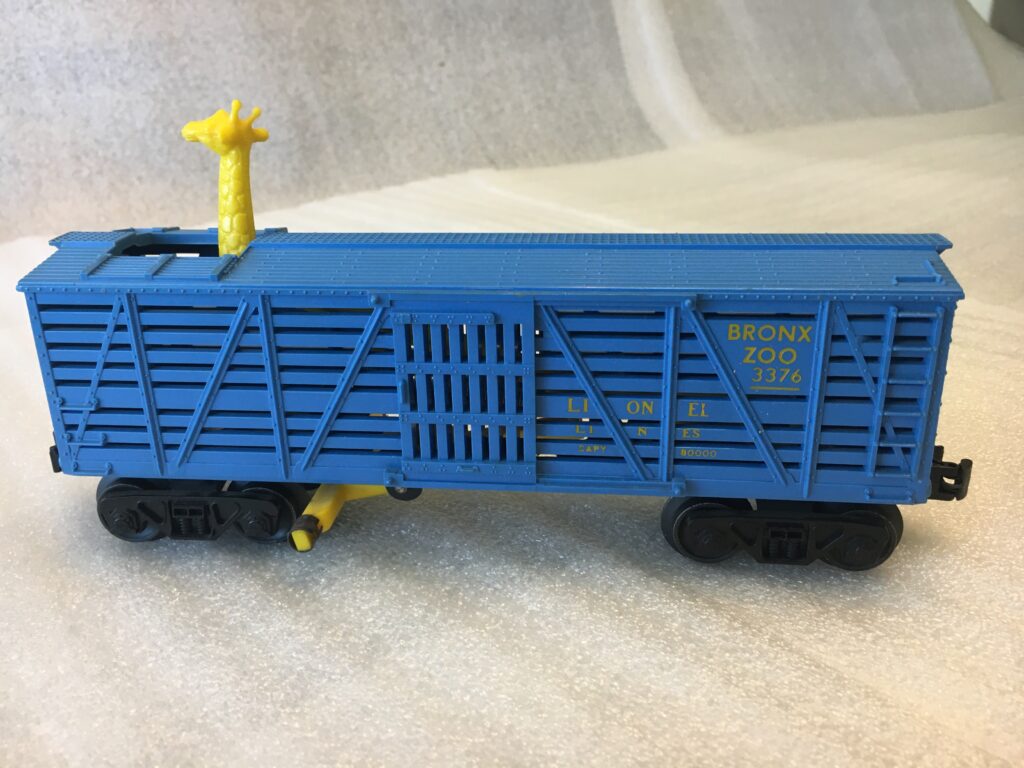
#3376 RARE Operating Giraffe Car with unpainted blue plastic body, yellow heat-stamped lettering, with No brown spots on the giraffe, two operating couplers and two AAR-type trucks. This operating car has a Rarity Rating of an 8.
There are two more significant variations of the #3376 giraffe operating car. Lionel actually numbered this next operating giraffe car #3376-160. This #3376-160 Operating Giraffe Car (variation #1) had an unpainted green plastic body with yellow heat-stamped lettering. This version came with NO brown spots on the giraffe, but did have one operating coupler and AAR-type trucks.
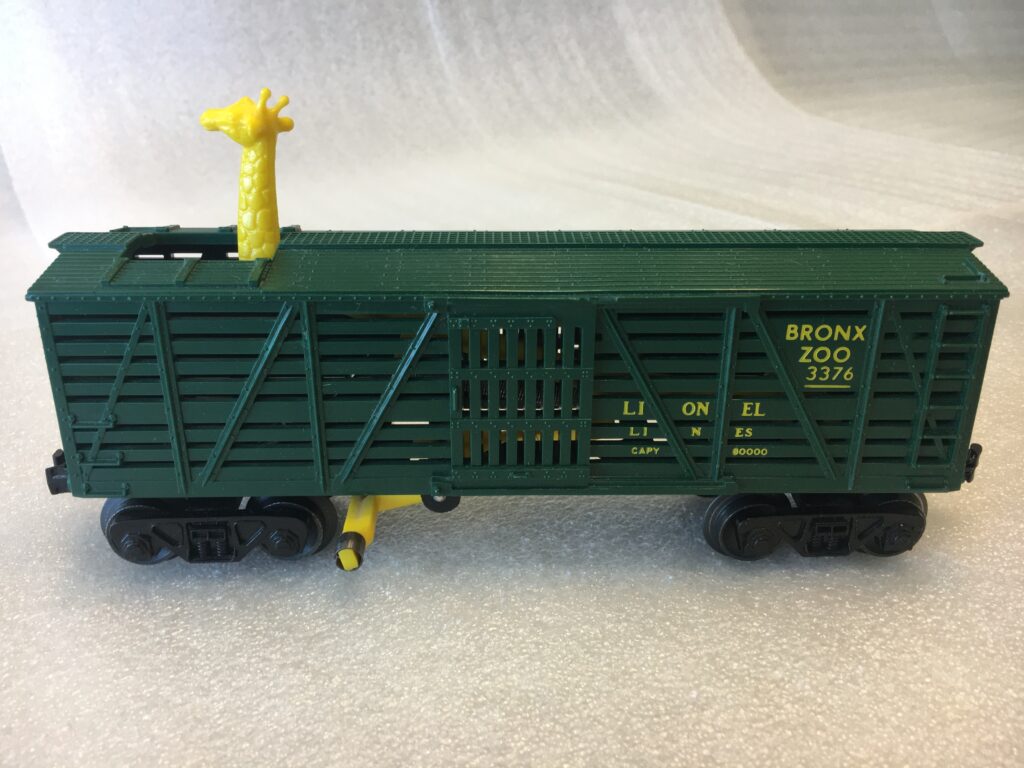
#3376-160 Operating Giraffe Car (version #1) with an unpainted green plastic body, yellow heat-stamped lettering, No brown spots on the giraffe, one operating coupler and AAR-type trucks.
The next variation is the #3376-160 Operating Giraffe Car (variation #2). It also had an unpainted green plastic body with yellow heat-stamped lettering. This version came with a spotty brown giraffe, two operating couplers and AAR-type trucks.
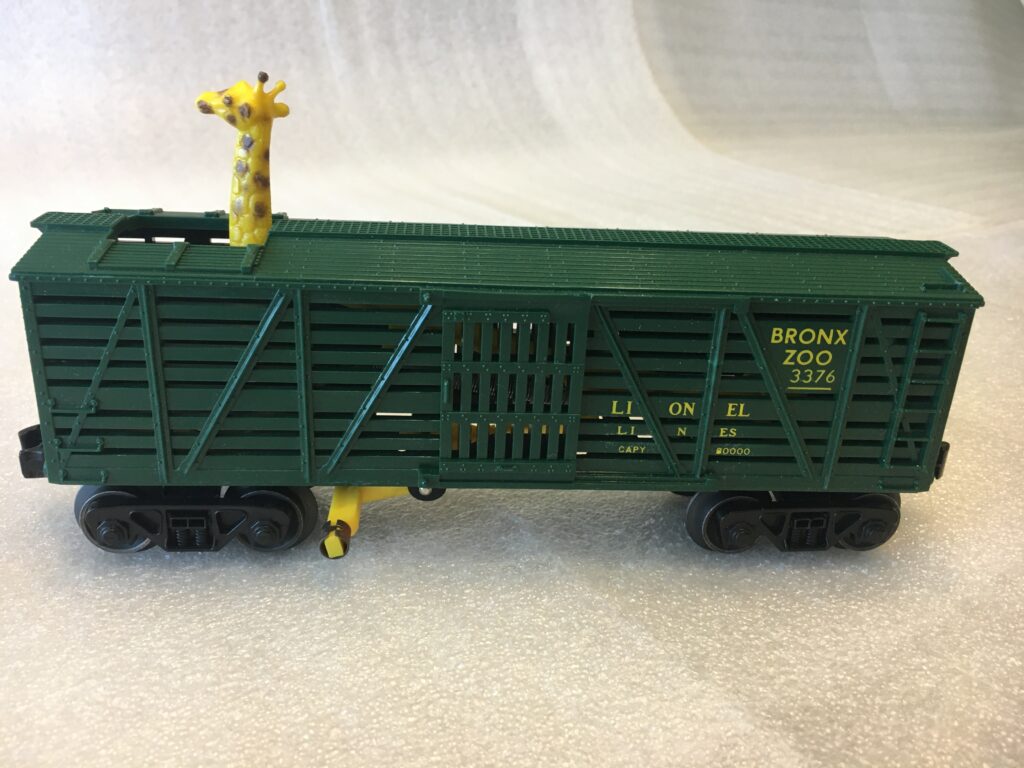
#3376-160 Operating Giraffe Car (version #2) with an unpainted green plastic body, yellow heat-stamped lettering, brown spotted giraffe, two operating couplers and AAR-type trucks.
The last Lionel Postwar giraffe car produced was the “#3386 Operating Giraffe Car”. While this operating giraffe car had a different number assigned to it by Lionel, it was very similar to the most common #3376 operating giraffe car, Type 1 car. The #3386 was an uncatalogued car with arch-bar trucks and two non-operating couplers. The giraffe car was only produced for one year in 1969 (the last year of the Lionel postwar years). Due to limited production of this car, it is not as common as the #3376 Type 1 giraffe version.

#3386 Operating Giraffe Car with an unpainted blue plastic body, with a brown-spotted giraffe, white heat-stamped lettering, two arch-bar trucks and two non-operating couplers.
Finally, it is important to realize that the operating giraffe cars are not considered complete unless they are accompanied with the 12 #3424-78 telltales, #3424-77 telltale pole, and the #3424-80 base assembly. All of these items along with an instruction sheet come with the Assembly Number envelope package #3376-118. These items are all pictured below for your review along with a picture of an original Lionel #3376 operation giraffe car box. You will have fun operating and running your giraffe car on your layout. This action pack operating car truly brings a lot of enjoyment when operating your train layout for family, neighbors and friends.
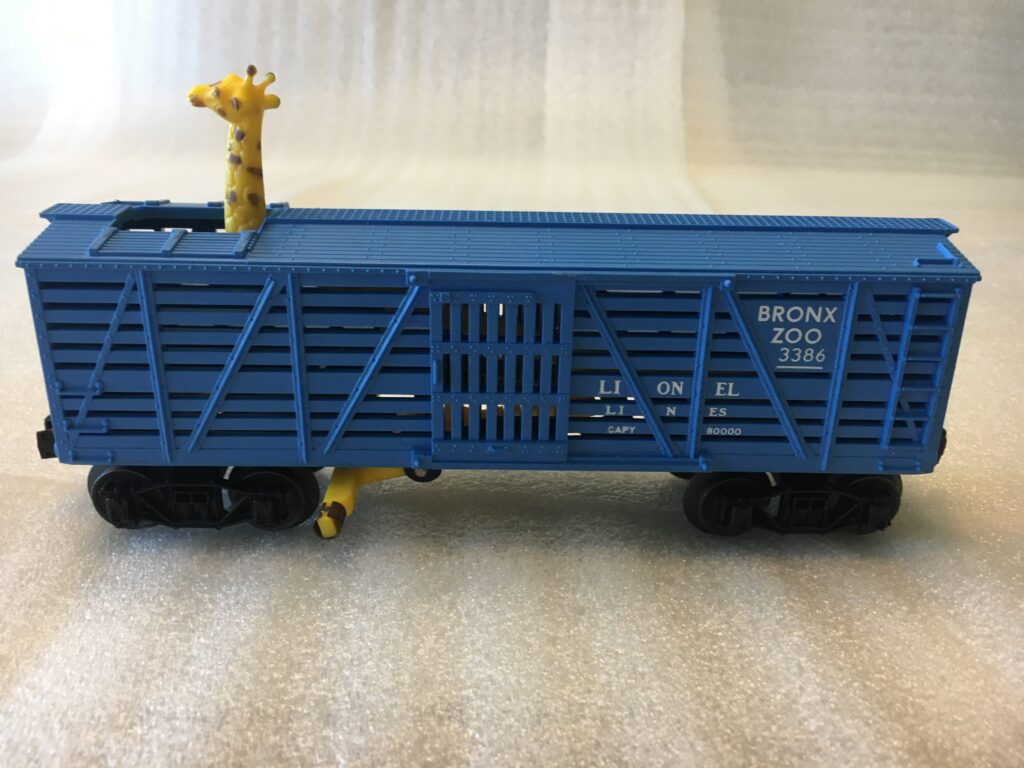
Original Lionel #3376 operating giraffe box, instruction sheet and the contents of the ASSEM. No. 3376-118 envelope.
October, 2022
Welcome to Jerry’s Collectors Corner:
Today’s feature: “6464-425 and #6464-725 New Haven Boxcars
Starting in 1953 and running thru 1969 (17 years), Lionel developed a “Series of 6464 boxcars” which has attracted both operators and collectors desire to acquire all of different 6464 boxcars and their many variations.
All four types of the New Haven boxcars we are examining are relatively common, except the New Haven 6464-725, Type III which comes in a Hagerstown box, but it can be found at train meets (more about it later in the article).
The “6464-425 New Haven boxcar, Type I” has an unpainted black body shell, white rubber stamping lettering and an unpainted orange door. It is a “Type II” style in the 6464 series body types. It has metal trucks and the “N” of the NH logo (left side) has only a half serif on the top right hand corner of the stamping. This boxcar had a smooth interior roof. This boxcar was produced for only four years from 1956 thru 1958 and 1969.
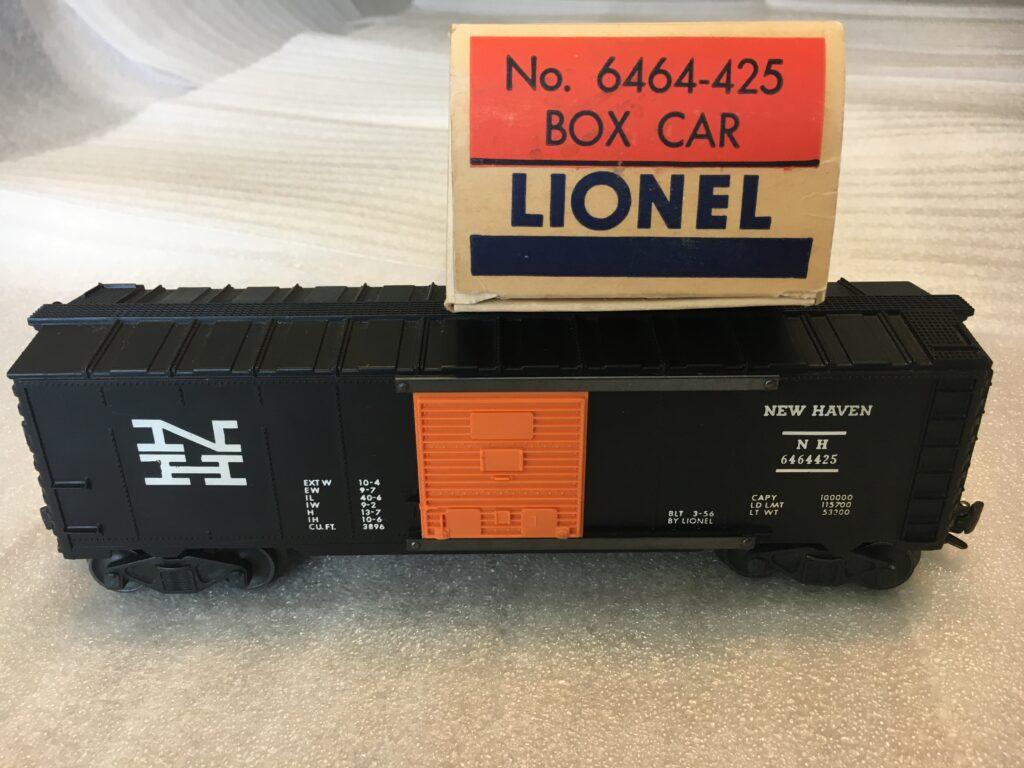
“6464-425 New Haven boxcar, Type I with a half serif on the top right hand corner of the “N” in the NH logo”
The “6464-425 New Haven boxcar, Type II” is identical to the Type I NH boxcar except the “N” in the NH logo has a full serif lettering. The interior of the roof is smooth in the NH boxcar type, just like the Type I.
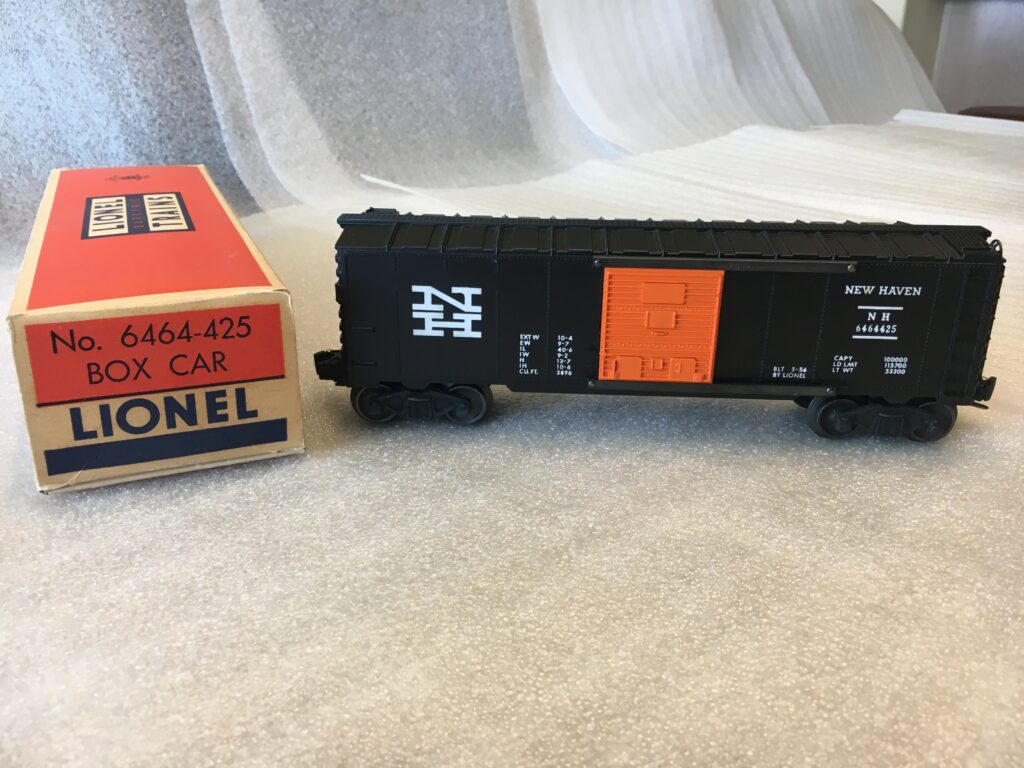
“6464-425 New Haven boxcar, Type II with a full serif on the top right hand corner of the “N” in the NH logo”)
The “6464-725 New Haven boxcar, Types I and II” were produced with a painted orange that was either a light, medium or glossy color of orange. These boxcars had an unpainted multiple tack board black doors and black heat-stamped lettering. The interior of the roof was ribbed. These orange New Haven boxcars came only with AAR-type trucks. There is no difference to collectors in the value of this boxcar due to the different orange paints use to produce this boxcar. This boxcar was produced for 7 straight years from 1962 thru 1968.

“6464-725 New Haven boxcar, Type I with orange paint and an unpainted black multiple tack doors” (Photo courtesy of the Lyle Leverich Collection)
The “6464-725 New Haven boxcar, Type III” was manufactured for only one year in 1969 and was an attempt by Lionel to reproduce the black unpainted boxcar #6464-425. However, it was different in a number of ways. Most significantly, the body shell was actually a painted black, but came with white heat-stamped lettering. Secondly, it had no built date at all, only stamped “Build By Lionel” and had a ribbed interior roof. These boxcars had metal bar-end trucks with magnetic couplers. The correct box for this boxcar was the Hagerstown original box (see picture).
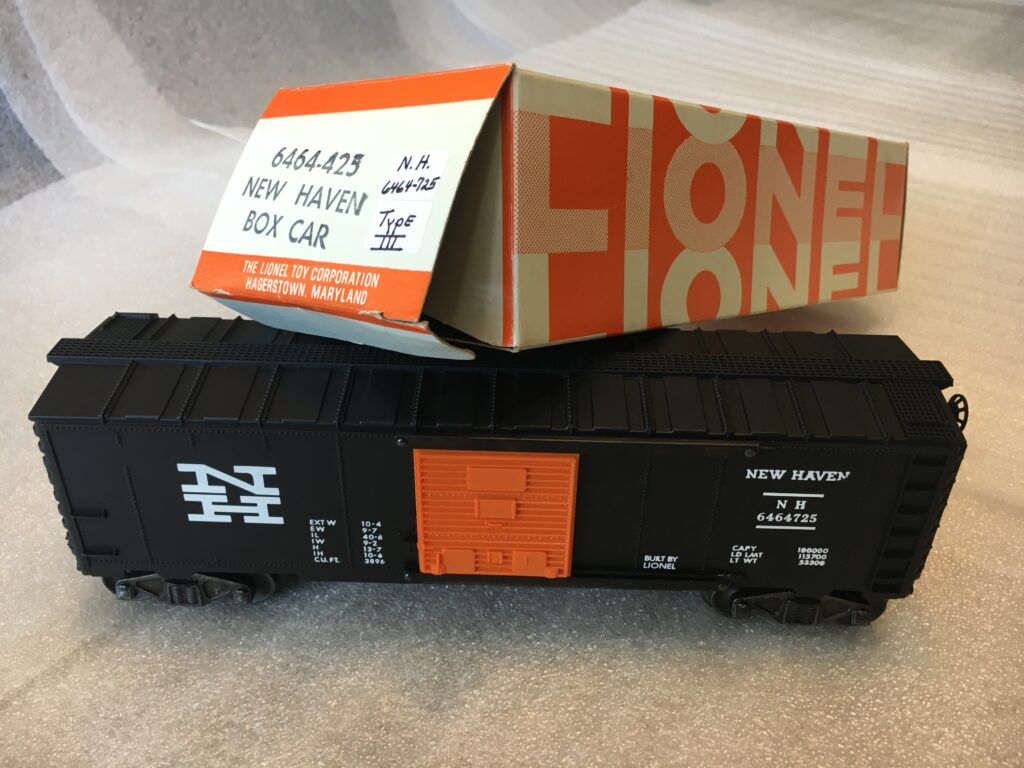
“6464-725 New Haven boxcar, Type III with a painted black body shell, white heat-stamped lettering, ribbed roof and no built date with the Hagerstown box”
Both of these “New Haven” boxcars will make excellent additions to your collection and easily may be found at various train meets and train conventions. Enjoy adding both of these “6464 series” boxcars to your collection.
September, 2022
Welcome to Jerry’s Collector’s Corner:
Today’s feature: “#601 and #602 Seaboard Diesel Switcher Locomotives”
For many operators and collectors, among the most interesting and highly desirable diesel switchers are both the #601 and the #602 Seaboard Diesel Switchers. These Seaboard switchers are colorful, powerful and beautifully designed. A truly unique fact is that the #601 Seaboard EMD NW2 switcher was “0” Gauge and the #602 Seaboard NW2 switcher was “027” Gauge. The #601 Seaboard was produced only for one year in 1956 and the #602 Seaboard was manufactured for only the two following years in 1957 and 1958.
These Seaboard switchers were painted black and red and had three red stripes on the nose and had white heat-stamped “Seaboard” lettering on the side of the shell. Both of these switchers had a herald decal under the cab window and also had a white heat-stamped number on the cab. Both came with a two-axle MagneTraction and featured a simulated black fuel tank and had an operating horn. This added to the play time for collectors and had a great deal of appeal for all operators and collectors.
However, there is a truly unique feature for the #601 Seaboard Diesel switcher which is many times, in fact, most times missed. The three red stripes on the nose of the #601 switcher came in two variations. The first variation had square ends at the front of the red stripes on the side of the cab and rounded ends on the inner portion of the three red stripes. I will describe this as Style 1 or variation #1 for the #601 Seaboard switcher. The second variation had square ends on all three red stripes on the cab and I will describe this as Style 2 or variation #2 of the #601 Seaboard switcher.
According to price guides there is no significant differences in the value of the two variations of the #601 Seaboard Diesel switcher. My personal favorite is variation #2 or the switcher with the square ends on all three stripes on the shell of the cab. I believe this variation is a little more difficult to acquire. However, keep an eye out when you attend train meets because it can be found.
There is one more difference between these two Seaboard Diesel Switchers. The #601 Seaboard did have operating couplers at both ends, while the #602 Seaboard Diesel Switcher had non-operating couplers at both ends. But to make production of these switchers interesting, Lionel did add an operating front headlight which was never included in the original #601 Seaboard switchers.
One final note is that the #602 Seaboard diesel switcher ONLY came with rounded ends on the right side of the three red stripes on the shell. Again, this also adds to the challenge of finding the #601, variation #2 since it was the ONLY Seaboard Diesel switcher (of the three) decorated with the square ends at both ends of the three red stripes. With the two-axle MagneTration, the Seaboard switchers are a good runner and add a lot to an operating layout and demand from Lionel postwar collectors.
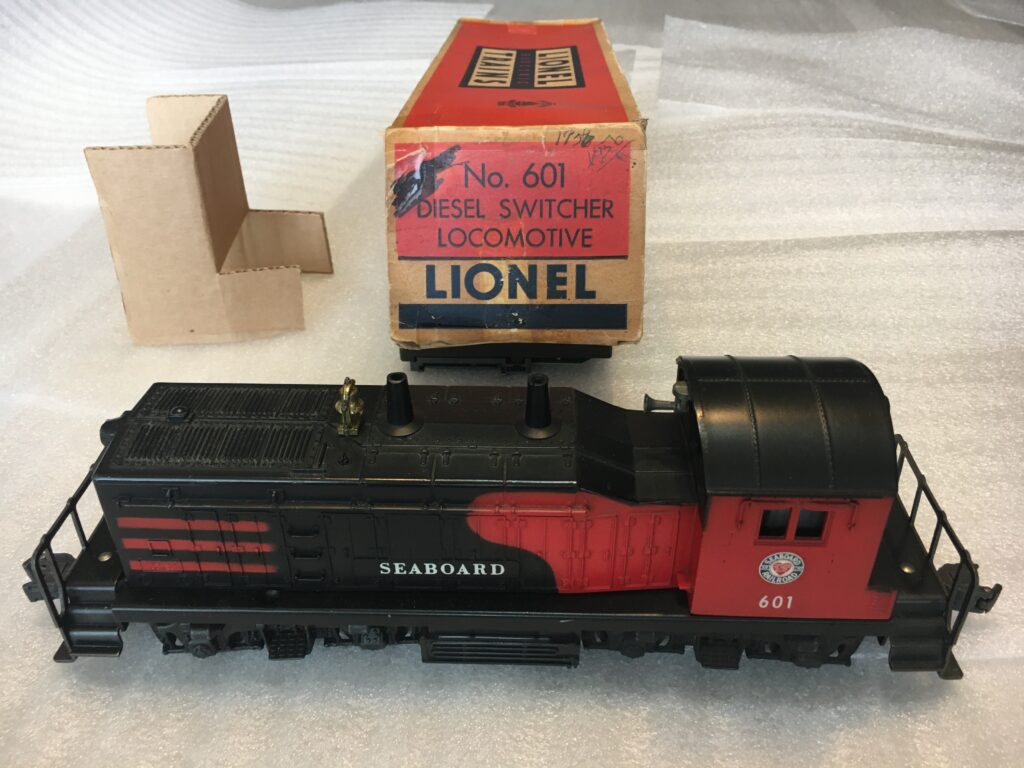
#601 Seaboard EMD NW2 switcher (Variation #1) with rounded ends on the right-hand portion of the three red stripes, two operating couplers, two-axle MagneTraction and operating horn”
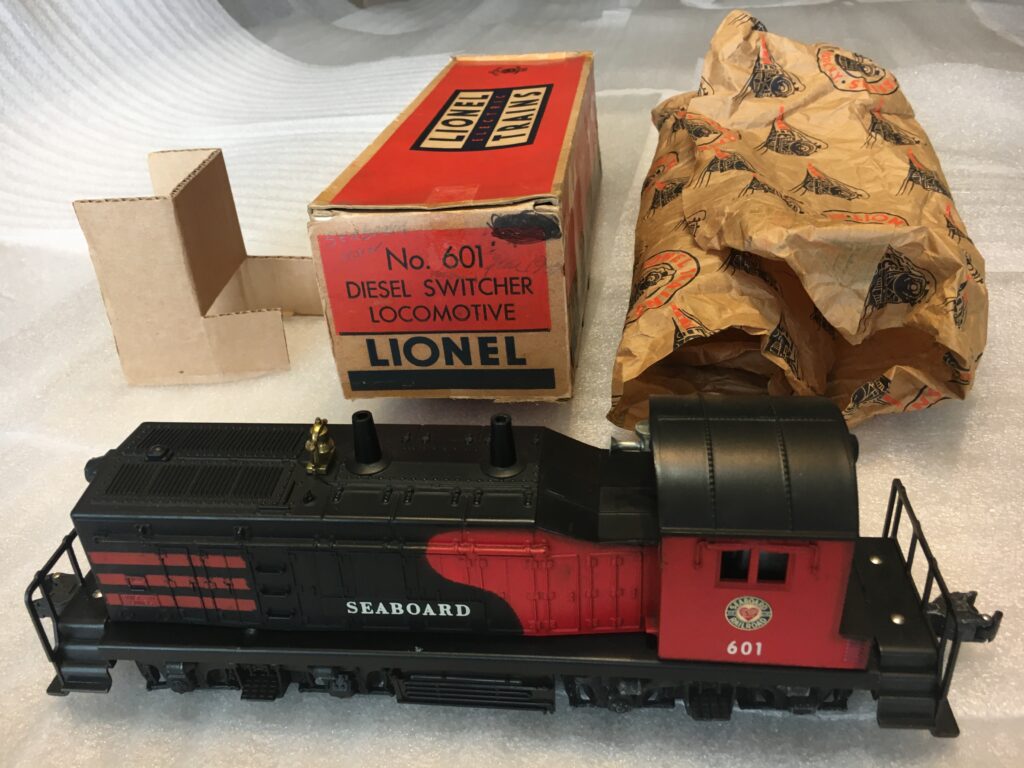
“#601 Seaboard EMD NW2 switcher (Variation #2) with square ends on all three red stripes, two operating couplers, two-axle MagneTraction and operating horn”

#602 Seaboard NW2 switcher with rounded ends on the right-hand portion of the three red stripes, non-operating couplers, two-axle MagneTraction and an operating horn and front headlight”
Both the #601 and #602 Seaboard Diesel Switcher Locomotives will add worth to any operating layout and a great deal of value to your Lionel postwar collection. Enjoy the search for all three Seaboard diesel switcher locomotives!
August, 2022
Welcome to Jerry’s Collector’s Corner:
Today’s feature: “#2330 and #2332 Pennsylvania GG1”
Of all of the diesel electric locomotives produced during the 24 years of Lionel postwar era of trains, the powerful, die-cast bodies with five rubber-stamped stripes and lettering with the road name of “Pennsylvania” were the most desirable, sought after engines under any circumstance. These “GG-1” diesel electric locomotives were known as the most powerful pullers ever produced by the Lionel corporation.
Interesting enough, when I was a teenager and starting to acquire and operate Lionel trains, I did not purchase any of the GG-1 electric locomotives. They seemed to me during my teenage years to be too big, too expensive, too heavy and quite frankly, not very good looking. I had a neighbor friend who owned and operated a green 2330 GG-1 all the time on his layout and was very proud to show how many cars his electric Brunswick green GG-1 locomotive could pull! I learned to appreciate the capability and the pulling strength of the GG-1 locomotives and acquired these powerful GG-1 locomotives in my later years of operating and collecting model trains.
I will be featuring three of these very powerful GG-1’s in this article. I will start with the first GG-1 Lionel locomotive ever produced during the postwar years, which was manufactured for three years from 1947 thru 1949. This was the “#2332 GG-1.” These GG-1’s produced were either a die-cast Brunswick green painted body or a painted black die-cast body. The Brunswick green #2332 GG-1 body came three ways. First as a rubber-stamped keystone with five gold stripes, secondly as a rubber-stamped keystone with five silver stripes or thirdly and the most common version with five rubber-stamped strips and a keystone decal. Obviously, the value relates to the condition of the five rubber-stamped strips, the condition of the green painted die-cast body and if the two original keystone decals are intact on both ends of the shell. The #2332 Brunswick painted body had a headlight lens at each end, running lights, ornamental horn at each end and two original pantographs. This first GG-1 had a single motor and no MagneTration. In addition, it had lights at both ends of the cab and also was known for a strong-sounding AC vibrator box horn. Although the values of the three variations of the painted Brunswick green GG-1 are similar, the variation with the keystone decal is much more preferred.
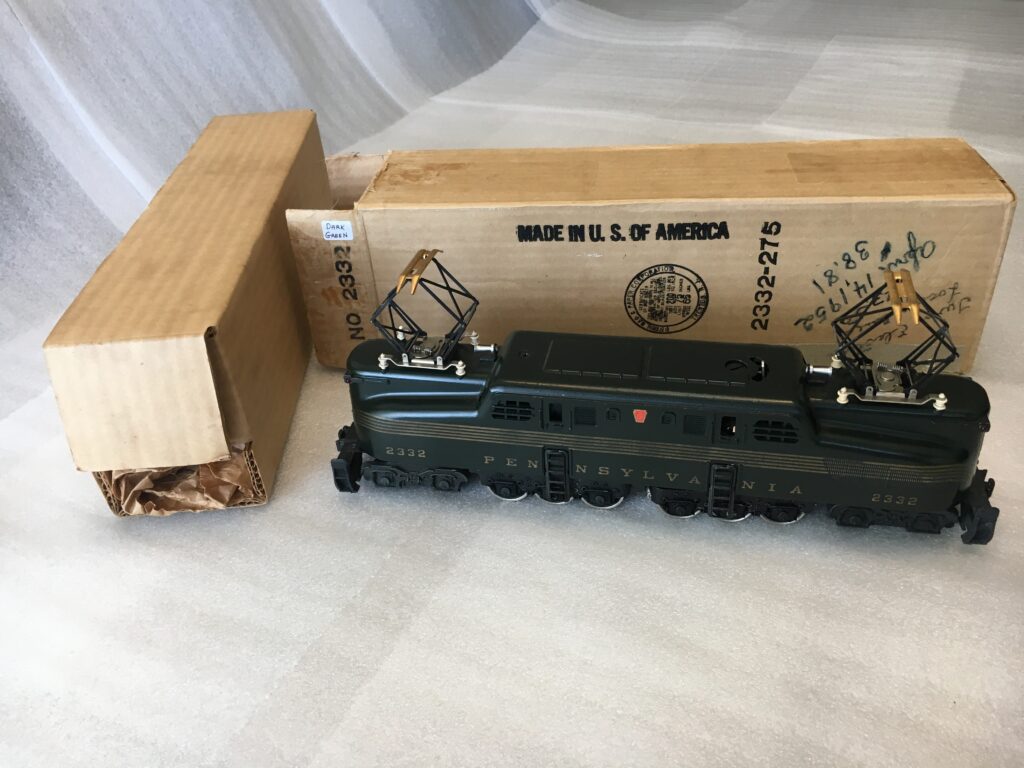
“#2332 GG-1, Brunswick green with five gold rubber-stamped strips (MINT condition) and with original keystone decals”
The #2332 Black GG-1 is the RAREST and most sought after GG-1 in all of the postwar years. It has a RARITY RATING of an 8 (which is the highest rarity rating listed). It has five rubber-stamped gold stripes, detailed pantographs, horn and a rubber-stamped “PRR” keystone in the center with a black body background. It also has a “2332” original decals at both ends. The #2332 Black GG-1 also came three ways. (1) rubber-stamped “PRR” keystone in the center and with five gold stripes, (2) rubber-stamped “PRR” keystone in the center and with five silver stripes and (3) decal #2332 keystone in the center with five gold stripes. Again, condition of the five gold strips is key to the condition rating of the black painted #2332 GG-1.
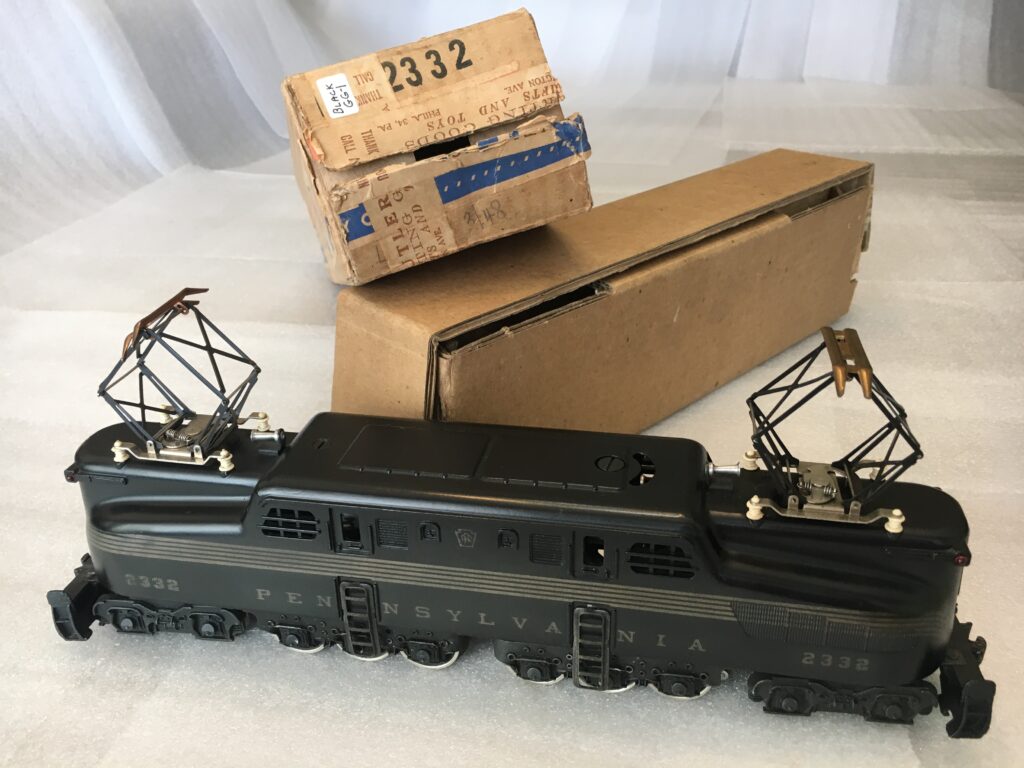
“#2332 GG-1, Black painted body with five rubber-stamped gold stripes, two original #2332 keystone decals on both ends and a rubber-stamped “PRR” keystone in the center of the cab with the painted black body background (MINT Condition )”
In 1950, the GG-1 was renumbered and was produced and improved in several significant ways. This was the “#2330 Brunswick green GG-1” with two motors and MagneTraction. It only came in Brunswick green, with five rubber-stamped gold stripes, a small PRR “keystone decal” centered on the sides and at both ends. The GG-1 has headlights and marker lights at both ends, operating coil couplers and an operating horn. The addition of a second motor was truly significant and greatly expanding the pulling power of this electric locomotive. Some say it is the most powerful puller of all postwar trains. Interesting note, this #2330 GG-1 was produced for only ONE YEAR and to find one in a quality condition is a challenge for both operators and collectors alike.
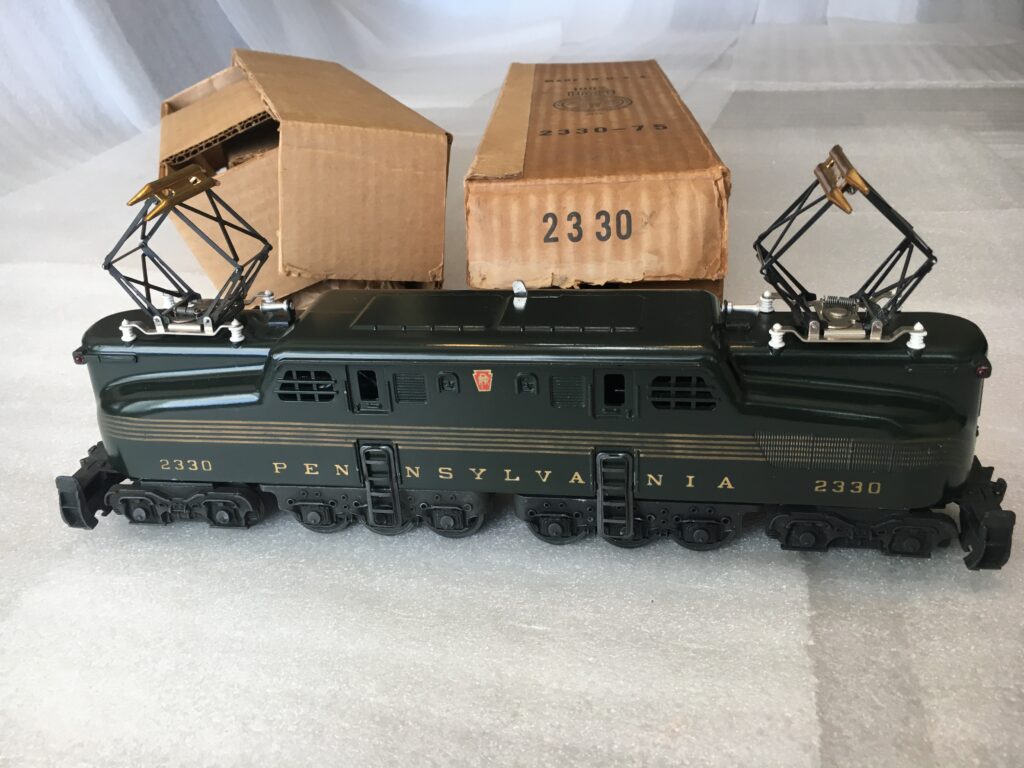
“#2330 GG-1 Brunswick green, detailed pantographs with two motors, horn and five rubber-stamped gold strips, headlights, running lights, MagneTraction, operating coil couples and a small PRR “keystone decal” centered on the sides and at both ends (MINT condition).”
Enjoy running and collecting your quality #2330 GG-1 and #2332 GG-1 diesel electric locomotives!!!
July, 2022
Welcome to Jerry’s Collector’s Corner:
Today’s feature: “#3656 Lionel Lines Operating Cattle Car”
Produced by Lionel for seven years (1949-1955), the #3656 Lionel Lines Operating Cattle Car was both a favorite for operators and collectors. This operating car with its accompanying operating stockyard with separate cattle set presented unique, but different challenges for both operators and/or collectors. Below is a chart of the four different types of the operating cattle car for your reference and review. These four different variations are a challenge for collectors to acquire, especially in a quality (Mint/like) condition. For operators, any of the four variations is challenging in order to obtain the OB’s (including the small original box for the 9 figures for the Cattle Car, OB #3656-9), instruction sheet, different hot-stamped lettering variation for the cattle car, and with and/or without the “Armour” adhesive logo with a brown background, yellow lettering and a bright “red” star.
Type Color of Heat-stamped lettering Presence/Absence “Armour” Logo
I Black HS Lettering With “Armour” Logo
II White HS Lettering With “Armour” Logo
III White HS Lettering Without “Armour” Logo
IV Black HS Lettering Without “Armour” Logo
The #3656 Lionel Lines operating cattle car was painted orange and the lettering was always heat-stamped (black or white). Interesting enough, the main door of the cattle car was molded in place on one side and the other side had a sliding door that also triggered the start and stop movement of the cattle. For the first two years of production, the sliding door was die-cast and changed to plastic during the 1950 production year. Thus, the initial challenge for collector’s is to acquire the die-cast door variation which was only available during the first two years of production. For operators, this is not a significant issue.
Of the four variations, Type I and Type IV are the most valuable and both have a Rarity rating of a “7”. The sheet-metal frame had steps on each corner. The platform deck of the corral was painted yellow while corral gates were painted orange. It should be noted that the swinging corral gates in Types III and IV were now painted yellow. The base of the cattle car platform was painted green for all four variations. In 1951, bar-end trucks replaced the staple-end trucks of the earlier productions of the cattle car. In should also be noted that the electrical connections in the Type III were relocated from left side where there were located in Types I and II to the right side in variations Type III and IV.
The #9 No. 3656-9” box of cattle for the cattle car consisted of 9 Black rubber cattle with 11 small rubber fibers on the bottom of each horse which moves the cattle along when the cattle coral is energized. Also, very desirable is to have the inner carbon insert for the cattle platform that fits into the OB master carton.
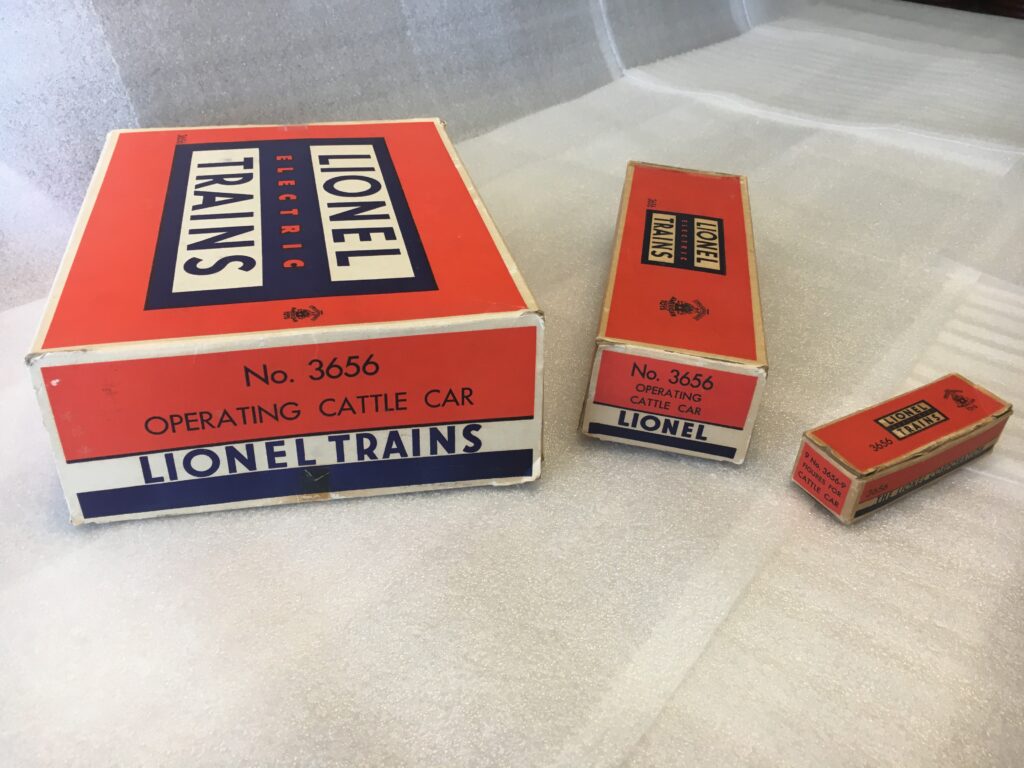
“#3656 Master carton OB of Operating Cattle Car, No. 3656 Operating box for Orange painted Cattle Car & 9 No. 3656-9 OB for Figures for Cattle Car”
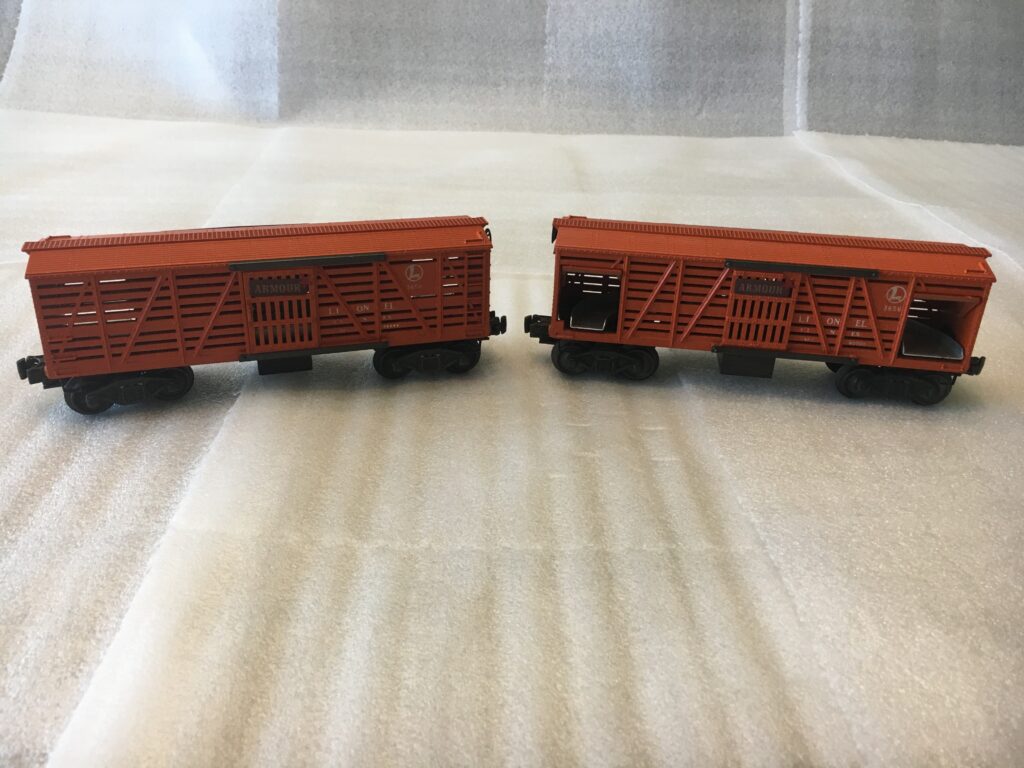
“Type II variation of the #3656 Cattle Car with White Lettering, original “Armour” logo (front side on left) and Rear side of cattle car with unrealistic doors near each end of the back side raised to allow the cattle to pass to and from the corral (this side has the stationary center door in the center and it does NOT slide (pictured on the right)”
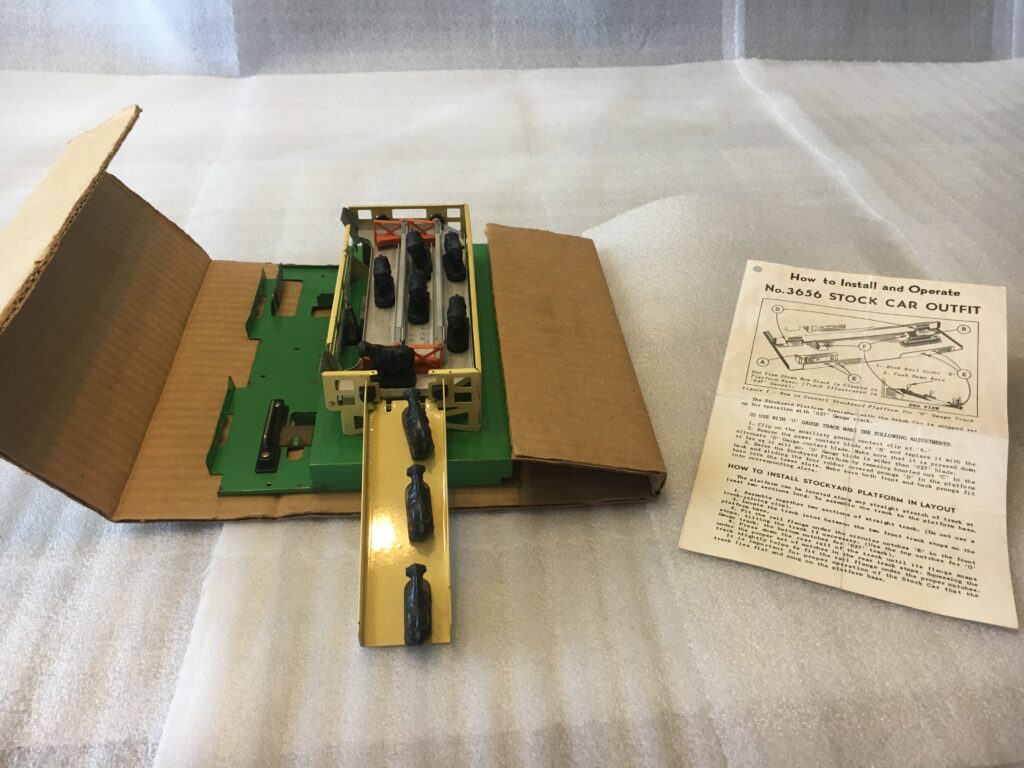
“Yellow/green cattle corral with ramp and 9 black cattle, cardboard liner and original instruction sheet”)
JUNE 2022
Welcome to Jerry’s Collector’s Corner:
Today’s feature: 4 RAREST “Lehigh Valley” Postwar Hoppers
Both operators and collectors love the Postwar Diesel and Steam engines, 6464 series boxcars, motorized units, boxed sets, cabooses and operating accessories. However, minimal attention has been given to the postwar hopper cars. There are many postwar hoppers and most are relatively inexpensive and quite common. Hopper cars were manufactured in a variety of road names. However, during the 24 years of postwar trains, 4 of the RAREST hoppers produced were all of the same road name, “Lehigh Valley”.
I am going to examine the 4 RAREST “Lehigh Valley” postwar hoppers. They are (1) #643657 open top large hopper (without and with the spreader bar), (2) #643657 open top larger hopper Pre-production paint sample which is maroon plastic with a spreader bar, (3) #6456-50 “Lehigh Valley” short hopper which is glossy red with WHITE lettering (and the rarest of the 4 Lehigh Valley hoppers to collect in a high quality condition) and the (4) #6456=75 “Lehigh Valley” short hopper also produced in a glossy red but with yellow lettering.
First up for review is the #643657 Lehigh Valley hopper that only came in the very popular and desirable “Girl’s set.” This hopper was heat-stamped #643657, but was assigned the number #6436-500 in the service manual. It was an open top large hopper with Lehigh Valley markings and had a lilac-painted body with maroon heat-stamped lettering. This hopper was produced without a spreader bar (Type I) and with a spreader bar (Type II). This pastel painted hopper fits right in with the other pastel painted cars in the highly sought after famous girl’s train set. There will be more discussion on this hopper in my article on the 1957-58 “Girl’s Train” set.
Next, I would like to feature the #643657 “Lehigh Valley” open-topped large hopper which is a Lionel Pre-production paint sample. It is maroon with white hot-stamped lettering “643657”. It was produced with a spreader bar and the very difficult OB it comes with is numbered #6436-25 (which is the correct OB for this hopper).
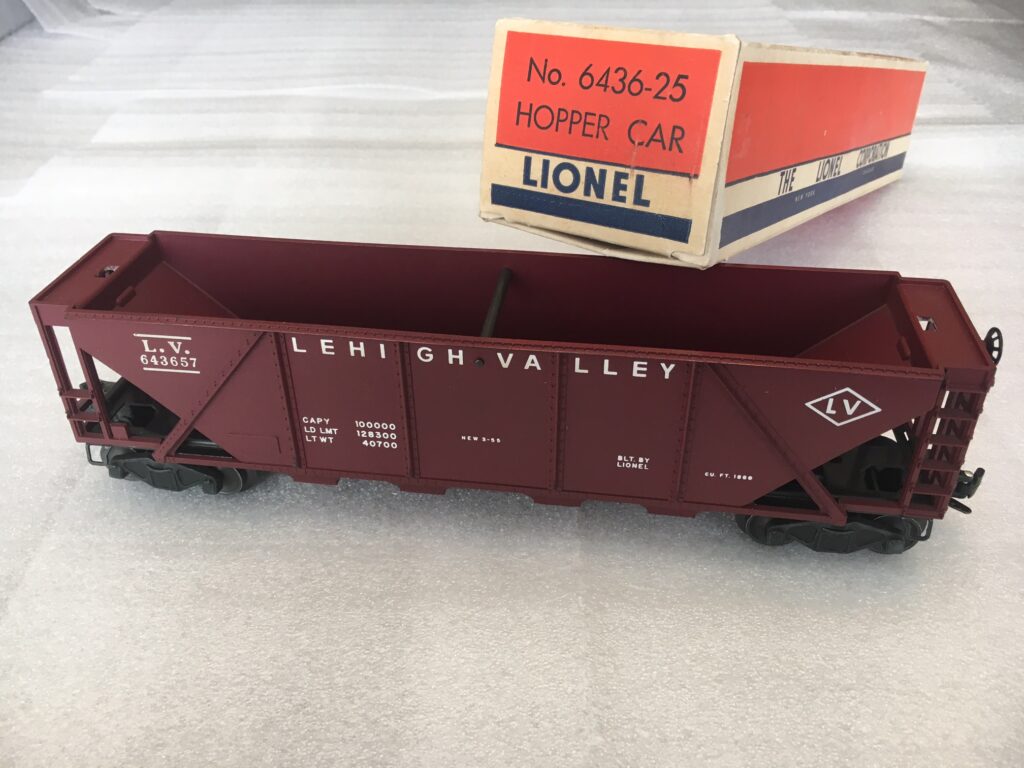
“RARE #643657 maroon plastic open-top large “Lehigh Valley” Pre-production paint sample hopper car” and the EXTREMELY RARE #6436-25 OB”
The third “Lehigh Valley” hopper car I am going to review is actually my personal all-time favorite and by most collector’s considered the “RAREST POSTWAR HOPPER’’ car ever made during the entire 24 years of Lionel postwar production. This hopper car was produced in 1954 only and is the gorgeous #6456-50 “Lehigh Valley” short hopper car. Some collector guide authors called it a Type III or Type VII depending on the collector’s guide and it has a Rarity Rating of a 7. The reason I truly loved this hopper is due to its color which is described by many as a painted glossy red on a gray plastic molded shell. However, I would like to describe the color as a “Candy Apple Glossy Red!”. If you are fortunate to find and purchase a MINT #6456-50 “Lehigh Valley” short hopper car with white lettering you will find that it actually has a true sheen (a soft luster on the surface) and truly stands out when operating it or placing this hopper on you train shelf or train wall in your train room. It has a “Built 1-48” hot-stamped white lettering on the sides as well as the “#6456” heat-stamped on the sides. This hopper car has both a brake wheel and comes with bar-end metal trucks. Here is another extremely valuable bit of information, it came with an OB that was numbered #6456-75, which is the correct and only OB originally supplied by Lionel for this hopper car. This is correct, the hopper car is a -50, but ONLY came in an OB numbered -75.
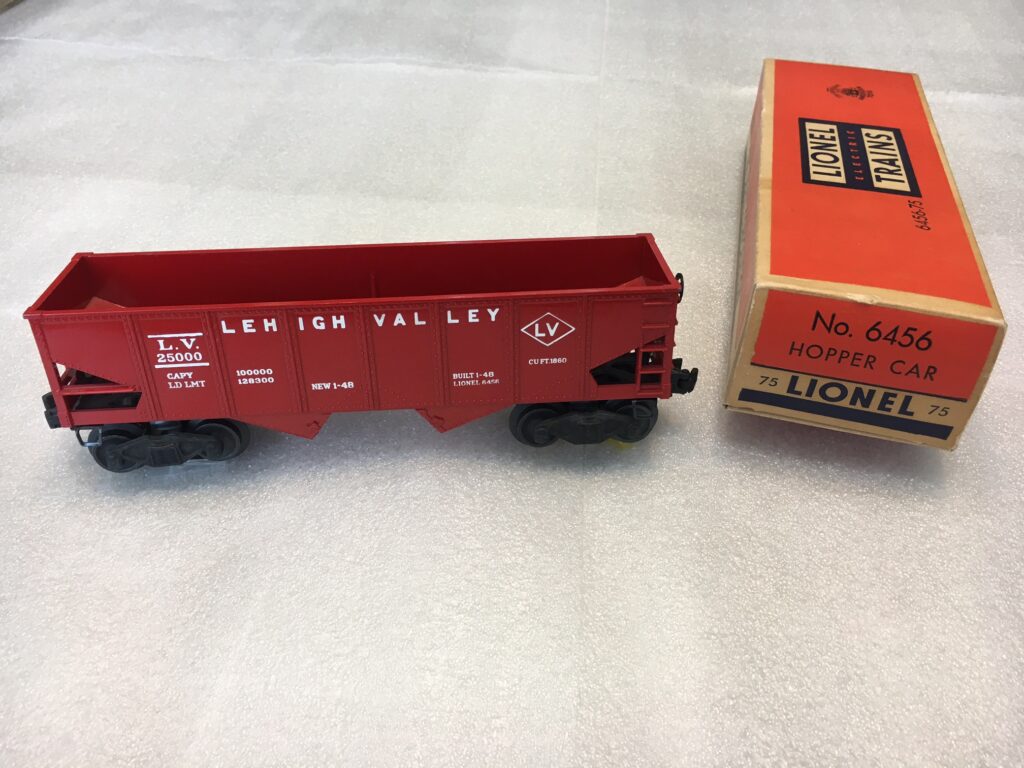
“#6456-50 Lehigh Valley” Glossy Red Short Hopper car with WHITE hot-stamped lettering and is considered by most collectors as the RAREST postwar hopper car ever made with a #6465-75 OB”
The last “Lehigh Valley” hopper car to be reviewed also came on a gray molded shell and was painted a glossy red color, but came with YELLOW heat-stamped lettering. It is the “#6456-75 Lehigh Valley” short hopper car. It also was produced one year only in 1954. It had a brake wheel, bar-end metal trucks and no spacer bar. While it is not as scare as the #6456-50 hopper car, it is still scare, especially to locate it in a high quality condition. It has a Rarity Rating of a 5.
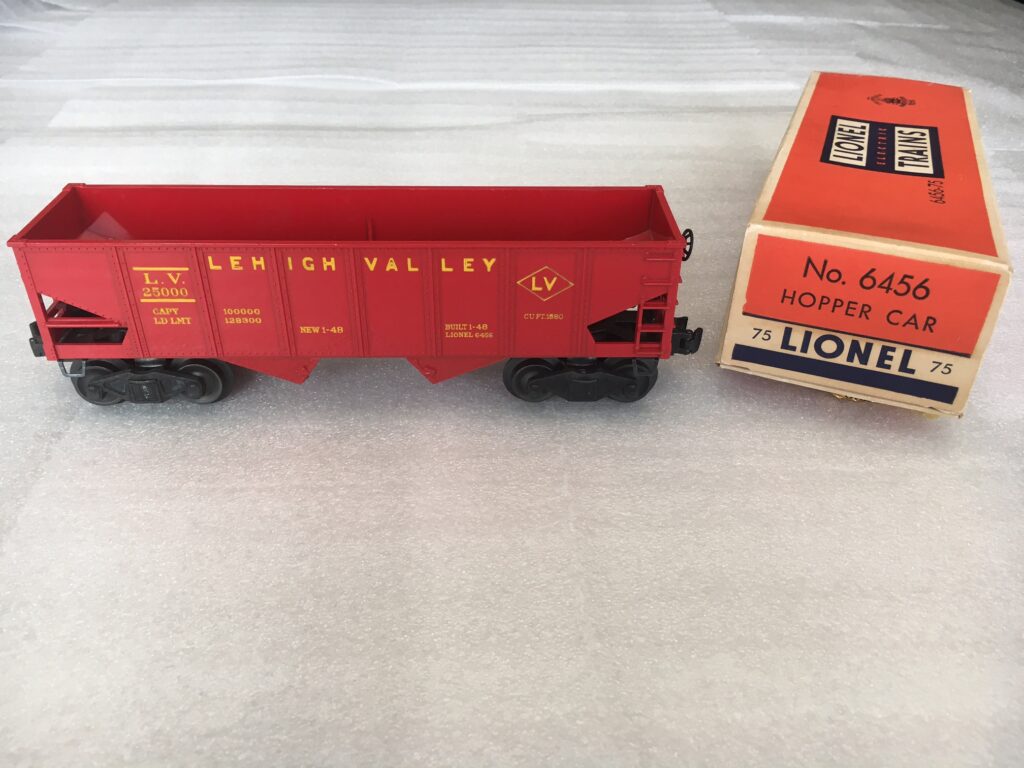
“#6456-75 Lehigh Valley” Glossy Red Short Hopper car with YELLOW hot-stamped lettering
and its #6456-75 OB”
May, 2022
Welcome to Jerry’s Collector’s Corner:
Today’s feature: #54 Ballast Tamper (& Rare Variation & MPC)
An exciting operating motorized unit is the #54 Ballast Tamper. Interesting enough, this Ballast Tamper is highly collectable, but rarely seen operating on a layout. That is too bad, because if more postwar Lionel operators would run their ballast tamper, there would be a greater interest among collectors to include it in their collection.
The Lionel #54 Ballast Tamper was modeled after a modern self-propelled track maintenance machine that could ram ballast under the track ties almost as fast as a man could walk. When it is operated at a normal speed it would speed along the track until reaching the point in the track where work would need be done. Then the tamper has SIX tamping bars to accomplish its work. When operating, the red tamper bars go up and down quickly as the motorized unit moves along the track. Please note when you operate the ballast tamper, it only operates in a forward direction. The ballast tamper was originally sold and package with two trackside trips. The trips would typically be place strategically in a layout for maximum viewer impact and its operation always brought a big smile on the faces of everyone watching it run. The first trackside trip would turn on the red tamper bars and reduce the speed of the ballast tamper operation about 50%. The second trackside trip would then return the tamper bars off and the ballast tamper would then speed up to the original power given the unit by the operator.
Because this would occur every time the ballast tamper moved around on the operating layout, it always brought a lot of attention, smiles and anticipation by all watching. It is one of the few operating pieces that commanded every one’s attention. It is always a lot of FUN to operate
The #54 Ballast Tamper with its red tamper bars was manufactured and sold for seven years. It was produced from 1958-1961, 1966 and 1968-1969. It came with an unpainted yellow plastic housing unit with black heat-stamped lettering, a gray plastic housing unit for the red plastic tamper bars, two simulated headlights (no operating lights), an ornamental horn, a rubberized blue man in the cab, a flexible simulated antenna made of wire and included a non-operating rear coupler. In addition, it was only produced and sold in a brown corrugated box and came with an original instruction sheet #54-60 10-58.

“#54 Ballast Tamper with Red Tamper bars and a Gray Housing unit for the tamper bars with Black Heat-Stamped Lettering”
There is an extremely RARE variation of the #54 Ballast Tamper. It is identical to the regularly produced #54 Ballast Tamper except it has a black unpainted plastic housing unit for the tamper bars and comes with SIX black plastic tamper bars. It is really awesome and very unusual. The rarity rating for the common ballast tamper is a 5 and it is estimated that the RARE variation with the SIX black tamper bars has a RARITY RATING of a 7. It should be noted that this variation also comes with Black Heat-Stamped lettering on the main yellow plastic housing unit.
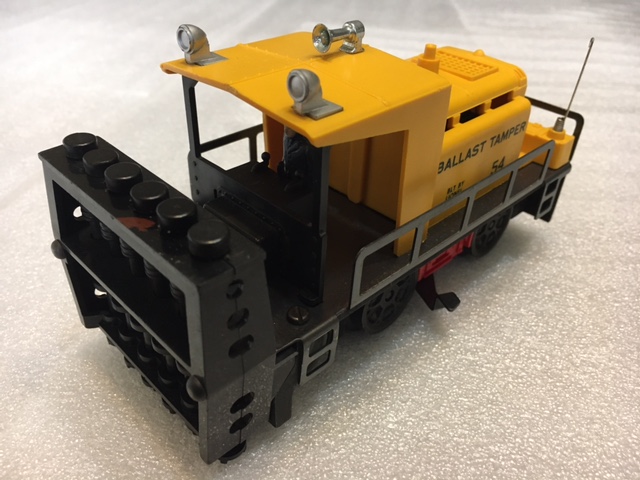
“#54 Ballast Tamper with Black Tamper bars and a Black Housing unit for the tamper bars with Black Heat-Stamped Lettering”
Now I am going to turn to ballast tampers produced after the Lionel Postwar years. There was only one ballast tamper manufactured during the MPC era and 4 produced during the LTI era. The MPC Ballast Tamper was the #8578 Ballast Tamper. It was sold and produced for only two years (1985 and 1987). The road name on the only MPC manufactured ballast tamper was NYC (New York Central). It was different in three other ways. First, it was numbered #8578 (heat-stamped); secondly, it had a black housing unit for the gray plastic tamper bars (not red tampers); and lastly, it had a maroon front control panel instead of a black front control panel.

“#8578 Ballast Tamper with Gray Tamper bars and a Black Housing unit for the tamper bars, Maroon front control panel and Black Heat-Stamped Lettering”
As previously mentioned, there are 4 ballast tampers produced during the LTI era. However, it is noteworthy to point out that the design of all of the LTI ballast tampers was significantly different than the postwar #54 Ballast Tamper. They operated using modern electronic technology. The LTI ballast tampers had an ON/OFF switch (usually under the bottom), they were transformer controlled forward, neutral, and reverse operation (remember, Postwar ballast tampers operated forward ONLY), had a traction tire for operation and a single crew multicolored figure. The LTI tampers had four reciprocating tampers. To operate the tampers, it required swinging the latch from the tamper switch and then slide the ON/OFF switch to the ON position. When you don’t want the tampers operating, you must slide the switch to the OFF position to turn off the tampers. The LTI ballast tampers do NOT use trackside trips that were used by Postwar ballast tampers.
The first of the four LTI ballast tampers was the #18483 “C & O” Ballast tamper. It was manufactured and distributed for only one year in 2004. It had a yellow die-cast body with a black roof and black rear panel. “M of W 48” and “C & O” were heat-stamped on the side. It also had a black roof with a large number “48” heat-stamped in yellow. The rear panel roof top was also painted black. There is also silver exhaust piping on left side as well.

“Front View of #18483 Ballast Tamper showing the four yellow plastic reciprocating tampers with a black roof and a large 48 heat-stamped in yellow”

“Side View of #18483 Ballast Tamper showing black stamping and silver piping and silver exhaust pipe on the side.”
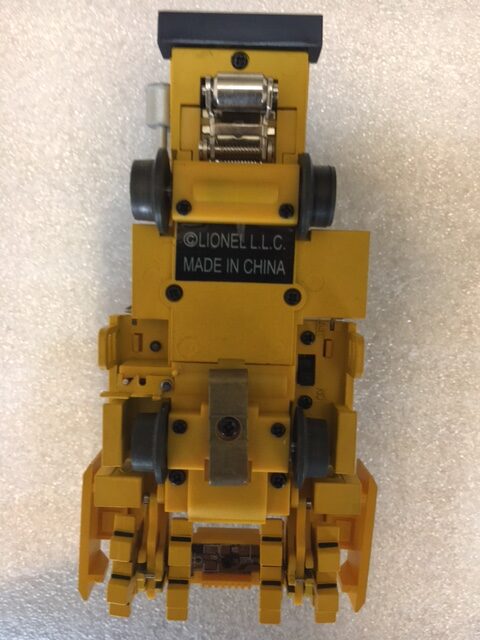
“Bottom View of #18483 Ballast Tamper showing the traction wheel and the four yellow plastic reciprocating tampers.”
The second of the LTI ballast tampers is the #18490 “Union Pacific” Ballast tamper. It was produced both in 2004 and 2005. It also had a yellow painted die-cast body with yellow roof, black lettering on the side and the “UP” multicolor decal on the side. It has silver piping and silver exhaust pipe on the side.
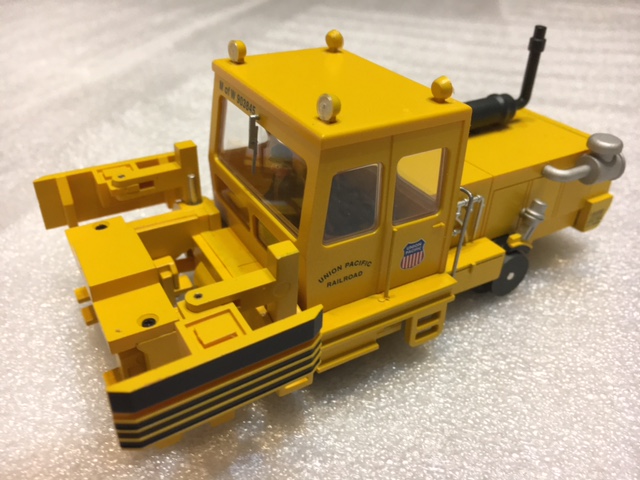
“#18490 Union Pacific Ballast tamper with yellow painted die-cast body and “UP” decal on side.”
The third of the LTI ballast tampers is the #18491 “M of W 325” Ballast tamper. It was offered for sale only in 2004. It had a yellow painted die-cast body with a black only painted cab roof. It had the traditional multicolor operator in the cab and the silver piping and silver exhaust pipe on the side.
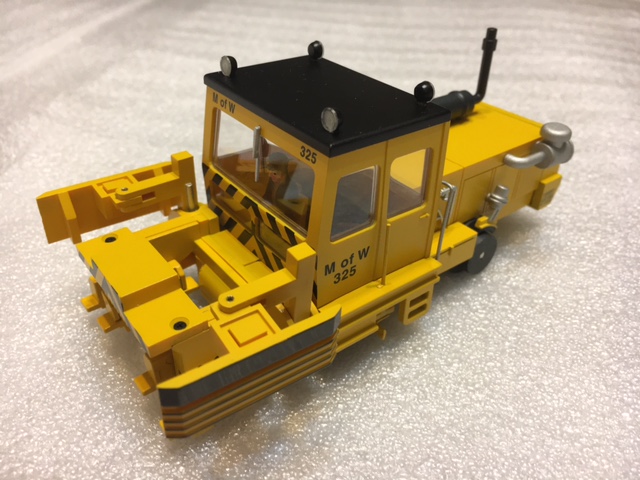
“#18491 M of W 325” Ballast tamper with yellow painted die-cast body and a solid black (no number) cab roof.”
Finally, the last of the four LTI ballast tampers is the #28403 Pennsylvania Railroad Ballast tamper. It sold in both 2005 and 2006. It had a silver painted die-cast body with a black only painted cab roof. On the side, it had “M of W 18”, “PRR symbol,” with “PRR” painted black lettering. On this tamper, the piping and exhaust pipe on the side were all painted black.
All Lionel operators will have lots of fun running either the postwar or LTI ballast tampers. They are full of action, create focused attention on operating layouts and certainly enhance the fun of operating your layout!
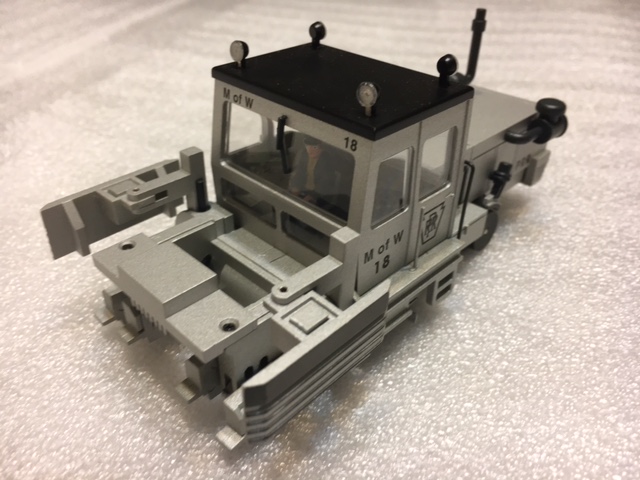
“#28403 Pennsylvania Railroad Ballast tamper with silver painted die-cast body and a solid black (no number) cab roof.”
April, 2022
Welcome to Jerry’s Collector’s Corner:
Today’s feature: #6464-1 Western Pacific Boxcar
For almost all operators and collectors, operating Postwar boxcars are really a lot of fun. However, for collector’s, the challenge to acquire and collect Postwar boxcars are among their favored activity for many hobbyists. Everyone is aware that Lionel produced many boxcars during the 24 years of the Postwar era (from 1946-1969), but special attention is given to collecting what is referred to as the “Series of 6464 boxcars”.
The Lionel company specialized in producing this famous series of 6464 boxcars which began in 1953 and lasted for the final 17 years of the Postwar era. Even today, many collectors are refining their collections by seeking to obtain as many of the 6464 series variations as possible. In fact, some collector’s truly focus on collecting the entire series of 6464 boxcars.
The first boxcar of the 6464 series is today’s feature: the #6464-1 Western Pacific Boxcar. This boxcar was initially manufactured in 1953. The Lionel Corporation produced four different road names during their first year of production for the 6464 series of boxcars in 1953. This article will examine the three major variations of the Western Pacific road name. The other three road names initially produced in 1953 were the “Great Northern”, “Minneapolis & St. Louis” and the “Rock Island”. These three road names will be featured in their separate articles at a later time.
There were three primary variations of the #6464-1 Western Pacific Boxcar. One of the three variations is relatively common to acquire, but the other two variations are very challenging for collectors to find, especially in a “Like New Plus” or “MINT” condition. That is due to the fact that this boxcar was entirely painted a bright silver. The acrylic silver paint was truly the most difficult color for collectors to acquire in any postwar car since it is so easy marked up. The quality of the silver paint actually improved during the “LTI” train period. But during the Postwar period the silver acrylic paint was not perfected as well and the oils on your hands and fingers would leave a permanent mark on the silver. It could not effectively be cleaned, polished or shined without leaving a mark. It was predominantly only the silver paints that were affected. “Other colors could be cleaned with mild soap or even rub off the dirt with water in order to improve the appearance of the original painting of the cars, but NOT true for silver painted cars.”
The most common 6464-1 Western Pacific variation was painted a bright silver, with blue heat stamped lettering, silver painted single-block doors, with a brake wheel and bar-end trucks with magnetic couplers. This variation is usually referred to in most price guides as the Type III variation.

“#6464-1 Western Pacific Boxcar, Type III, Rarity rating – 3.”
Interesting that the blue heat-stamped number on this boxcar was ONLY stamped “6464”, NOT “6464-1”. Neither the boxcar or the traditional blue/orange carboard box was stamped with a -1. However, this boxcar is always cataloged as “6464-1” Western Pacific Boxcar.
Here is a chart to easily refer to the primary 3 variations of this 6464-1 boxcar:
Type I Interior roof ribbed Blue HS Lettering Rarity rating – 7
Type II Interior roof smooth Red HS Lettering Rarity rating – 8
Type III Interior roof smooth Blue HS Lettering Rarity rating – 3
Not only is Type II of the 6464-1 Western Pacific boxcar RARE, it is considered by many collectors to be one of the RAREST boxcars in the entire Postwar era. Most collectors would agree it is within the top FIVE rarest of all boxcars in the Postwar era.
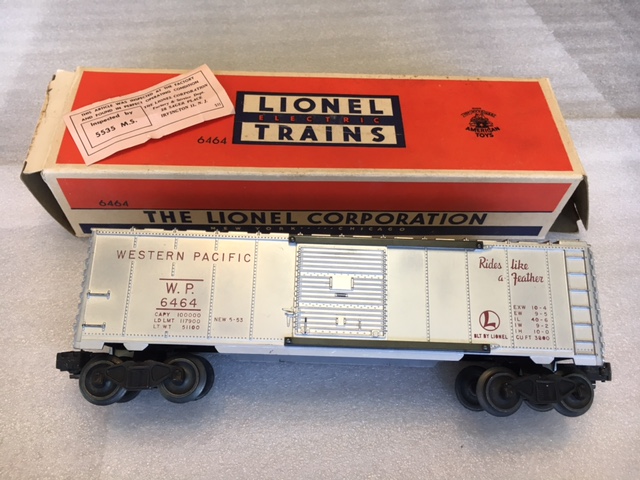
“#6464-1 Western Pacific Boxcar, Type II, RED heat=stamped lettering. Rarity rating – 8.”
Please note: The external appearance of both Type I and III are identical, the only difference is the ribbing on the interior of the boxcar roof (and the rarity rating). Both are painted bright silver with Blue heat-stamped lettering.

Ribbed Interior Roof Variation
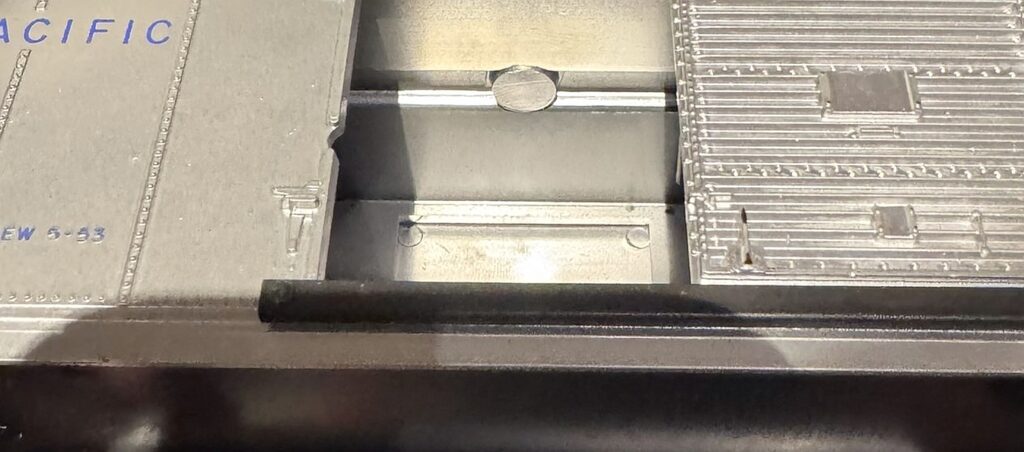
Smooth Interior Roof Variation
Please note: It has been acknowledged that there is a Type IV variation. Its external appearance is also identical to the Type I and III variations, but has a Type IIa body. (Not pictured)
March, 2022
Welcome to Jerry’s Collector’s Corner:
Today’s feature: #1615 and #1625 0-4-0 Steam Locomotive Switchers
Two of the smaller steam switchers made by Lionel during the Postwar era were the #1615 0-4-0 and the #1625 0-4-0 steam locomotive switchers. Both of these switchers were “0-27” gauge steam switchers and were made for a very limited period of time. The #1615 was produced only for three years from 1955 thru 1957 and the #1625 switcher was made for only one year in 1958. While the value of both of these smaller type switchers are similar, the #1625 production of one year makes it more difficult to locate, especially in a quality LN+ or MINT condition.
The biggest concern with operating these switchers is their smaller size and they are somewhat top heavy (as they have a high center of gravity and often derailed when operated, thus causing damage to their marker lights and their marker sockets). Thus, many of these switchers are found in damaged condition if they have been operated a lot. That is why when finding quality small switchers in good condition is very highly desirable by both operators and collectors.
Both of these switchers were produced with a three-position E-unit, working headlight with lens, wire handrails and a front coupler surrounded by a sheet metal step.
The main difference between these two smaller switchers is that the #1615 has an operating front coupler, the #1625 has a fixed plastic coupler on the front. Both of these switchers have a black-painted die-cast body with either white heat-stamped or rubber-stamped lettering. Most reference guides indicate that there is not a difference in their value with regards to whether the cab number was heat stamped or rubber stamped. The #1615 switcher also was produced with metal trucks (as that was NOT the case with the #1625 switcher).

“#1615 Black Die-cast Switcher with front operating coupler and #1615T plastic Slope-back Tender”
As noted in the picture above, the #1615T Slope-back tender has a plastic body (not like the die-cast engine cab). It also came either with white hot stamped lettering or white rubber stamped “Lionel Lines” lettering. There is no difference in value due to the type of stamping, but there is a preference to find a slope-back tender with hot stamped lettering. In addition, the #1625 tender had “AAR” trucks.
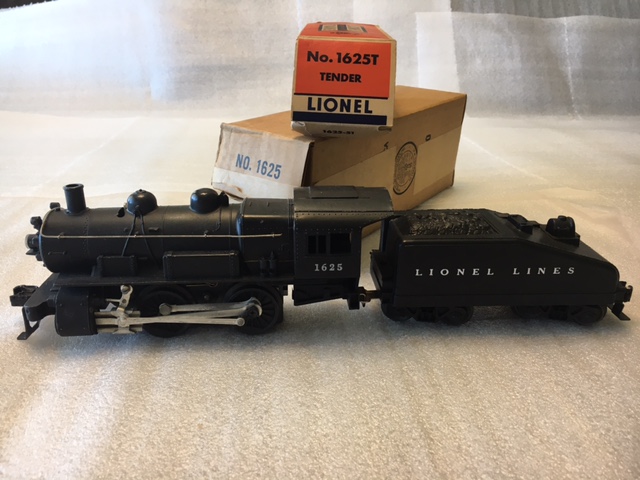
“1625 Black Die-cast Switcher with a fixed front coupler and #1625T plastic Slope-back Tender”
Next, I would like to point out another feature that is different about these two smaller switchers. Both the #1615 and #1625 switchers have a RAISED “B6” on the right side of the boiler casting. This is an unusual feature that is also found on the boiler casting of the #1656 and the #1665 switchers. Lionel used the “B6” designation to refer to the Pennsylvania Railroad’s most successful class of switchers built by Altoona Works. The Baldwin boilers were built from 1902-1912 (B6). Historically, the B6 had the Pennsylvania’s trademark square-shouldered Belpaire firebox and 56-inch (1.422m) drivers. They were constructed as saturated steam engines, rebuilt with superheaters later known as class B6s, and had Piston valves and Stephenson valve gear.

“RAISED “B6” on the right side of the die-cast boiler”

#1615 and #1625 switchers with their Slope-back plastic tenders”
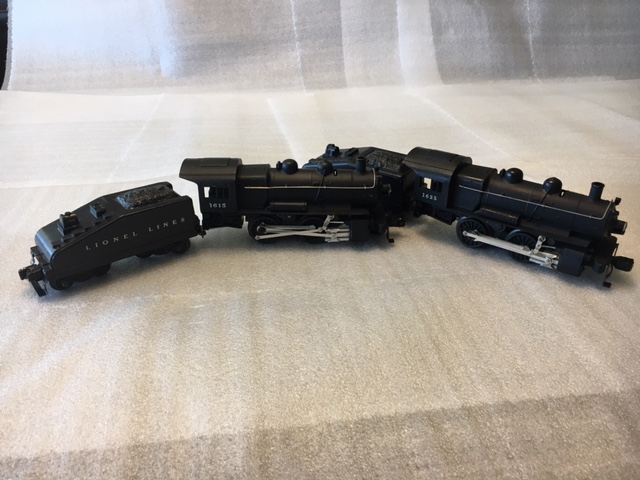
#1615 and #1625 switchers viewed together from their right side of the boiler”
February, 2022
Welcome to Jerry’s Collector’s Corner:
Today’s feature: “#2349 Northern Pacific EMD GP9 Road Switcher”
One of the most colorful and truly stunting looking “027” Gauge switchers is the #2349 Northern Pacific EMD GP9 Road Switcher. It was produced by Lionel for only two years, 1959-60. It was primarily painted black with a soft tone painted feature and had a brilliant painted gold ends and this was separated by a red-painted stripe The purpose of the narrow red painted stripe was to separate the radiant gold painted ends from the black areas of the main cab. The road name and numbering of the switcher were both heat-stamped in gold lettering.
A unique feature of this GP9 road switcher was the red painted “RADIO EQUIPPED’’ lettering with the electrical charging bars above and below the red lettering. This lettering/symbol was only found on this one GP9 road switcher. It was located on the short hood behind the cab. This lettering was also heat-stamped.
This switcher came with MagneTraction, an operating horn as well as an ornamental horn on both sides of the cab and operating headlights at BOTH ends of the switcher. Underneath the brilliantly gold painted sheet metal frame was a simulated black (unpainted) plastic fuel tank. A level-down three position E-unit is also found under the sheet metal frame.
There were operating couplers on both ends and the black plastic pilots has four steps molded on each end and on both sides.

“#2349 Northern Pacific EMD GP9 Road Switcher w/MagneTraction, build in 1959-60”
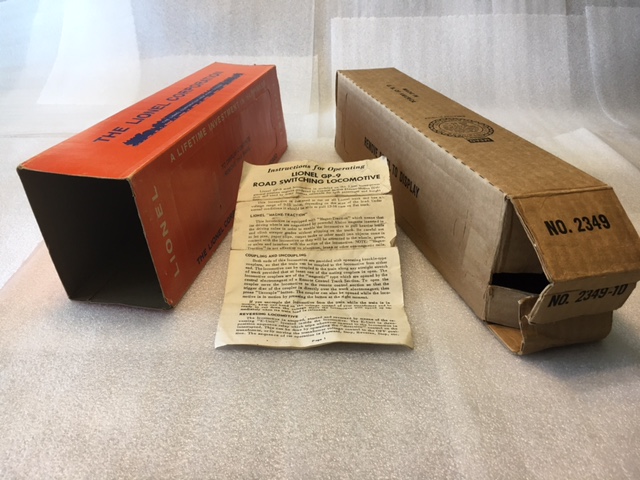
“Original 2349 cardboard box, w/original Orange Sleeve” and original instruction sheet
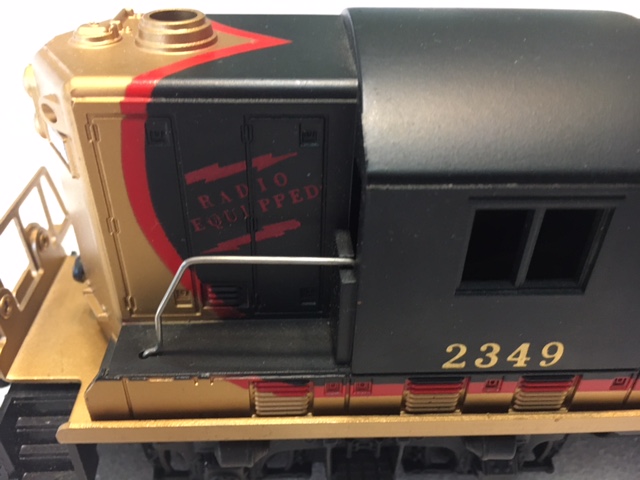
“Close-Up picture of RED lettering of RADIO EQUIPPED & electrical charging bars symbol on short hood behind the cab”
Now I would like to share with you the PROTOTYPE of the Lionel #2349 Northern Pacific EMD GP9 Switcher. This prototype was obtained from the Lionel Archives.
It was painted black and gold on a gray plastic shell. The red stripe is painted on the body. The lettering and numbers are decals. As shown in the 1959 Advance catalog, the words “Radio Equipped” are not on the short hood, this only occurred on the production models. This prototype locomotive has a gold painted frame. Obviously, it is “one of a kind” but does illustrate the thinking of Lionel for the mass production of this GP9 road switcher. There are no other significant differences between the prototype produced and the regular production models that were manufactured for the two years.
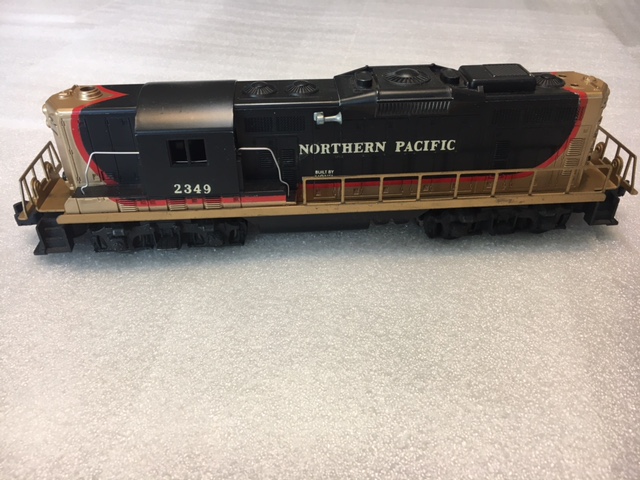
“#2349 PROTOTYPE of the Northern Pacific EMD GP9 Road Switcher”
January, 2022
Welcome to Jerry’s Collector’s Corner:
Today’s feature: “#3530 Electro Mobil Power Operating Generator Car”
One of Lionel’s unique operating cars is known as the #3530 Electro Mobil Power Operating Generator Car. No other operating car produced by Lionel during their 24 years of the Postwar period was as different, unique or similar to the #3530 operating generator car. This car was produced only three years, which was from 1956 to 1958. There are FIVE major variations of this car, four of which were quite common and then there was a Fifth variation that is totally unique, highly sought after by both operators and collectors alike and has a Rarity Rating of an “8”.
I will first describe and detail the four different common variations which we will call Type I thru Type IV. The #3530 operating generator car always came in an unpainted blue plastic with a painted white stripe along the side. All of the white lettering was heat stamped with blue heat stamping on white and white heat stamping on the blue plastic. The two major differences of the four common variations were the length of the painted white stripe along each side of the car and the color of the fuel tank located underneath the boxcar. Below is a chart of these two differences and a listing of the four variations for your perusal:
Type Length of White Stripe Color of Fuel Tank
I Full stripe thru ladder Blue tank & blue pole base
II Full stripe thru ladder Black tank & black pole base
III White stripe ends at ladder Blue tank & blue pole base
IV White stripe ends at ladder Black tank & black pole base
The #3530 operating generator car had sliding double doors on both sides of the boxcar, a black brake wheel, an orange generator inside the car (similar to the orange generator found on the #3520 and #3620 flatcars) and has a fuel tank on the underframe of the boxcar (either blue or black) and came with bar-end trucks.
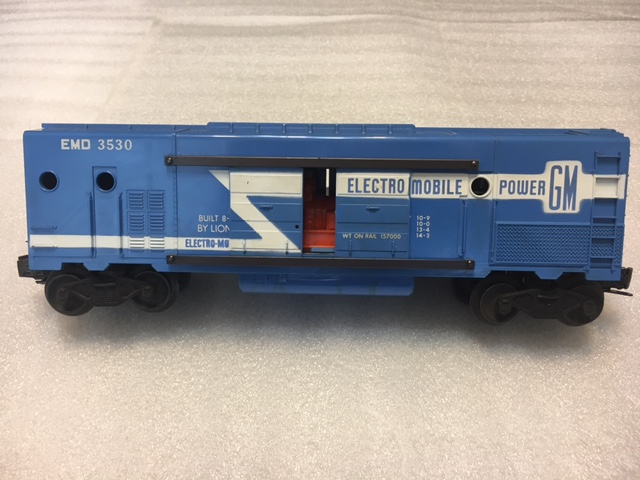
“#3530 Generator Car, Type I, with full white stripe and a blue tank under the frame of the boxcar”
You will notice that each side of the generator car is molded differently. Opening the door on one side of the boxcar doubles as an on-off switch which will complete the electrical circuit for the accompanying searchlight assembly and light the interior of the car, turning on the simulated fan inside the car and supplying power to the wood pole and floodlight (when connected). This generator car provides realistic action on a layout and many times is connected to a siding in a layout so the light can be turned on or off independently of the operation of trains on the layout.
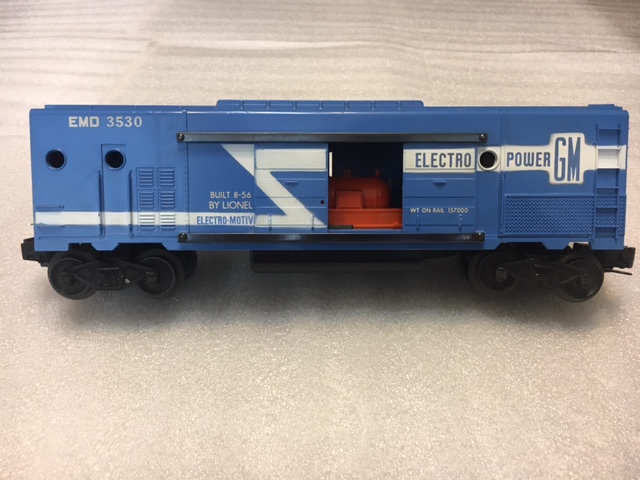
“#3530 Generator Car, Type II, with full white stripe and a black tank under the frame of the boxcar”
Next are Types III and IV which shows the #3530 Generator Car with the white stripe ONLY reaching up to the ladder on the side of the car, but without passing through it. Known as the “Short Stripe Generator Cars,” these types are not as desirable for either operators or collectors. As indicate in the chart above, Type III has blue fuel tanks under the frame of the car while Type IV has black fuel tanks underneath the boxcar.

#3530 Short Stripe Generator Car, Type III with blue fuel tanks underneath and Type IV with black fuel tanks underneath the operating generator car”
It is most common to find Type III cars to have both a blue tank and blue pole-base unit and Type IV cars to have both a black tank and black pole-base unit.
Now we come to the #3530, Type V, EXTREMELY RARE Operating Generator Car. As previously indicated, this postwar boxcar has the highest rarity rating of all! This generator car has the lettering and number “EMD 3530” underscored. Please view the pictures below. Mechanically and operationally, the car is the same as the first four types, but it is simply the fact that so few of them had the underscore.
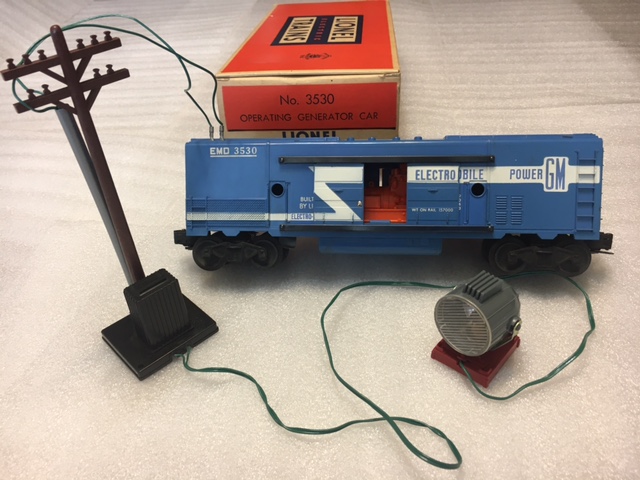
“RARE #3530 Generator Car, Type V, with “EMD 3530” underscored in white”
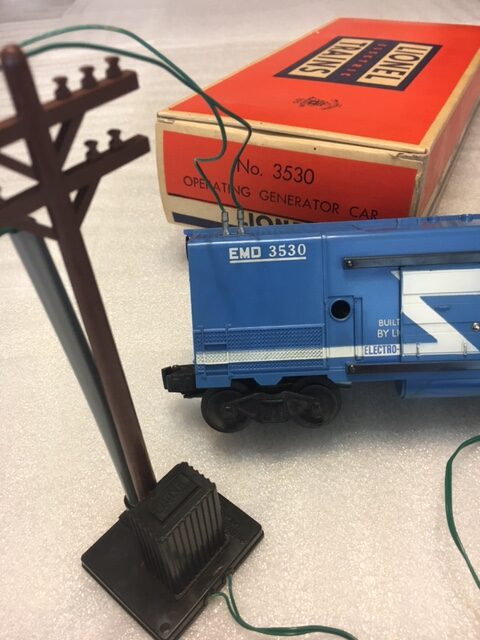
“Close-up view of RARE “EMD 3530” hot stamping UNDERSCORE
NOVEMBER 2021
JERRY’S COLLECTOR’S CORNER
“The #614 Alaska Railroad Switchers”
One of the more interesting and specialized theme Lionel Postwar switcher is the #614 Alaska Railroad Switcher, which was manufactured only for two years in 1959 and 1960. This is easy to remember, because the Alaska Railroad switcher was first produced in the year 1959, the year the state of Alaska was granted statehood and admitted to our country as the 49th state of the union. (Hawaii was admitted as the 50th state and added to our flag in 1960.)
This NW-2 switcher was quite a different looking switcher as compared to all of the other 12 NW-2 switchers like the #600, #601, #602, #610, #611, #613, #616, #617, #621, #622, #623, and #624, which were all produced by Lionel during the Postwar era. Its distinctively different appearance was due to the addition of a bright yellow plastic simulated dynamic brake housing and large “torpedo tube” air reservoirs added on the roof of the long switcher hood.
This Alaskan switcher body was painted blue and came with the yellow heat-stamping lettering, which also matched the yellow plastic of the brake housing and air reservoirs on the top of the roof of the switcher. As indicated above, no other NW-2 switcher had this housing attached to the switcher. In addition, the “Alaska Railroad Eskimo logo” was also heat-stamped in yellow on the cab of the switcher.
This #614 Alaska Railroad switcher was the first of many train cars produced during the postwar era featuring the Alaskan theme. In fact, some collectors have a major subset of Alaskan railroad cars in their collection. During the MPC era, many additional Alaskan themed railroad cars were produced and has resulted in a significant subset for a railroad collection for many train hobbyists. (See the last photo in this feature article to display how neat and growing of a railroad subset with the theme of “Alaska” makes for both collectors and operators.)
Type I – #614 Alaska Railroad Switcher
The first of the two #614 Alaska Railroad switcher’s produced is known as the Type I. It is extremely RARE and has a Rarity Rate of a 7 (on a scale of only 1 to 8).

“#614 RARE Type I Alaska Railroad Switcher”
What makes this switcher so RARE is that the placard near the nose of the switcher (on both sides) is OUTLINED IN YELLOW. The outlining around the edge of the “BUILT BY LIONEL” placard and the lettering itself is crystal clear with NO spillovers or yellow markings anywhere else around the outlined placard. Potential forgeries can be obvious if an attempt is made to try to paint the “Built By Lionel” placard or the outlining edge around the lettering in yellow.
Again, let me emphasize, THIS ALASKA RAILROAD SWITCHER WITH THE PAINTED EDGE AND LETTERING OF THE “BUILT BY LIONEL” is EMTREMELY RARE!!! Take a careful look at the following two pictures of the RARE Type I “Alaska Railroad” switcher and note the clarity of the yellow hot-stamped lettering on the placard.
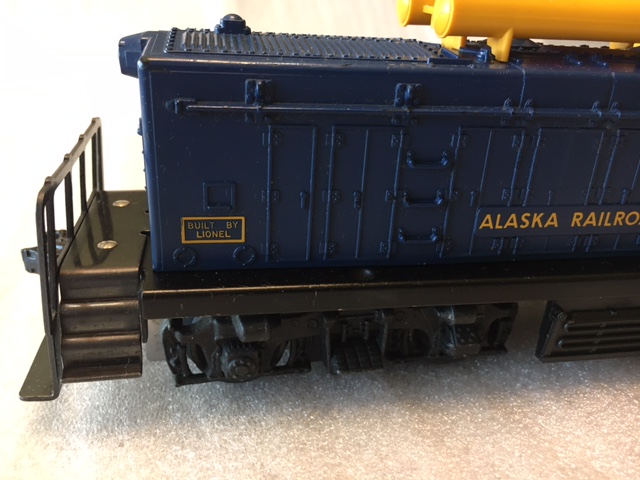
Left front of #614 Alaska Switcher with yellow placard

Right front of #614 Alaska Switcher with yellow placard
Type II – #614 Alaska Railroad Switcher
Next, we are going to examine the common variation of the #614 Alaska Switcher, which is known as the Type II, “#614 Alaska Railroad” switcher. Obviously, the “Built By Lionel” is NOT outlined in yellow. The rest of the switcher is identical to the Type I variation.
The majority of the #614 Alaska Switchers produced were the Type II variation. Both variations had a simulated fuel tank mounted under the frame and came with a non-operating self-centering coupler which was mounted on the rear of the switcher. In addition, a non-operating self-centering non-operating couple was place at the front of the switcher. The #614 Alaska switcher had single-axle Magnetration, it was lighted and finally came with a lever-up two-position E-unit.
Finally, as promised early in this feature, above is a picture of the Type I Alaska Railroad switcher and several of the many Alaskan cars produced by Lionel during both the Postwar and MPC production periods for your review and excitement.
OCTOBER 1, 2021
The FOUR Postwar #6517 Bay Window Cabooses are highly sought after and desired by most Postwar Lionel operators and collectors. These special bay window cabooses are a pride to add to everyone’s postwar collection, including the often cataloged #6517/1966 TCA Bay Window caboose (which will be described later in this article). This is one of an extremely few cataloged convention cars that is usually listed and described in most Postwar collector’s guides.
Type I, #6517 Bay Window Caboose:
The first two types of the #6517 Bay Window Cabooses were made for five years from 1955 thru 1959. The first type of the freshly produced Bay Window caboose had a red-painted body (on black plastic mold) with white rubber-stamped lettering and rode on ”0-27 gauge” passenger type car trucks. This caboose was illuminated and came with a clear window shell.
What is really unique for these #6517 Bay Window cabooses is that they contain a black cardboard insert on both sides of the center (only) bay window within the window shell which helps illuminate this car when it is operated.
It is really neat to run and it is distinctively different than any other operating caboose produced by Lionel during the Postwar era. The two window frames on both sides of the center window frame DO NOT have these blackout cardboard inserts, but remain clear. To my knowledge, this uniqueness has never ever been highlighted in ANY model train pricing guide.
In addition, this caboose also came with a smokejack, which was newly created by Lionel for this originally designed bay window caboose. There were sheet-metal ladders attached to the end of the platform metal base which also included molded plastic steps and end platform assemblies.
What is unique and special about this Bay Window caboose is that it came with a DOUBLE UNDERSCORING beneath the “BLT 12-55” and “Lionel” which were heat-stamped in white (see second picture below).
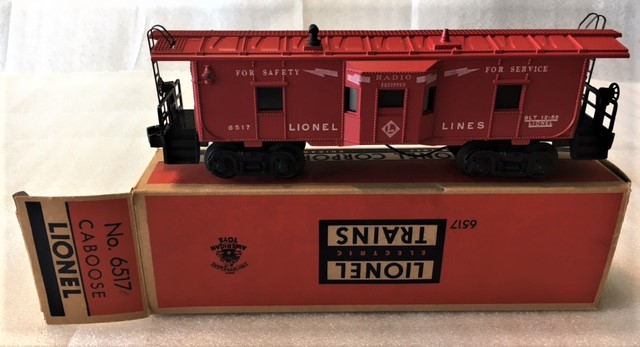
“6517” Type I “Lionel Lines” Bay Window caboose w/Double Underscoring of the Build Date
Take a look at the below picture with the heat stamping build date in the lower right hand portion (last panel on right) of each side of the bay window caboose.

Close Up Photo of DOUBLE UNDERSCORING on right side of Type I #6517 Bay Window Caboose
Type II, #6517 Bay Window Caboose
The second type was identical to the first type except the double underscoring of the build date was eliminated. Obviously, the Type I Bay Window caboose has a higher rarity rating and is more expensive to collect.

“6517” Type II “Lionel Lines” Bay Window caboose with NO underscoring of the build date
Type III, #6517-75 “Erie” Bay Window Caboose
This bay window caboose was produced one year only in 1966. Because it was only produced for one year and is uniquely designed, it is also the most valuable of this bay window series. It had a rarity rating of a “7”.
Like its predecessors (#6517 Type I and Type II as previously discussed), it was painted red and the rubber-stamping was white lettering. Two variations of red painting were used on the production of these bay window cabooses, one had a darker red.
This bay window was numbered by Lionel as the #6517-75 bay window, but was numbered “C301” in white lettering on the sides and stamped #6517 on the underside of the frame.
Finally, this car came in a window box and it was stamped “6517-60” on the end flaps in black. This window box is hard to find and adds value to the bay window caboose if purchased together.
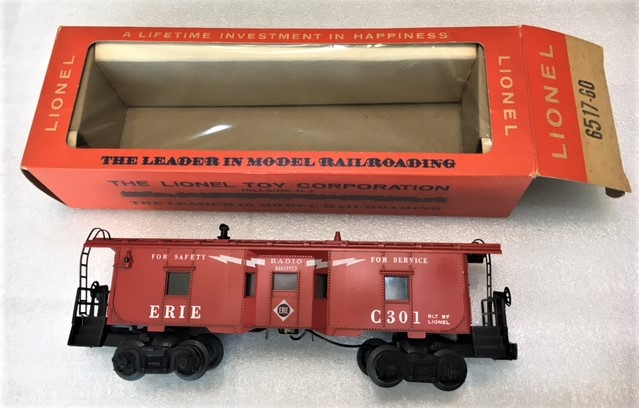
“6517-75” Type III “Erie” Bay Window caboose and window box
#6517/1966 TCA National Convention Bay Window Caboose
Finally, the 4th and last bay window caboose in this series. It was manufactured only in 1966 for the TCA convention held in Santa Monica, California. This bay window was painted orange and came with white rubber stamping. There was no double underscoring on the build date on this car. This bay window came in a window box also numbered “6517-60” in black. This bay window convention caboose is highly desirable when complete with its original window box. Lionel postwar operators and collectors both enjoy collecting and operating this illuminating bay window caboose.
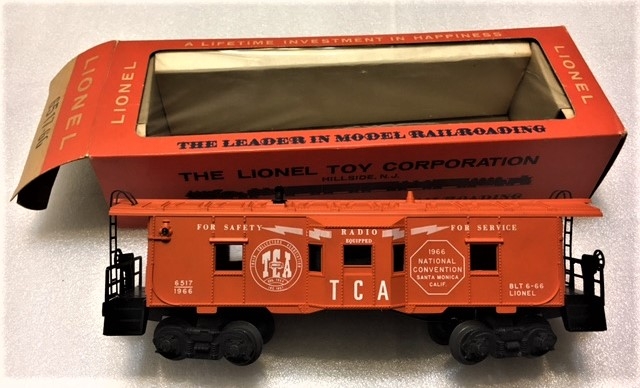
“#6517/1966” Orange TCA National Convention Bay Window Caboose and window box
SEPTEMBER 1, 2021
TODAY’S FEATURE:
The “New Haven Boxcars”, 6464-425 and 6464-725 Boxcars
Most operators and collectors of Lionel Postwar trains know that the series of “6464” boxcars is highly cherished and many collectors seek to obtain the entire series for their collection. There are more than 32 major variations in the “6464” series, and if you include all of the various types described in the many different collector’s guides, the number of possible variations significantly increases.
That is true for the two series of “New Haven” 6464 series boxcars. We are going to examine (and present a picture of) the four most popular types and those that were manufactured in significant numbers. In addition, another 4 types will be described for your information and this will assist those collectors seeking to have as many variations of the “6464” series boxcars in their collection as possible.
There were two distinctively numbered series of “New Haven” boxcars. The first series was numbered “6464-425” which had two major variations and were produced from 1956 to 1958 (3 years). Both of these variations had an unpainted black plastic body and the interior of the roof was smooth (not ribbed), Type 2 body mold and they came with unpainted orange plastic single tack doors. The obvious major difference between these two types was that the Type I “6464-425” had an “N” that was ONLY a half-serif on the very top right corner. The Type II “6464-425” had an “N” with a full serif in the logo (on the top right corner).
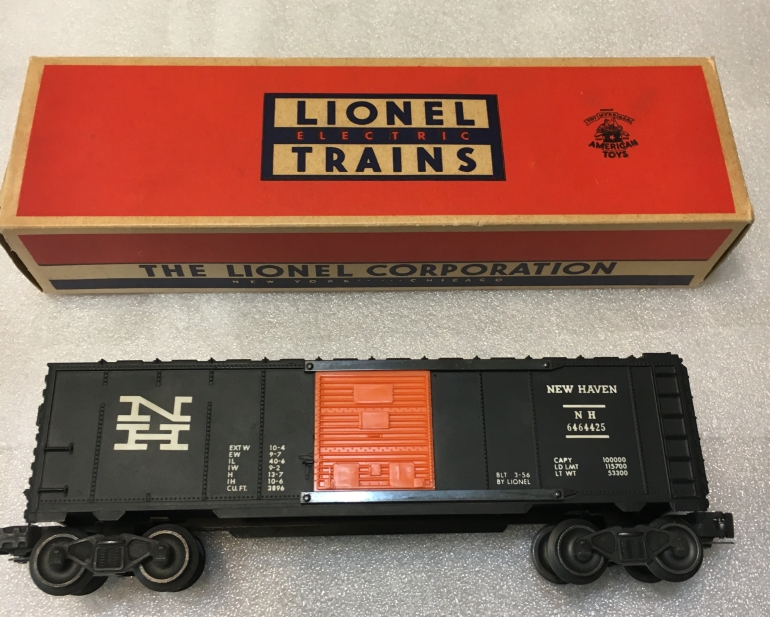
“6464-425” Type I w/half serif Logo
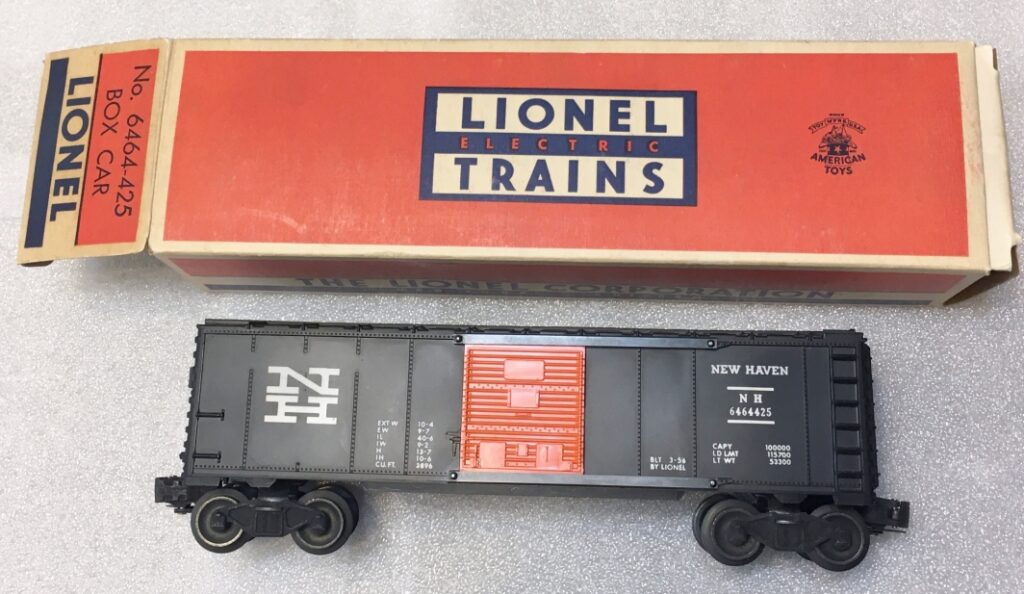
“6464-425” Type II w/full serif Logo
For information purposes, Lionel produced three other “6464-425” boxcars. See listing below for individual differences:
Type III – Matte-black painted body, smooth roof & half serif “N” in logo
Type IV – Matte-black painted body, smooth roof & full serif “N” in logo
Type V – Glossy painted body, smooth roof & half serif “N” in logo
Now we are going to take a close look at the “6464-725” series which also had two major variations as well. This series of New Haven boxcars were produced both during the 1962-66 production years and the 1968-69 years. The most common “6464-725” was painted either a light or medium orange. This boxcar contained a ribbed roof and had black hot-stamped lettering. It also had multi-tack board doors that were an unpainted black plastic. It came with AAR trucks and an orange picture window box.
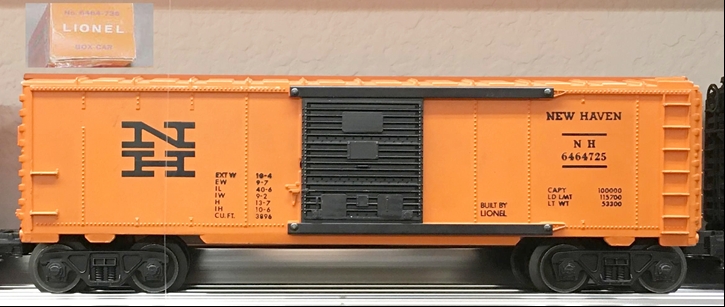
“6464-725” New Haven Orange boxcar with multi-tack doors, Photo courtesy of the Lyle Leverich Collection
The final “6464-725” New Haven Boxcar was an oddity. It was produced in 1969 only. It came with a black painted body, had orange multi-track doors, ribbed roof, and white hot-stamped lettering. This boxcar had bar-end metal trucks and magnetic couplers at both ends. However, most importantly it came with a Hagerstown (and sometimes Hillside Checkerboard original box).
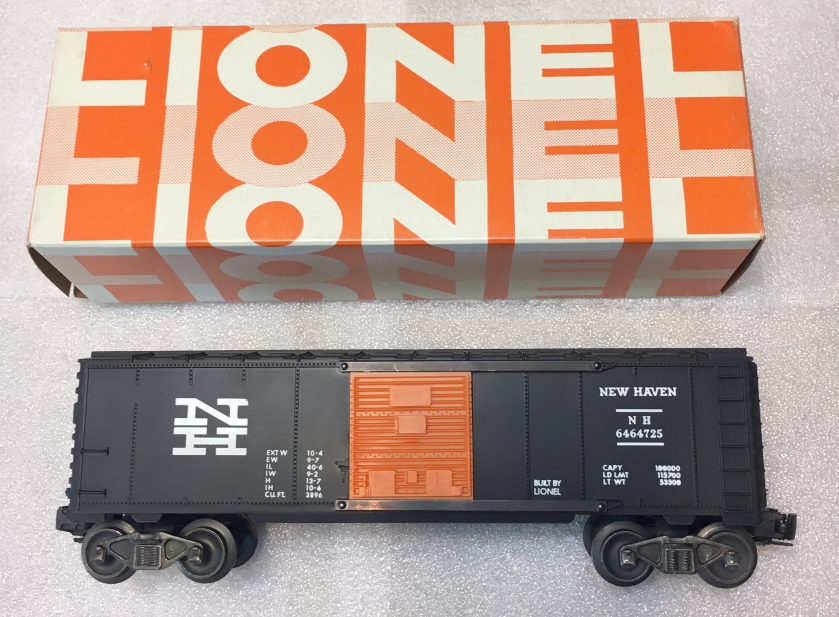
“6464-725” New Haven Boxcar with distinctively different Hagerstown original box
Again, for informational purposes, there was a third “6464-725” New Haven boxcar produced by Lionel. It maintained the medium orange painted plastic body, but had a glossy matte black lettering.
Good luck with your continued efforts to complete the exciting “6464” series boxcar collection. Many collectors note that sometimes Lionel mis-stamped some of the “6464” series boxcars. Sometimes lettering was completely missing on one side of the boxcar, build dates missing or a variety of other types of stamping errors were made and have been found. So, the number of varieties of “6464” boxcars vary and depends on the interest of the collector. If you want to add some of these mis-stamped boxcars to your collection or not, that decision is yours to be made. It is your choice, but have fun and happy hunting at the next train meet you attend or auction you participate in.
AUGUST 1, 2021
TODAY’S FEATURE:
#57 AEC SWITCHER (& THE TWO #57 PROTOTYPES (POSTWAR & MPC)
One of the most exciting and challenging subsets to collecting Lionel Postwar trains is the category known as “Motorized Units!” Acquiring and finding quality motorized units presents a distinct opportunity for both operators and collectors alike. There are more than 28 widely known variations of the numerous motorized units manufactured from 1954 all the way through to the end of the postwar period in 1969. (The last of the motorized units produced was the Ballast Tamper manufactured in the final year of Postwar trains in 1969). However, without question the most difficult and totally sought after motorized unit to find is a quality #57 AEC switcher. The Atomic Energy Commission switcher was made only two years from 1959 to 1960. This was a very popular switcher because it was manufactured at a time nuclear power plants were being designed and constructed throughout the county. In fact, these two years of production were during the famous “bomb shelter” hysteria building that was taking place in the United States. There was an exaggerated or uncontrollable emotion or excitement, especially among government officials to build protective bomb shelters for their citizens. Many bomb shelters were actually built and funded by many cities and counties in the country at this time.

#57 AEC SWITCHER WITH RARE ORIGINAL #57 LIONEL BOX)
Several factors make the #57 AEC Switcher the RAREST of the motorized units to add to your collection. These factors include BROKEN STRUTS, hairline stress cracks, low number of #57 switchers produced and limited demand for these switchers during the two years of their production. As you know, broken struts were unfortunately very common because these switchers were toys and many children (and adults) picked up the switchers “by their struts” and instantly broke them and thus greatly reduced their value. These switchers must ALWAYS be picked up by their trucks when moving the switchers or placing them on your layout tracks.
The #57 switchers were made as a replica of the 30-ton Vulcan switcher and was produced with an unpainted white plastic body and red painted cab sides. The cab sides came with a white stylized “AEC” logo which was heat-stamped below the windows. For the purist collectors (not operators), the degree of whiteness of the white plastic shell is critical. The whiter the plastic shell is, the more desirable and valuable the switcher becomes. To be totally candid, most of #57 shells look like a “cream color.” In fact, finding a totally white shell or partial unfaded white shell is very difficult and truly critical to the avid train collector. The reason so many #57 switchers have a cream color body shell is that the quality of the white plastic used by Lionel was poor as compared to the white plastic Lionel used when producing the #59 Air Force Minuteman switcher. Look at the difference of the two #57 switchers in the picture below
.
.

CREAM COLOR #57 SWITCHER ON THE LEFT, MOSTLY WHITE #57 SWITCHER ON THE RIGHT
The #57 switcher had an ornamental bell on top of the hood, all handrails were blued steel and the switcher came with TWO operating couplers. Also, very important is to collect a complete #57 switcher which includes a white-type shell, unbroken structs, complete original Lionel box, original instruction sheet and the cardboard insert.

DESIRABLE AND COMPLETE #57 SWITCHER
Next to examine are the TWO extremely RARE #57 switcher prototypes. The first one is the Postwar #57 switcher pictured below. Notice that its front coupler is missing and truly reflects the #57 switcher on page 15, of the 1959 Lionel Advanced catalog. See picture below and notice the artist rendition of the #57 switcher is a perfect match to the Postwar Lionel #57 prototype switcher. It just does NOT get better than this!

DESIRABLE AND COMPLETE #57 SWITCHER
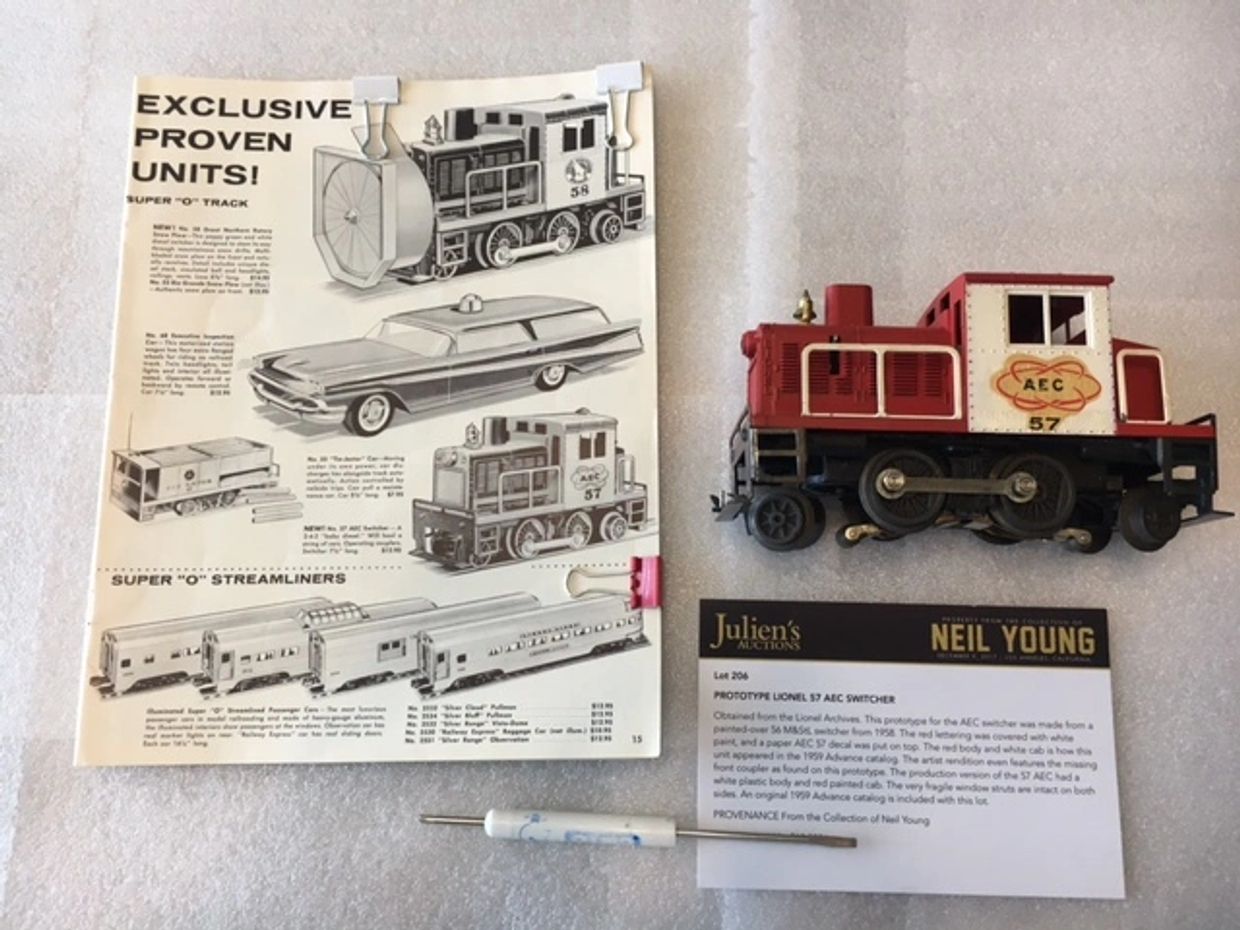
RARE LIONEL POSTWAR #57 AEC PROTOTYPE SWITCHER
Finally, below is the second #57 Prototype AEC switcher, but it comes from the MPC period. This prototype for the Postwar Celebration Series AEC-57 switcher is from the “The Lionel Corporation” archives. It was released in January, 2017, and comes with a silver painted cab, red painted sides and Numbered “OO”. The tag on this prototype switcher is Number 6-18583 AEC Switcher Prototype.

PROTOTYPE FOR THE POSTWAR CELEBRATION SERIES AEC 57 SWITCHER, # 6-18583
Enjoy operating, collecting and sharing your train collection with others. Model train collecting has been the fastest growing hobby in the United States! Take it one step at a time, focusing on collecting the Lionel postwar motorized units is fun and exciting!
JULY 1, 2021
TODAY’S FEATURE:
THE “HOLY GRAIL” OF THE F3 DIESEL LOCOMOTIVES
Both operators and collectors enjoy acquiring the famous “6464” series of Postwar Lionel boxcars, however, there is a special excitement in the location, acquiring and displaying of the F3 series of the Diesel Locomotives. While each quality F3 found and added to your collection is truly a special occasion for each operator and collector, each collector always seemed to have a particular challenge in finding at least one or two of the beautiful F3 Diesel locomotives. While I have been collecting Lionel Postwar trains for nearly 60 years (started when I was a very young child), the Diesel Locomotive that seemed to always evade my search and acquisition was the #2345 Western Pacific EMD F3 A-A units. The Silver twin #2345 Western Pacific A-A units for many and certainly for me are considered the “Holy Grail” of the F3 Diesel Locomotives!!!
While any quality F3 diesel locomotive is truly cherished, the reason there is such a tremendous challenge and desire in obtaining a quality #2345 F3 is due to the original silver color (paint) that Lionel used during the Postwar period. The #2345 is one of only three F3’s predominately painted with a majority of silver over the entire units. (The other two were the #2355 Western Pacific and the #2242 New Haven.) During the Postwar period, the paints used by Lionel were not as good as the paints during the MPC period (1970-1989) and the LTI period (1990 to present).
If you picked up one of the units of the #2345 Western Pacific, the oils from your fingers would permanently mark the shell, show a scar and/or leave a residue on the chassis. This is particularly true if the unit is a MINT shell. Trying to remove or rub out the fingerprint would ONLY make the situation worst. Most operators and collectors have NOT seen a truly MINT #2345 shell, because the MINT shells have a bright sheen (a soft luster on a surface) to the shells. In fact, the sheen is so bright, that at first train hobbyists think the shell is a repaint. In reality, it is not. The scary part about the bright sheen is that leaving the F3 shell exposed to ordinary room light on a train shelf or layout, turns the silver (with time) to a grayish color and eventually to a dark gray (and does not even appear to be silver anymore, but looks to be some type of a gray color). Below is a quality #2345 Western Pacific A-A unit for your examination.

#2345 WESTERN PACIFIC F3 UNITS CONSIDERED THE “HOLY GRAIL” OF THE F3 DIESEL LOCOMOTIVES
In addition to the bright silver and orange postwar paints, the #2345 Western Pacific were produced ONE year only in 1952. The A-A units had a wire mesh-type roof ventilators and clear hard plastic snap-in porthole windows. In addition, the die-cast pilot casting was also painted silver as well as the truck side frames and the locomotive frame itself. The F3 had two motors (horizontally mounted) and an operating bicycle horn and an operating headlight. What is really neat is that the dummy A unit also had an operating headlight.
Both A-A units have a pair of two-piece ornamental horns mounted on their roof, with clear window casting lens installed in the window slots and operating clear headlight lens for each unit. There were coil front couplers on each unit and both units also had a fixed rear coupler. The number boards had a clear plastic cast #“2345” with raised letters in the number boards
The doors were molded into the shell itself, but each unit had separate black plastic grab handles installed on the nose and had separately cast plastic ladders going from the cab doors down to the stamped steel steps. Yes, indeed, these A-A units had everything added to the shell, but with the famous wire mesh-type roof ventilators being the most distinguishing characteristic on these F3 shells was the key feature. This is always the first thing that collectors check out when comparing the #2345 and #2355 shells.

FRONT VIEW OF THE #2345 WESTERN PACIFIC F3 A-A UNITS
Both the “Western Pacific” nose herald and the ”GM” (black and white logos) were water-slide decals and were applied on the nose. The rarity rating is technically a “6”, but finding a MINT set of #2345 Western Pacific’s in my book would make this find with a Rarity rating of an “8”.
Next, let’s take a close look at the #2355 Western Pacific A-A F3 diesel locomotives. These F3’s has a Rarity rating of a “7” and were only produced for one year in 1953. The #2355 Western Pacific F3’s are very nice and desirable, but in truth, they are a less expensive and modified version of the previously #2345 just reviewed. As indicated above, the most noticeable differences are that the roof vents are now louvered and the nose-mounted grab handles on the #2345 models have been eliminated on the #2355 units. One noteworthy change was that the horn unit was moved from the powered “A” unit into the dummy unit with its operating headlight.
Like the #2345 units, the #2355 units had duel horizontal motors with two MagneTraction-equipped trucks. One other technical difference was how the shells were mounted on the frame. The “2355” units were mounted using a single screw in the front and a clip at the rear that snapped over the rear of the frame. The #2345 shells were held on with 3 screws on the frame and no clip in the back.

#2355 WESTERN PACIFIC A-A DIESEL LOCOMOTIVES, MADE 1953 ONLY
The “Western Pacific” logo on the #2355 shells were no longer a water decal, but was a black heat-stamped “GM” loco on the sides of the shell. Good news, the die-cast pilot continued to be painted a bright silver as did the chassis. The original #2355 Western Pacific used the very bright silver painted and truly is extraordinary difficult to find in either LN+ or MINT condition. However, they do show up, so don’t get discouraged. Happy hunting, after all, that is part of the fun as a train hobbyist. You never know what you are doing to find at the next train meet or next auction. Enjoy the train hobby, keep looking to upgrade as you attend train meets and keep in contact with your friends as they may lead you to the next great find for your F3 diesel locomotive portion of your collection!!!!

Master Carton for #2345 Western Pacific F3 Diesel Locomotives

Master Carton for #2355 Western Pacific F3, OB’s and original instruction sheet
JUNE 1, 2021
TODAY’S FEATURE:
THE FOUR “TEXAS SPECIAL” DIESEL SETS
In the 24 years of Lionel Postwar production, they made four different “Texas Special’s” Diesel Locomotives. Interesting enough, all four of these diesel locomotive sets were all “027” gauge! Although, most collector’s think of the last two diesel sets as F-3 “O” Gauge, but they were actually “027” Gauge locomotive sets. The “Texas Specials” are truly special for all Lionel Postwar collectors and operators. The diesel locomotive sets were not just special for Texans, but look at the eyes light up when a train hobbyists or collector finds a premium Texas Special set at a train meet. It is just simply something “Special!!!”
Here is a chart of the four different “Texas Special” Locomotive sets produced by Lionel for your review:
(1) #210 Alco “Texas Special” Diesel 1958 only
(2) #211 Alco “Texas Special” Diesel 1962-1966
(3) #2245 “Texas Special” F3 – Type I 1954 only
(4) #2245 “Texas Special” F3 – Type III 1955-1956
Let’s take a closer look at each of these four different “Texas Special” diesel sets. As noted above in the chart, the #210 Alco “Texas Special” was manufactured in 1958 and for only one year.
.
.

“#210 TEXAS SPECIAL ALCO SET”
“The Texas Special” was heat-stamped in red on the white painted stripe on the side and the white star on the nose was also in white and was heat-stamped as well. The powered unit included two-axle Magnetraction, a three-position E-unit and an operating headlight. This next picture shows the HS White star on the front nose of both the power and non-powered Alco units.
.
.

“FRONT VIEW OF STAR HS ON THE NOSE OF EACH ALCO UNIT”
The next “Texas Special” Alco unit manufactured by Lionel was the #211 “Texas Special” locomotive set produced the four years of 1962-1966. The exterior of the #211 locomotive set was identical to the exterior of the #210 set. However, the E-unit was the two-position type, the #211 had Magnetration on only one axle (as compared to the #210 set which was produced as indicated above with two-axle Magnetraction). This was one way Lionel saved some production costs when making the #211 set as compared to the #210 set. However, the #211 set did maintain an operating headlight.

“EXTERIOR OF THE #210 SET (TOP SET) WAS IDENTICAL TO THE EXTERIOR OF THE #211 SET (BOTTOM SET)”
For information purposes, Lionel did make a Type II #211 Alco set, which is NOT pictured here because the only difference was that Type II units totally lacked Magnetration and came instead with a traction tire. In these Type II, #211 units they had to install a ballast weight in order to further increase traction. These units did not operate as well and are not sought after by either operators or collectors.
Now we come to the most exciting “Texas Special” locomotive set of all and the one that truly excites both operators and collectors to add to their train collection. This is the #2245 “The Texas Special” F3 diesel locomotive A-B set.
.
.

#2245 “THE TEXAS SPECIAL” F-3 DIESEL LOCOMOTIVES A-B SET
This diesel set was made for only ONE Year (1954), it had a red painted die-cast pilot, silver painted trucks and side frames, operating horn, rear powered truck with Magnetraction and separately installed cab door ladders and included a pair of two-piece ornamental horns. In addition, on both sides of the A unit, it had an “MKT” and “Frisco” decals. However, the white Star on the nose was silk-screened (Not HS as was the case of the Alco Texas Specials). This F-3 had a single motor. The “B” unit had regular portholes with lenses. It is a beautiful “Texas Special” set and is truly desired by all operators and collectors alike. In my opinion, only the #2345 Western Pacific wire mesh-type roof ventilators F-3 demands more attention and excitement.
Next, we come to the fourth type of “The Texas Special” diesel locomotive sets made by Lionel which was manufactured for just two years (1955-1956). This is the #2245 “The Texas Special” F-3 A-B set, Type III. However, it is noteworthy to realize that this is the rarest “Texas Special” set of the entire postwar period. It has a RARITY RATING of a 7.
.
.

#2245 “THE TEXAS SPECIAL” TYPE III, DIESEL LOCOMOTIVE SET
This Texas Special set has a silver painted pilot, blackened side frames without steps and a “B” unit with closed portholes. If you are able to locate this Type III, Texas Special set with closed portholes in the “B” unit, you should plan to add it to your collection. This is quite uncommon and always demands a high price. Happy hunting at train meets, auctions and local train shops, because they are out there. These “Texas Specials” are exciting to find, but when located, it is truly critical that you give serious consideration to acquire it!
Here is a picture comparing the differences on the “B” Units of both the Type I and Type III #2245 Texas Specials.

Finally, we come to a picture of the #211, #2245 Type I and #2245 Type III “The Texas Specials” displayed together on a shelf and a set of “The Texas Special” aluminum passenger cars (made by LTI only).
.
.

CABINET DISPLAY OF POSTWAR LIONEL “TEXAS SPECIAL” SETS AND “TEXAS SPECIAL” PASSENGER CARS
MAY 1, 2021
TODAY’S FEATURE:
PRESIDENTIAL ALUMINUM PASSENGER
During the 24 years of Lionel Postwar trains, there are two major highly desirable and sought-after aluminum streamline passenger sets. The first one is the Lionel 1955 Congressional set #2254W which came with the 2340 Pennsylvania GG1. It had four aluminum passenger cars (2 pullman cars, a vista dome car and an observation car). The second extremely desirable aluminum passenger set was produced for three years from 1964 thru 1966 and was known as the Presidential Aluminum Passenger Set #12780 and is the feature of this article. It was produced with four aluminum passenger cars as well (one pullman car, 2 vista dome cars and an observation car and sometimes packed with 2 pullman cars, a vista dome car and an observation car). However, either way is truly desirable and represents about the same interest in acquiring for collectors. For informational purposes, there was a third aluminum passenger set produced by Lionel that was made in Super O Gauge and sold for only one year in 1963. This set was #13148. It also came with four aluminum passenger cars and the 2383 Santa Fe F3 AA units.
Pictured below is the Presidential Aluminum Passenger Set No. 12780.
.
.
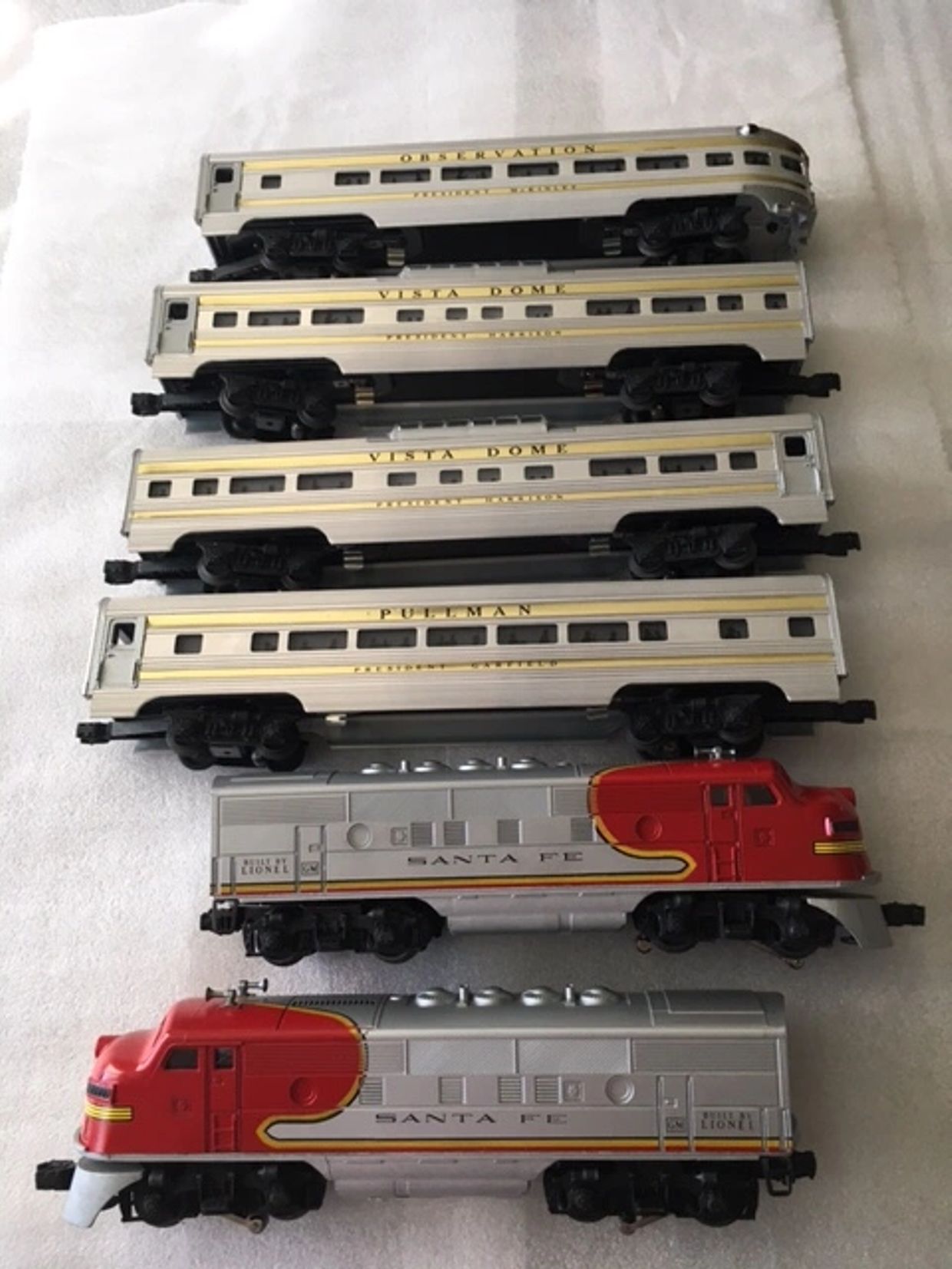
“O” GAUGE PRESIDENTIAL ALUMINUM PASSENGER SET No. 12780
This set consists of the 2383 Santa Fe F3 AA units, #2523 President Garfield aluminum Pullman car, two #2522 President Harrison aluminum vista dome cars and a #2521 President McKinley aluminum observation car. All of these aluminum cars have a flat-channel extruded aluminum body with paper-based decorative gold stripes with black lettering printed in the channels on the very shiny aluminum body. All four of these cars are illuminated. The condition of the gold stripes is critical to the value of the passenger cars. Damaged, scratched, torn or missing gold stripes will greatly diminish the value of each aluminum car. Like new+ or mint aluminum passenger cars bring a premium and are sought by Postwar collectors. Try to locate quality aluminum passenger cars for your collection as they will not only maintain their value, but will continue to go up in value.
Now let’s take a closer look at the #2383 Santa Fe F3 AA units.

These F3’s are painted in the extremely popular red and silver and in the desirable Santa Fe “warbonnet” scheme. These engines have black heat-stamped lettering, rooftop vents which are louvered rather than having wire mesh installed, portholes are molded closed and two one-piece casting ornamental horns on each engine shell. The cab door ladder is molded into the body rather than being separately installed like on the #2343 Santa Fe F3 AA units. The truck side frames are chemically blackened. Most importantly, these F3 engines are powered by twin vertical motors and have both an operating horn, operating headlight and MagneTraction. As a result, these engines are extremely powerful and easily pull the four aluminum passenger cars. The picture on the left shows a great view of the engine nose and the yellow/black front decal. The picture on the right illustrates the front silver painted pilot castings and the blackened truck side frames. (Special note: the truck side frames on the most popular #2343 Santa Fe F3 AA units are silver.)
Finally, this next photo shows the tops of the aluminum passenger cars and with their illumination, they are gorgeous when operated on a layout, especially at night.


Whether you are an operator or predominately a Postwar collector, the #12780 Presidential Passenger Set is one you want to watch out for at a train meet. Keep in mind, you are best served to find a passenger set that is at least Excellent+ or better. Happy hunting because having and running this passenger set is enjoyable. Savor your trains and have fun!!!
.
.



